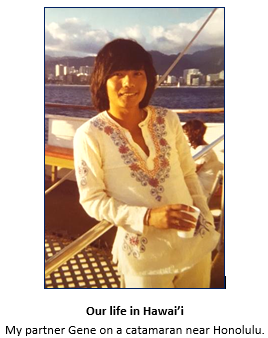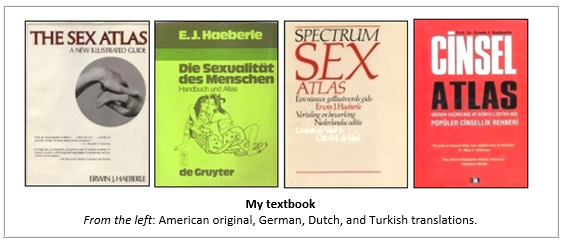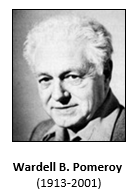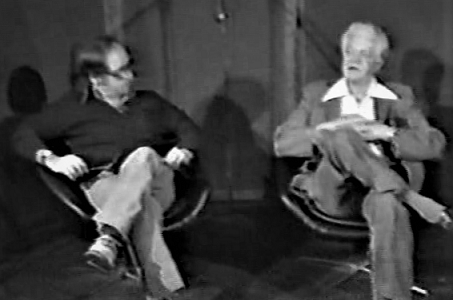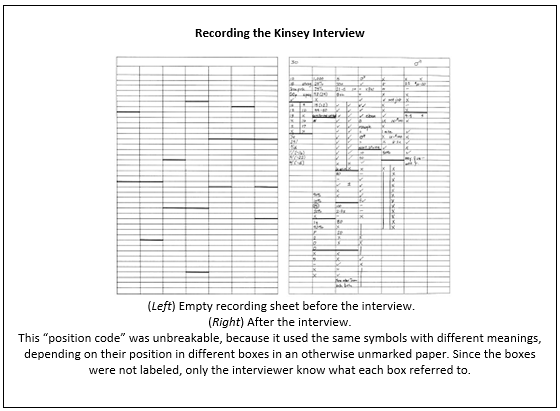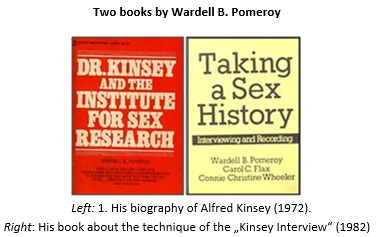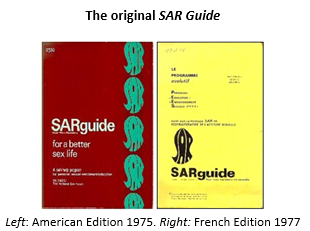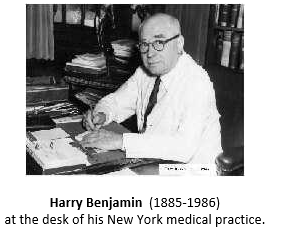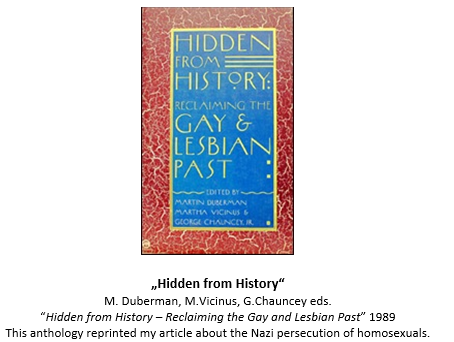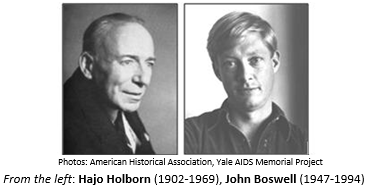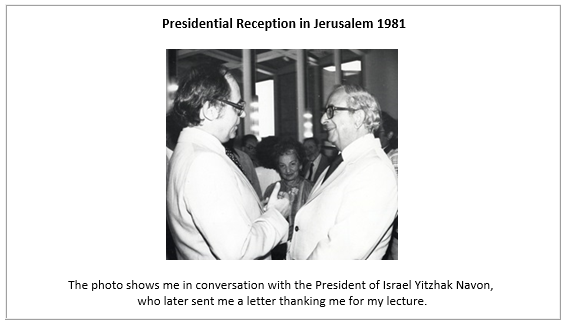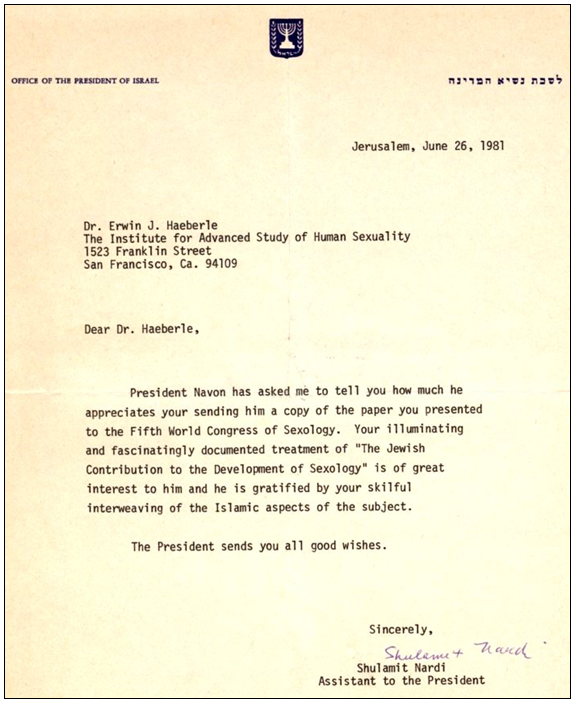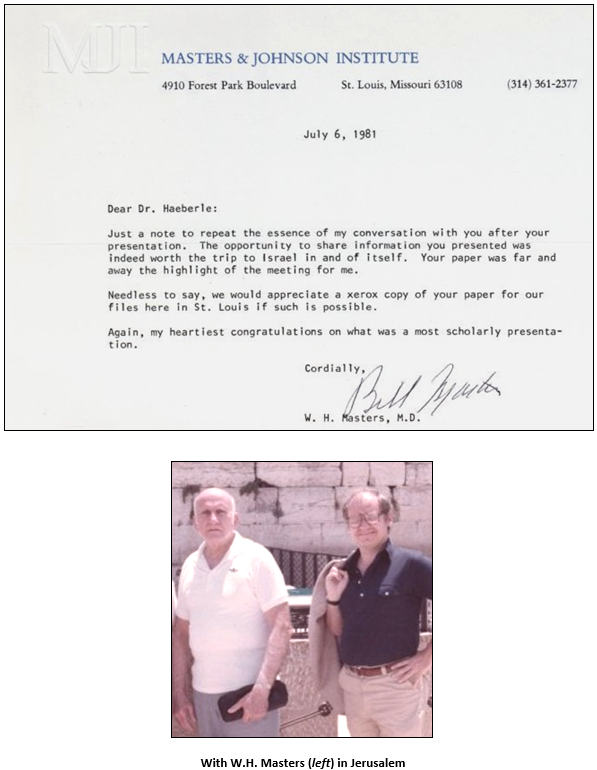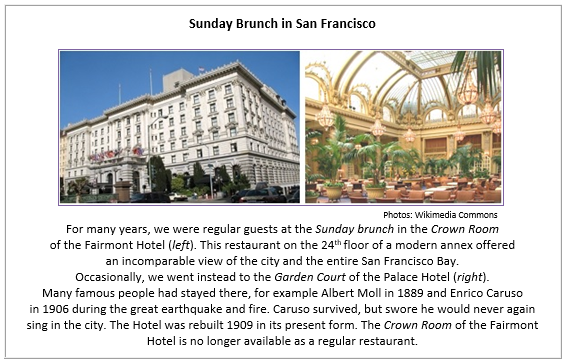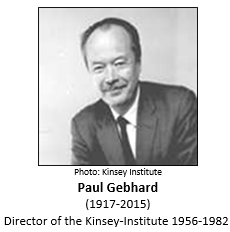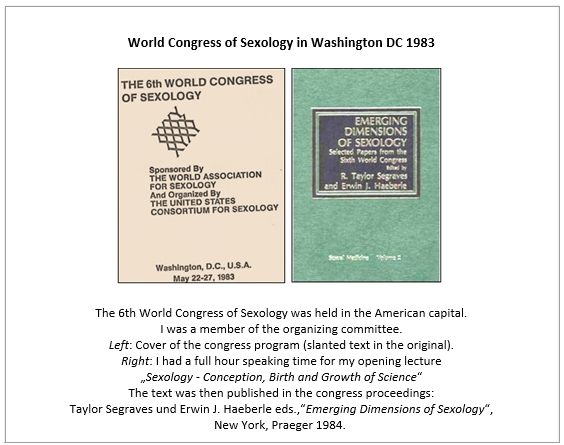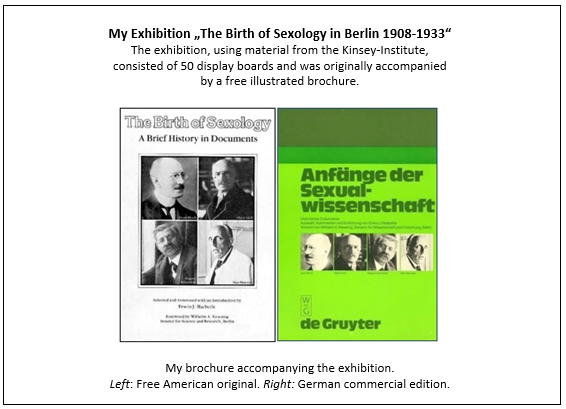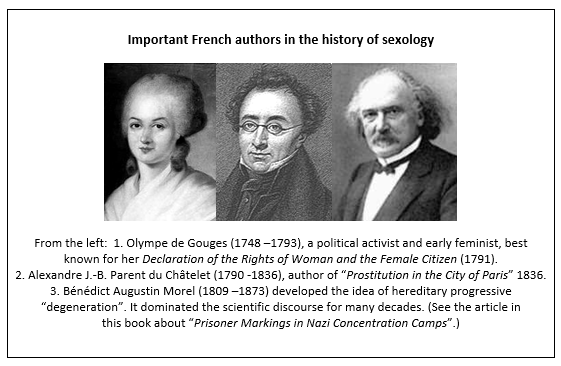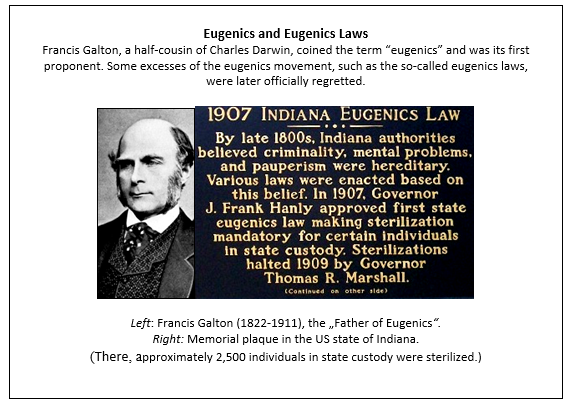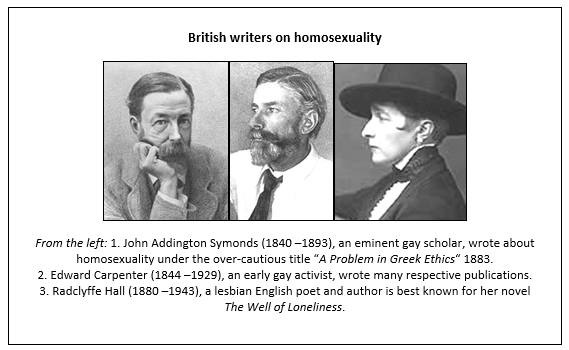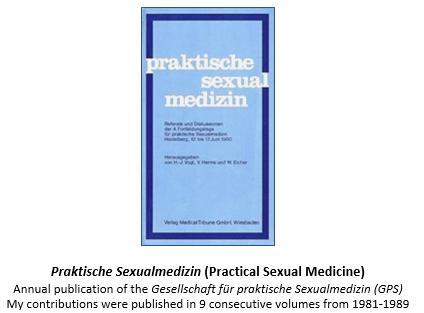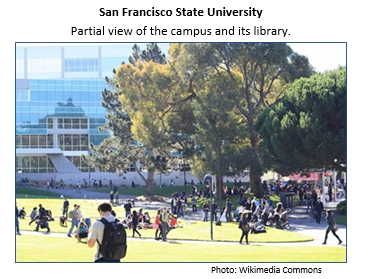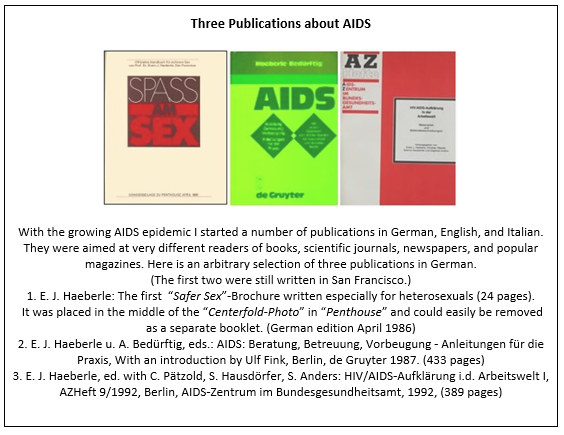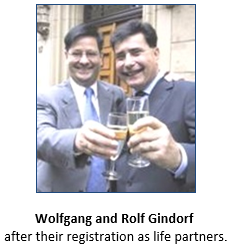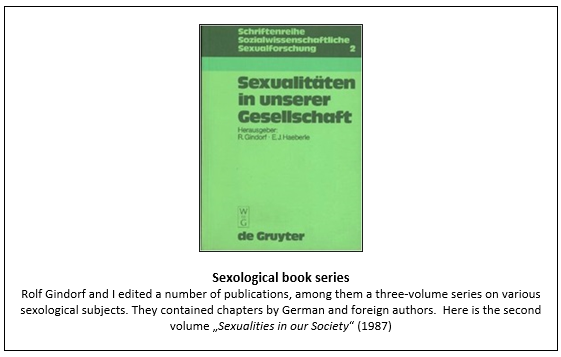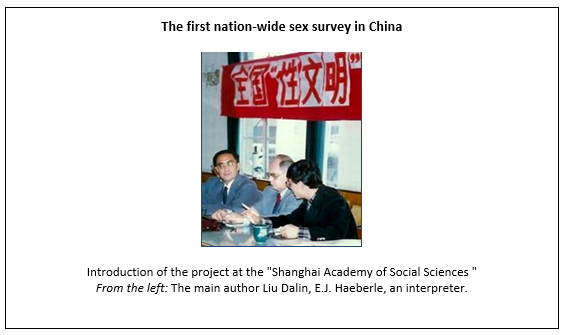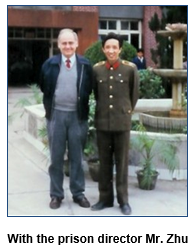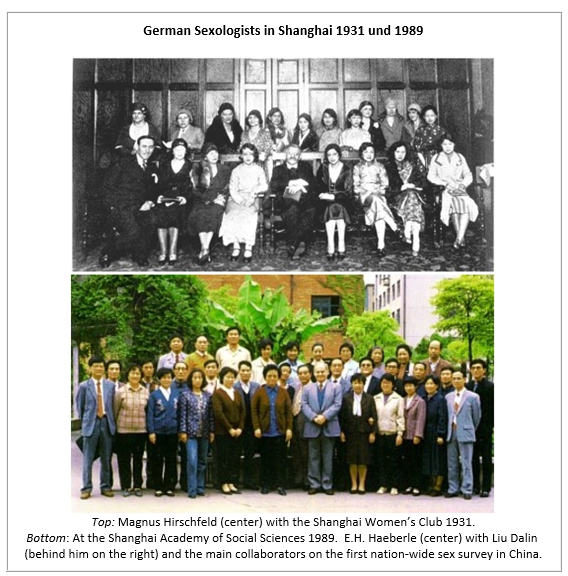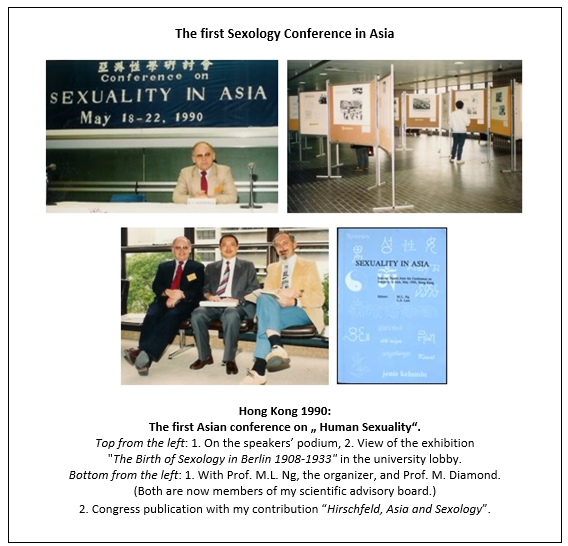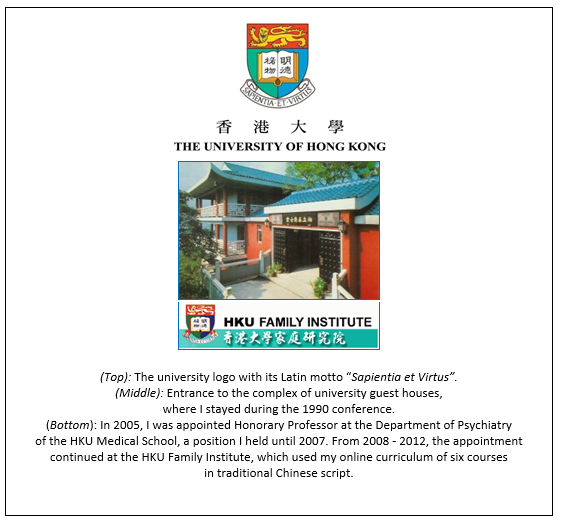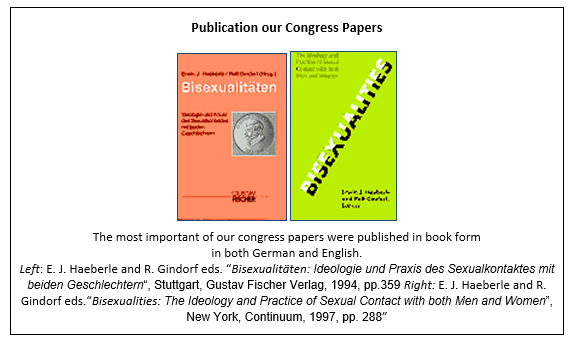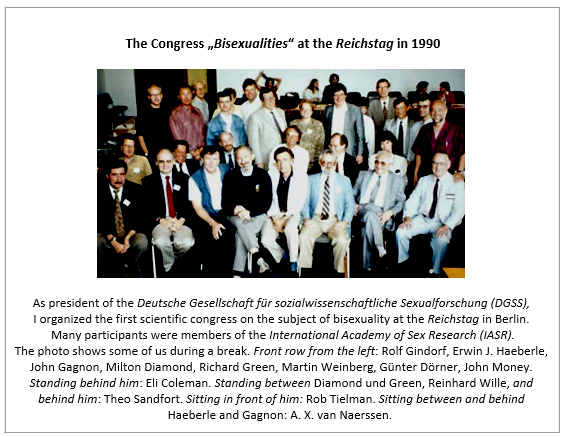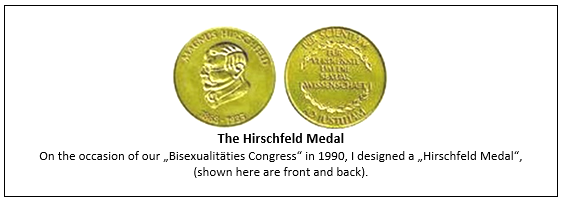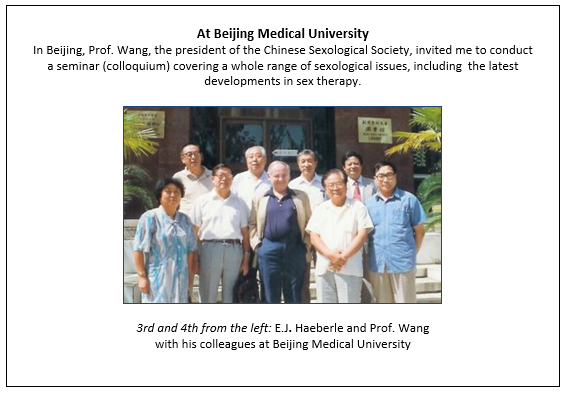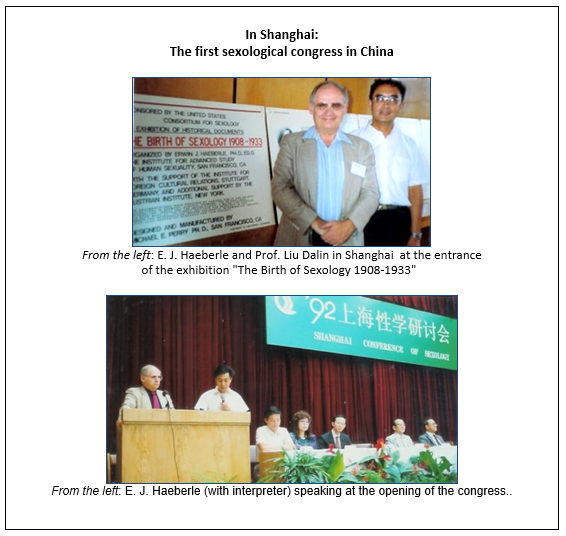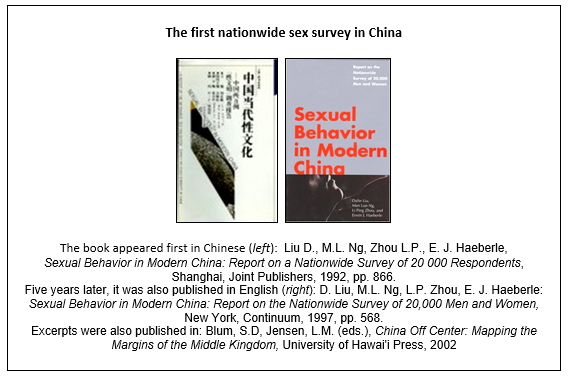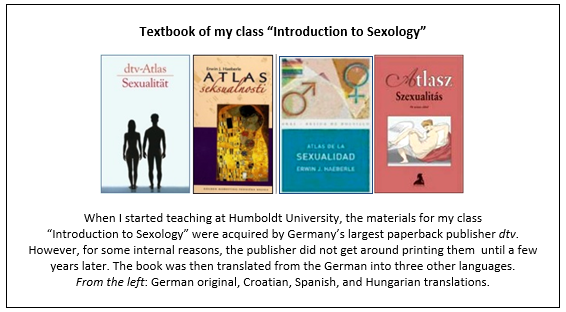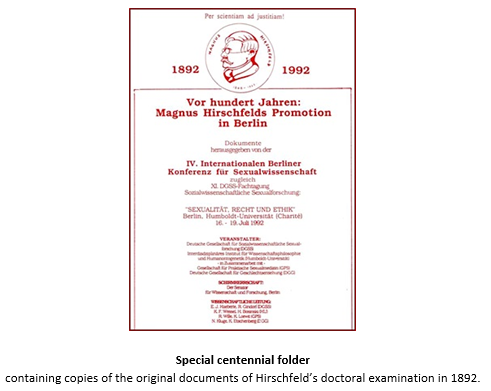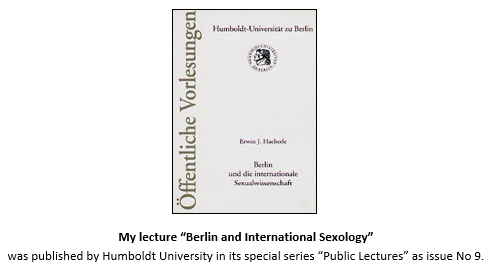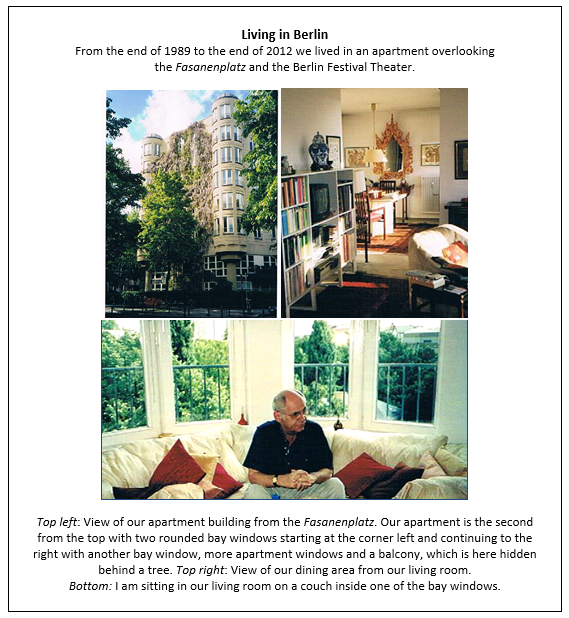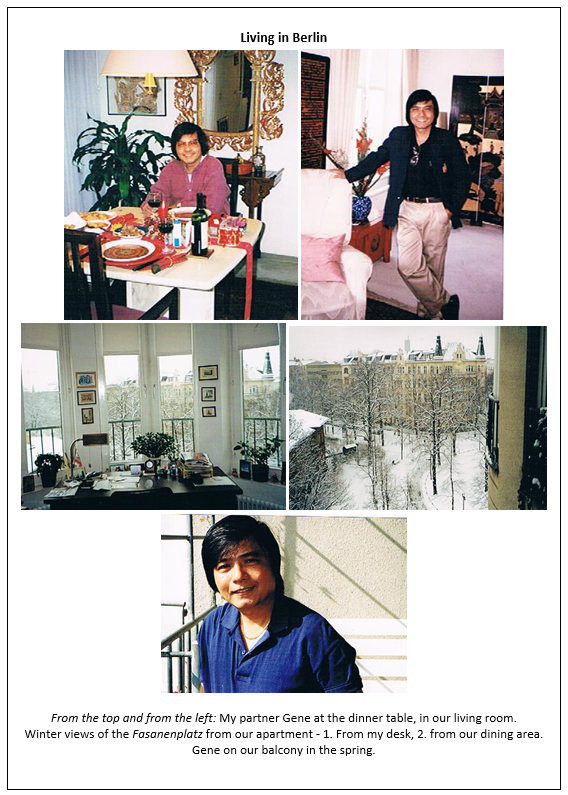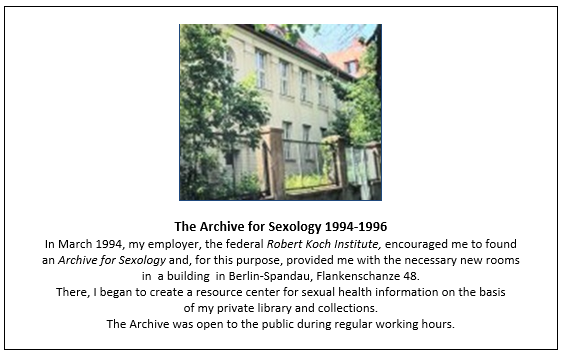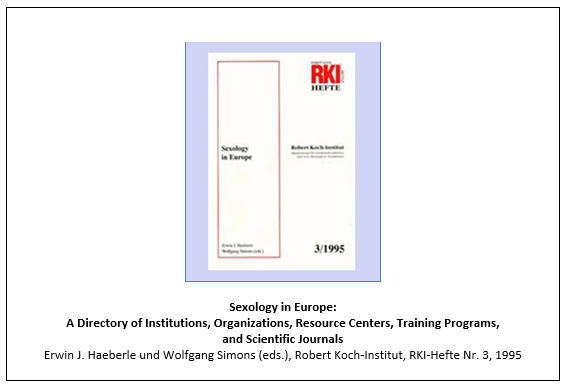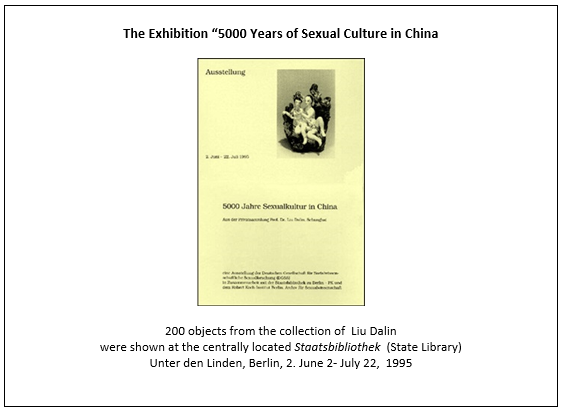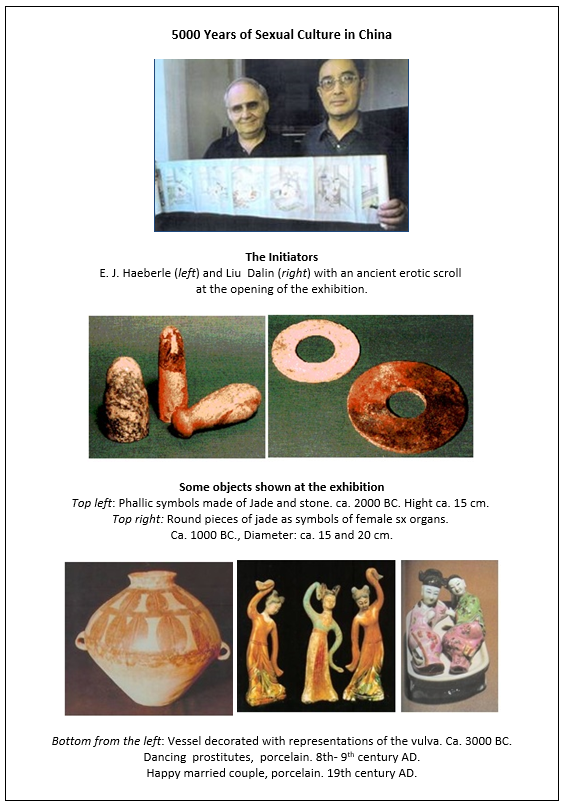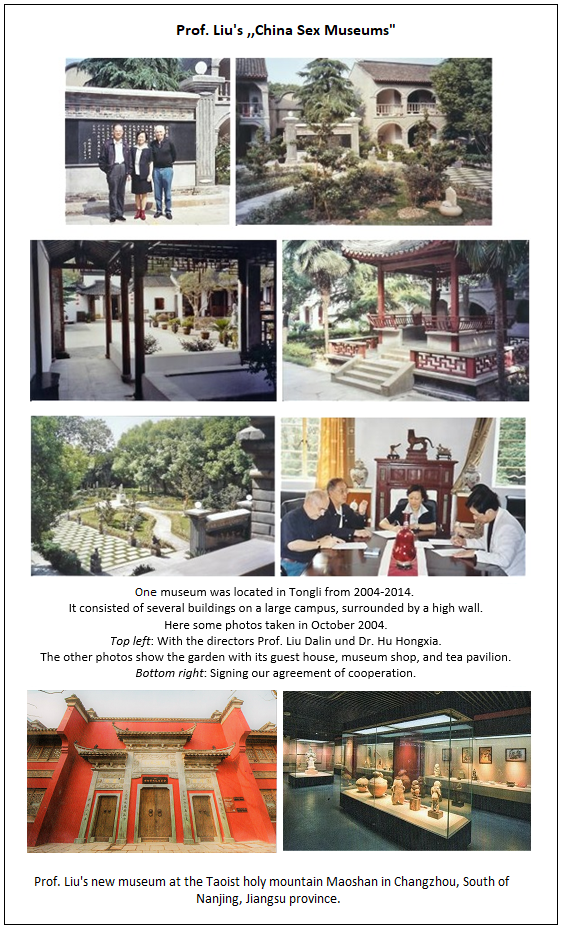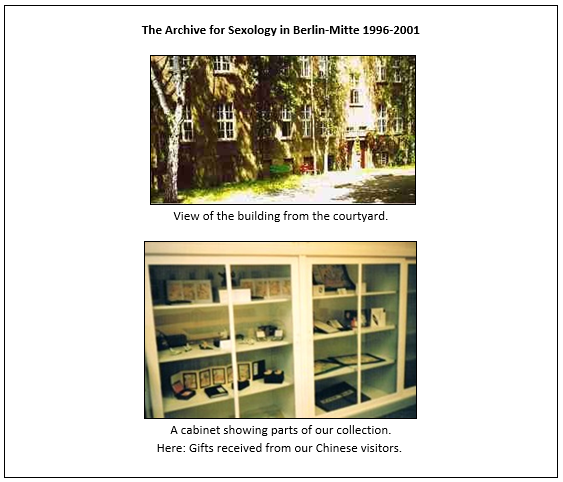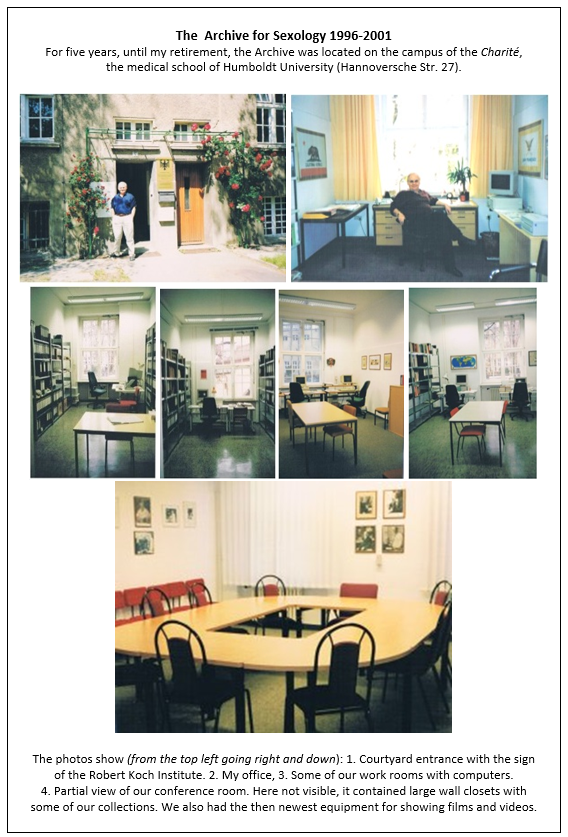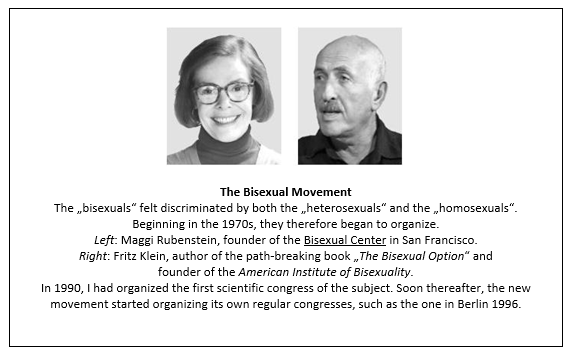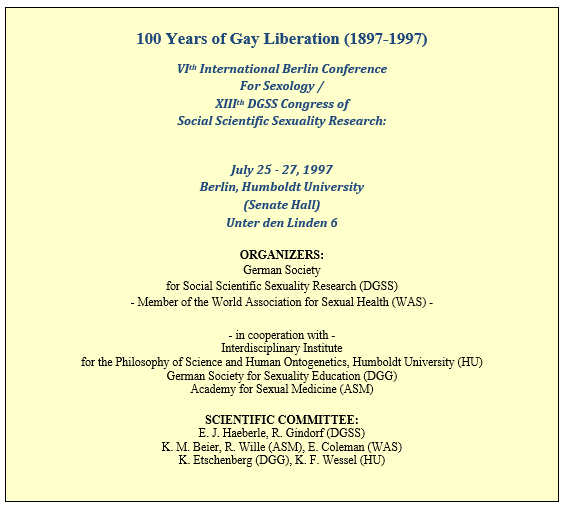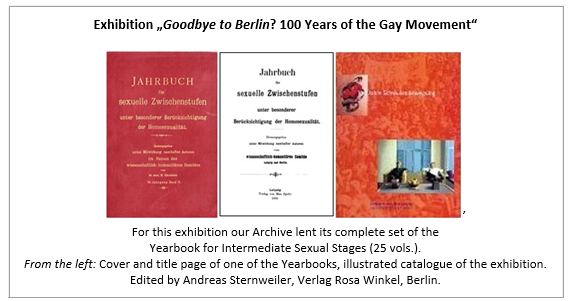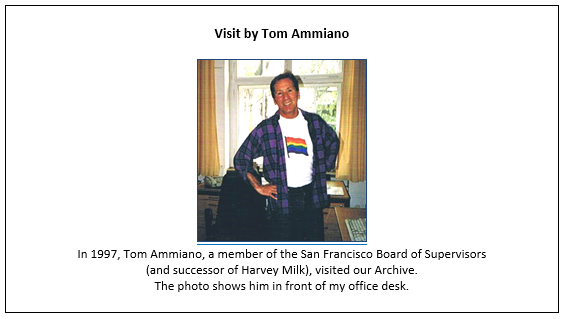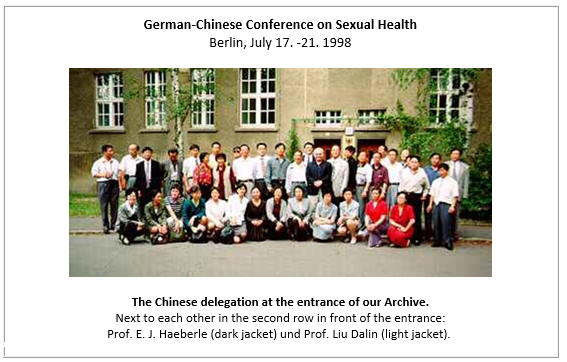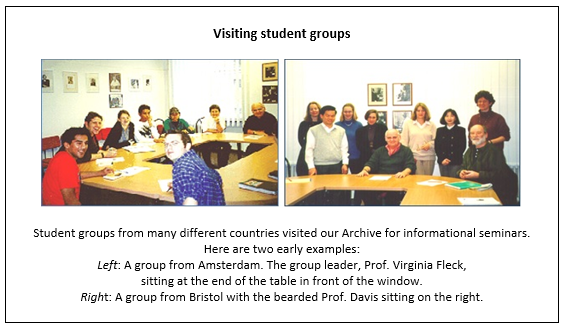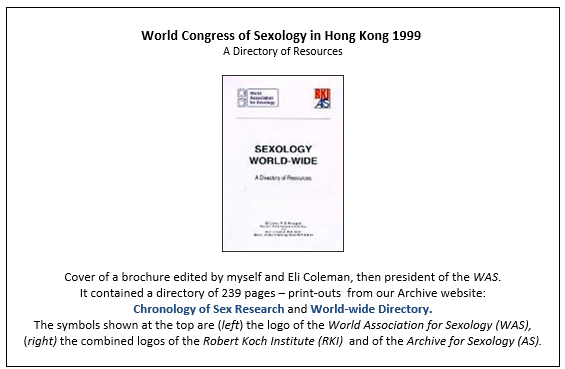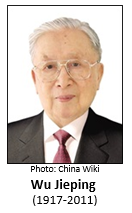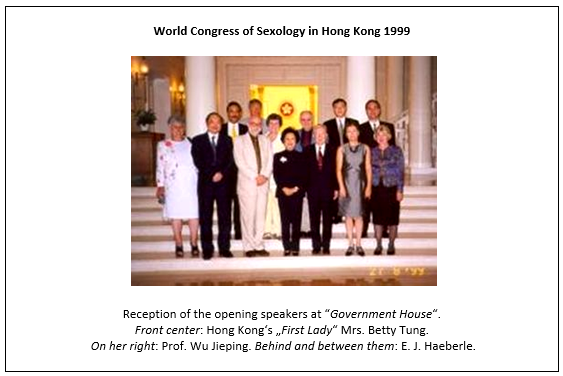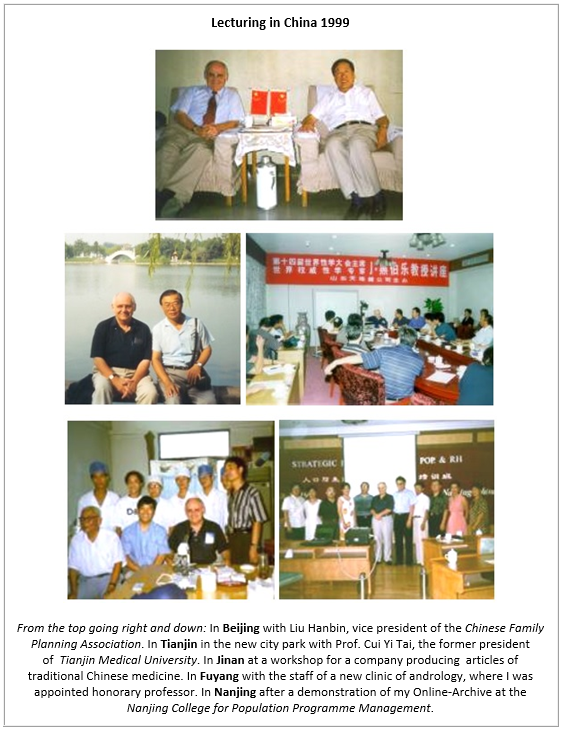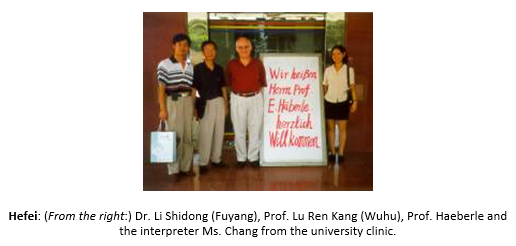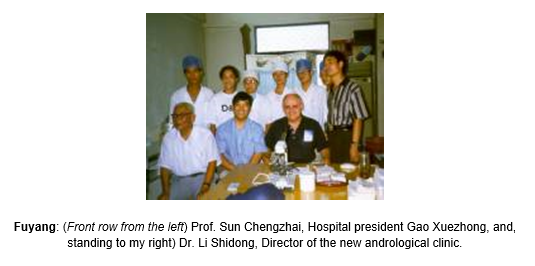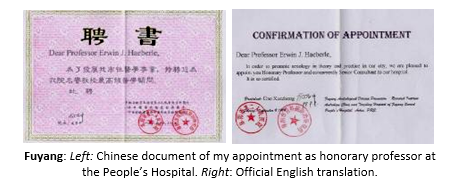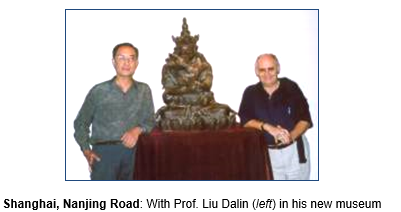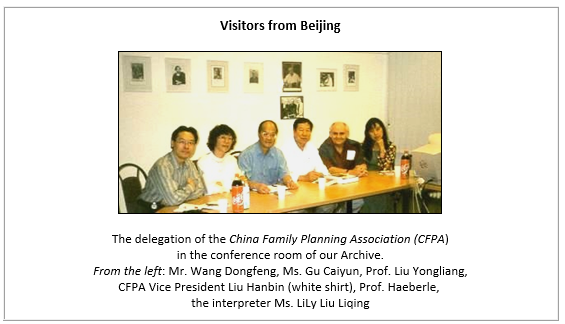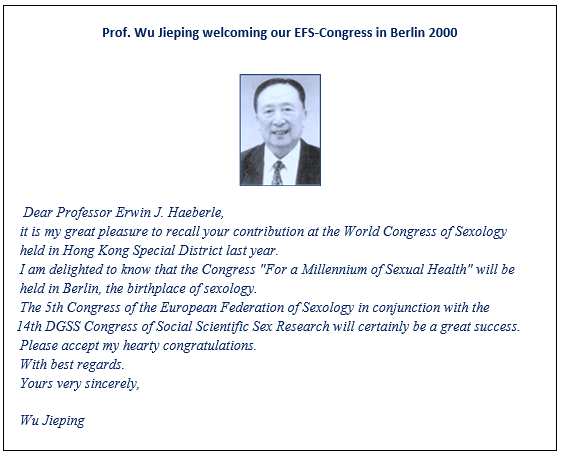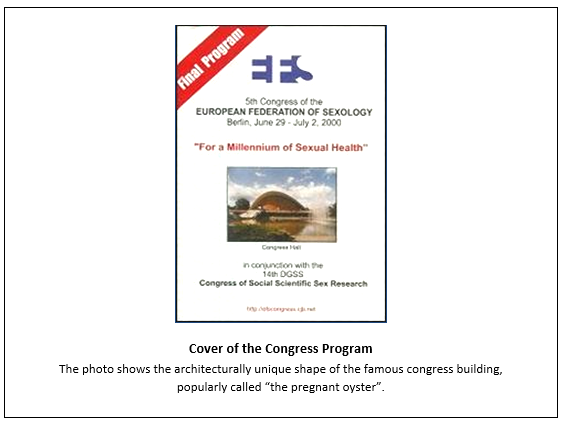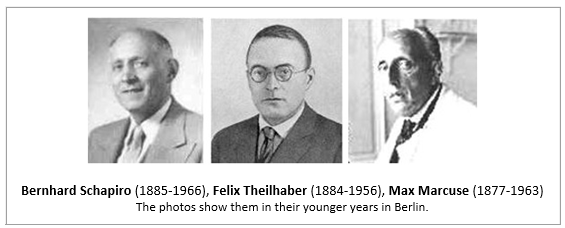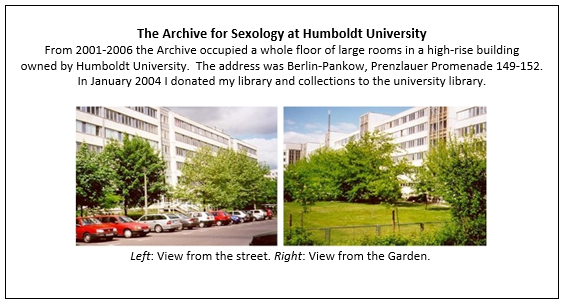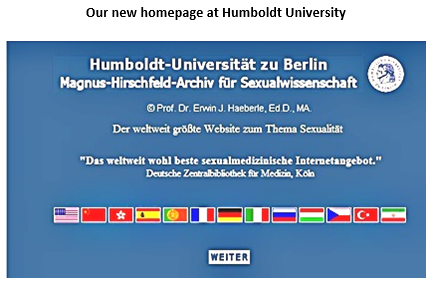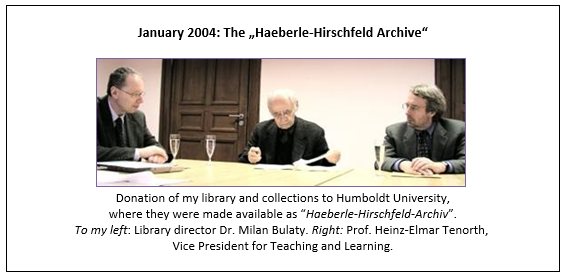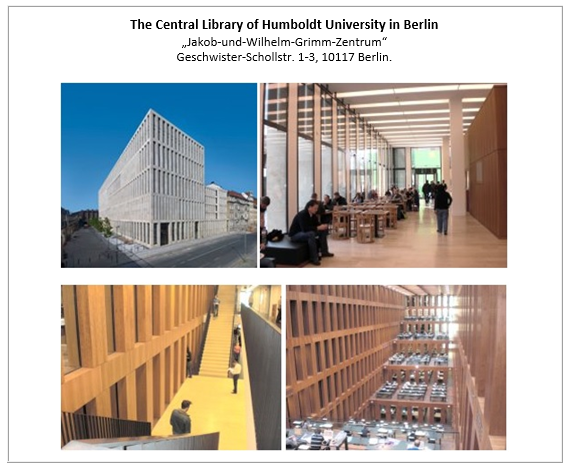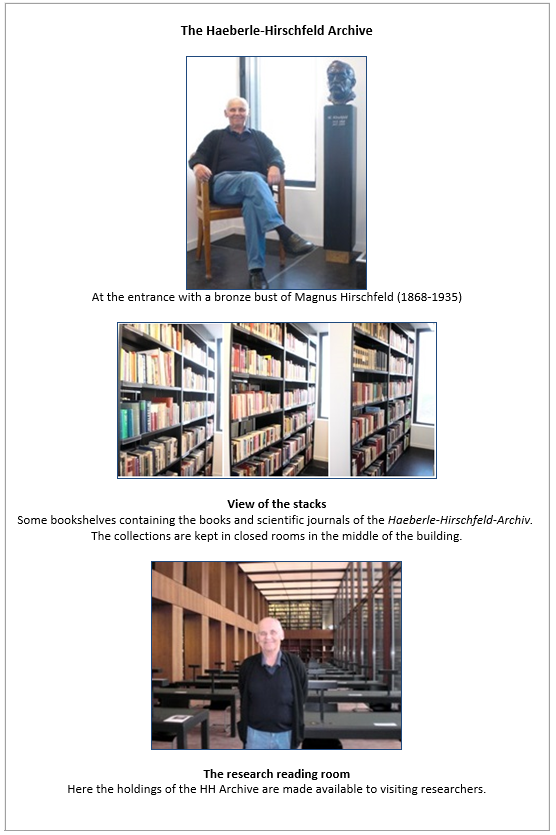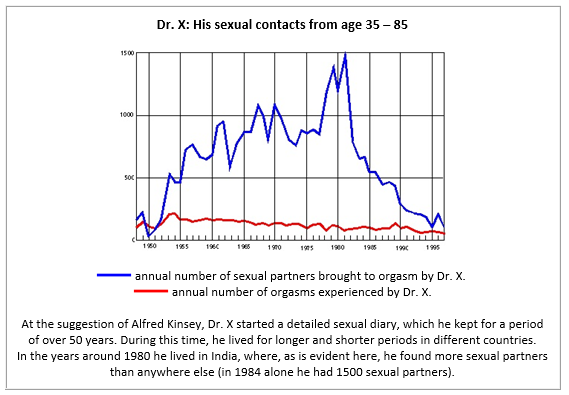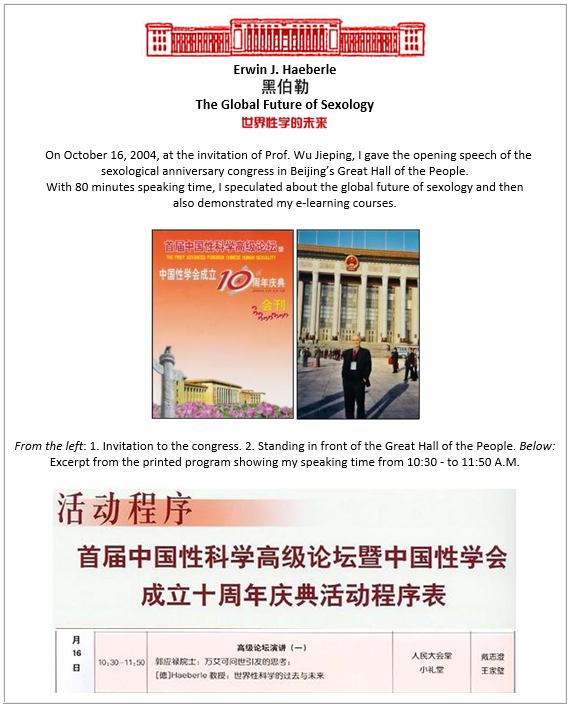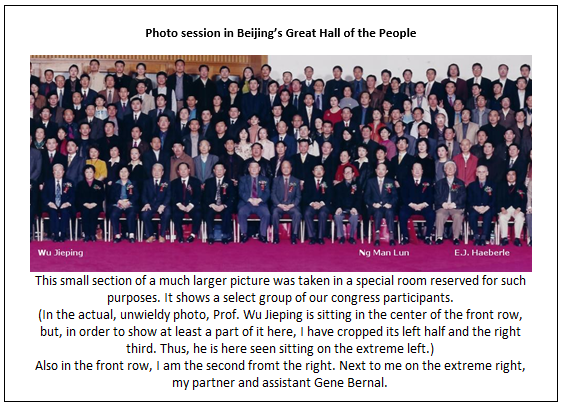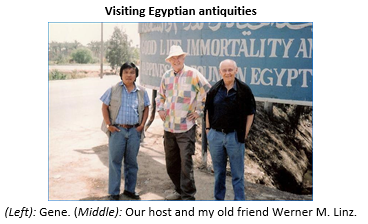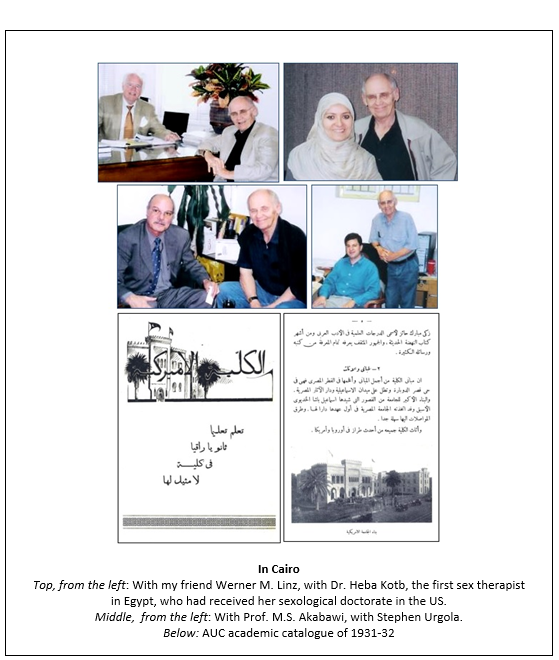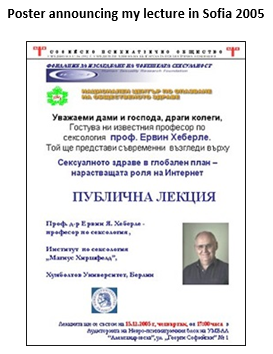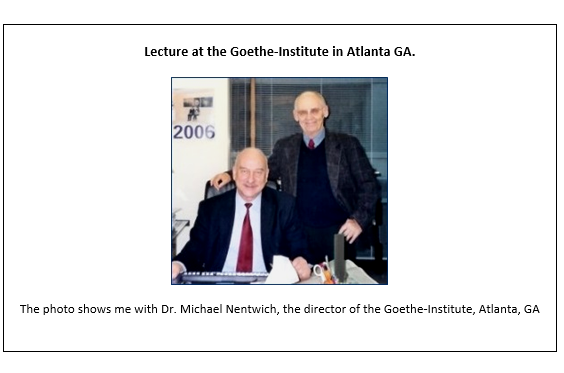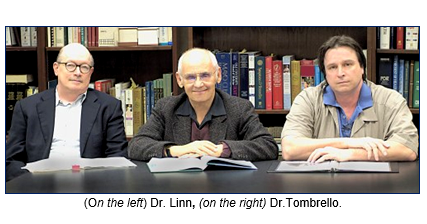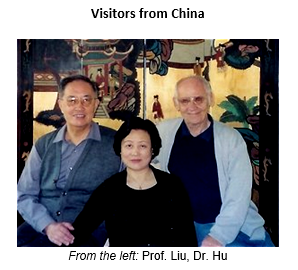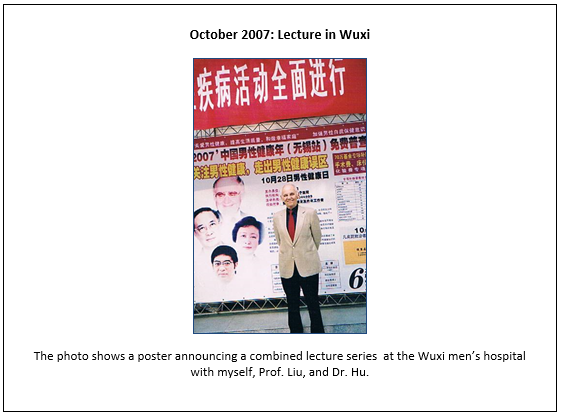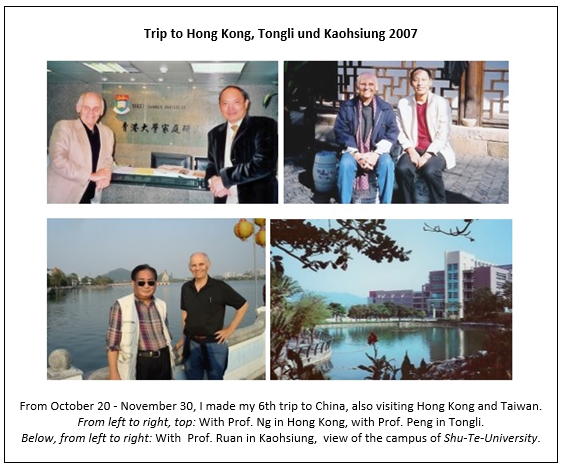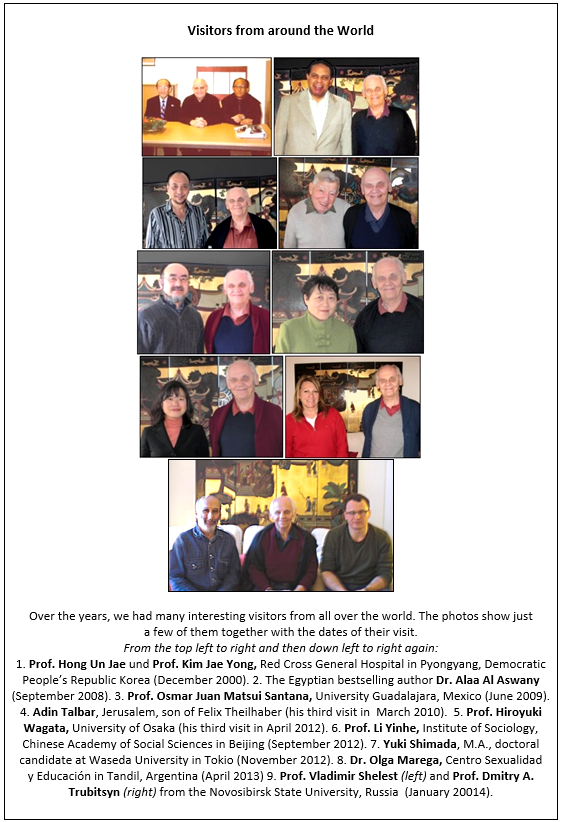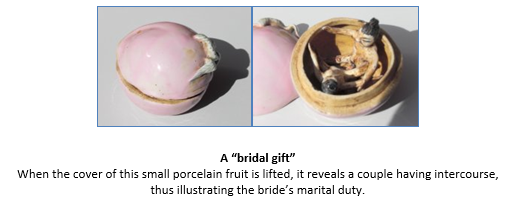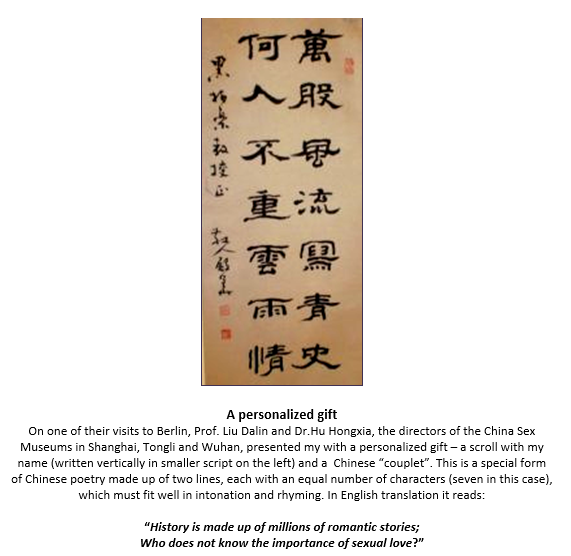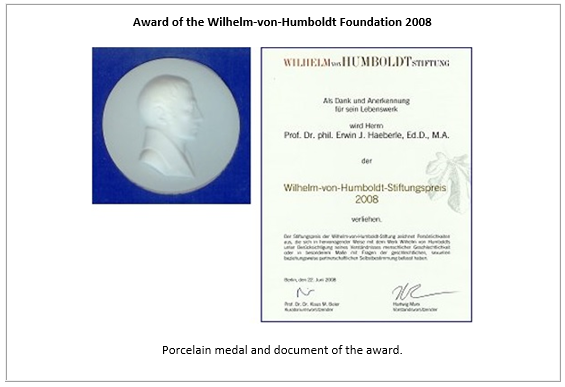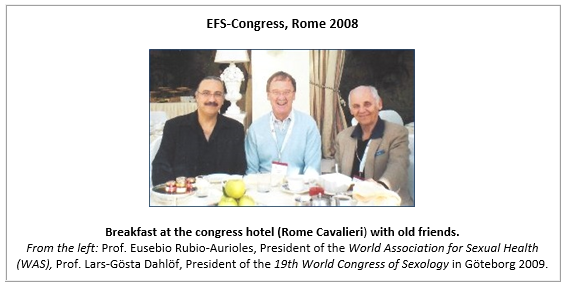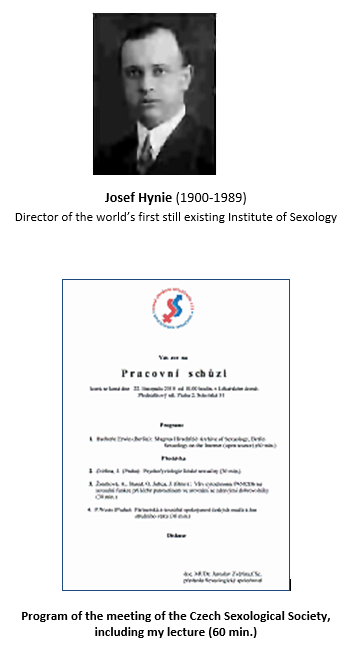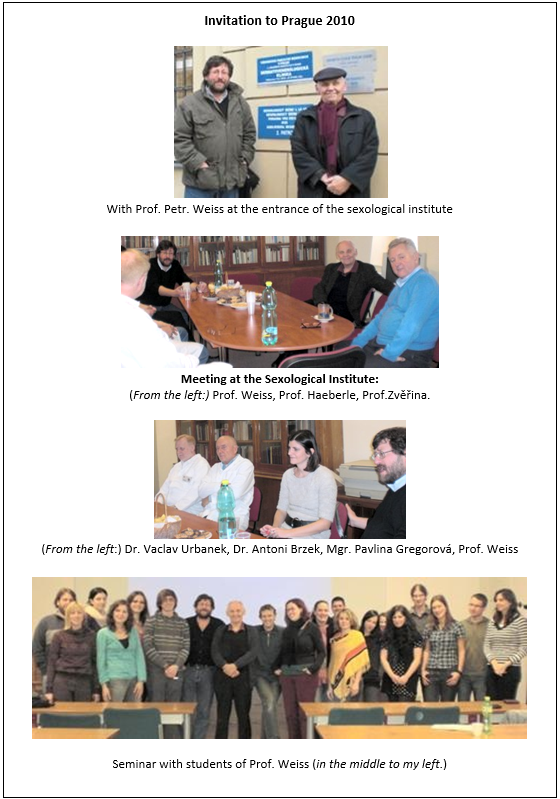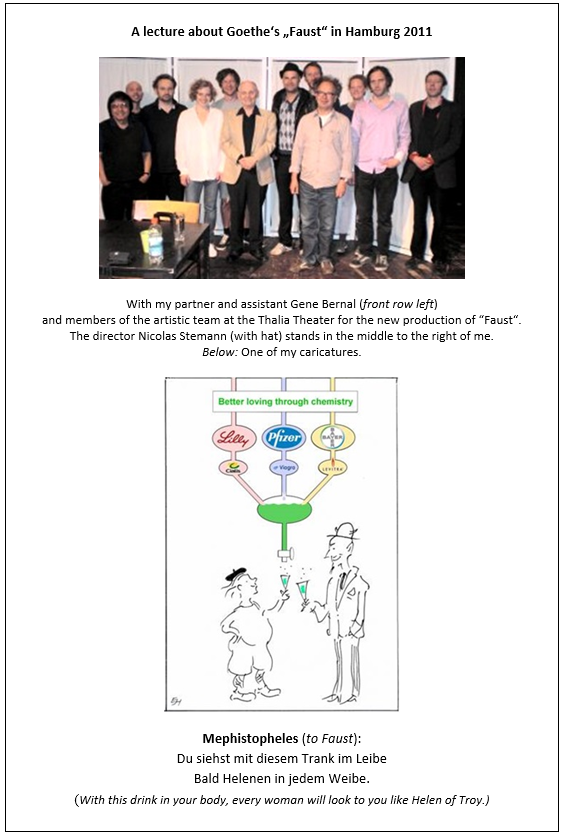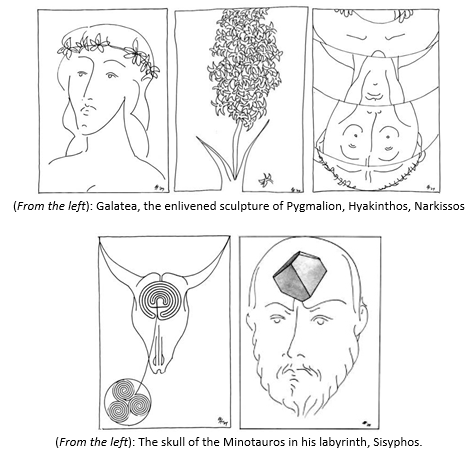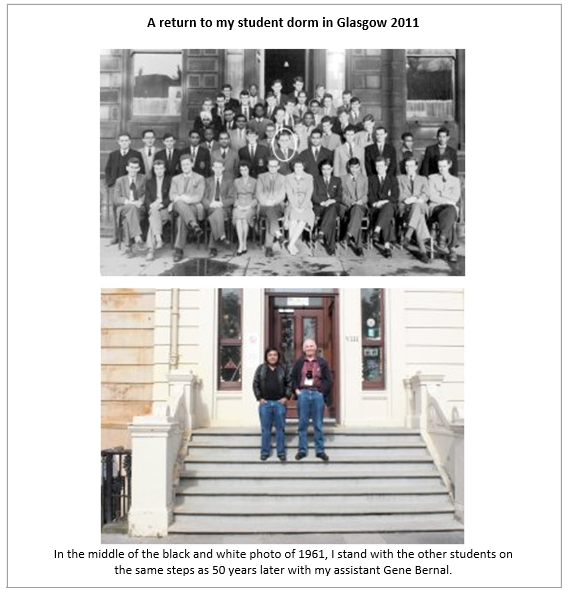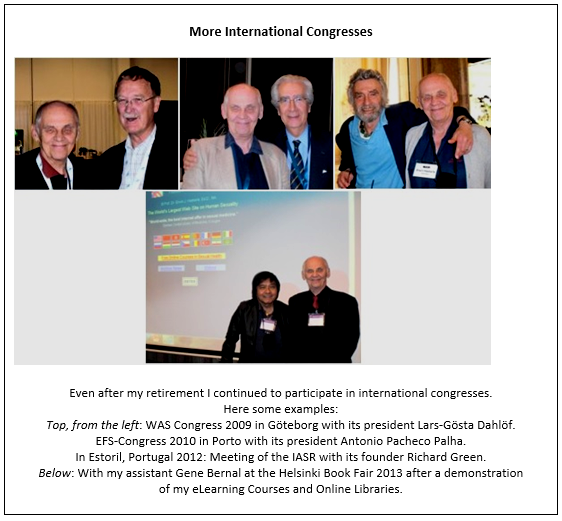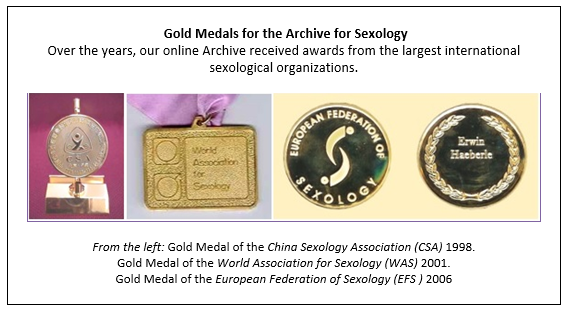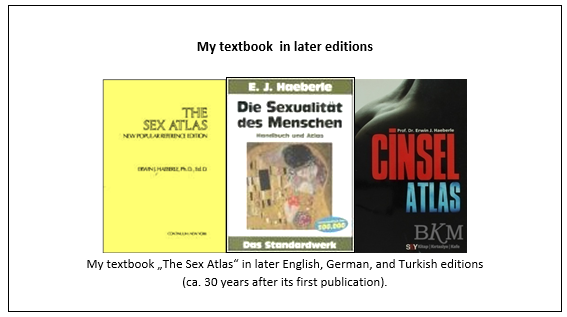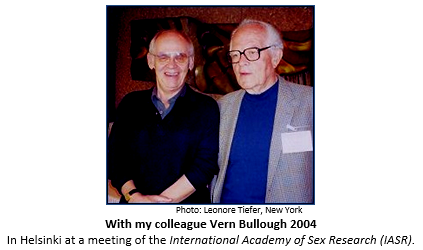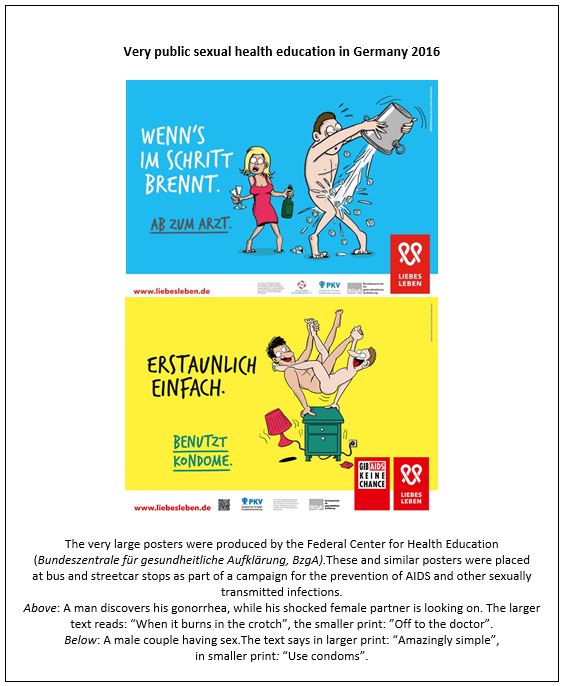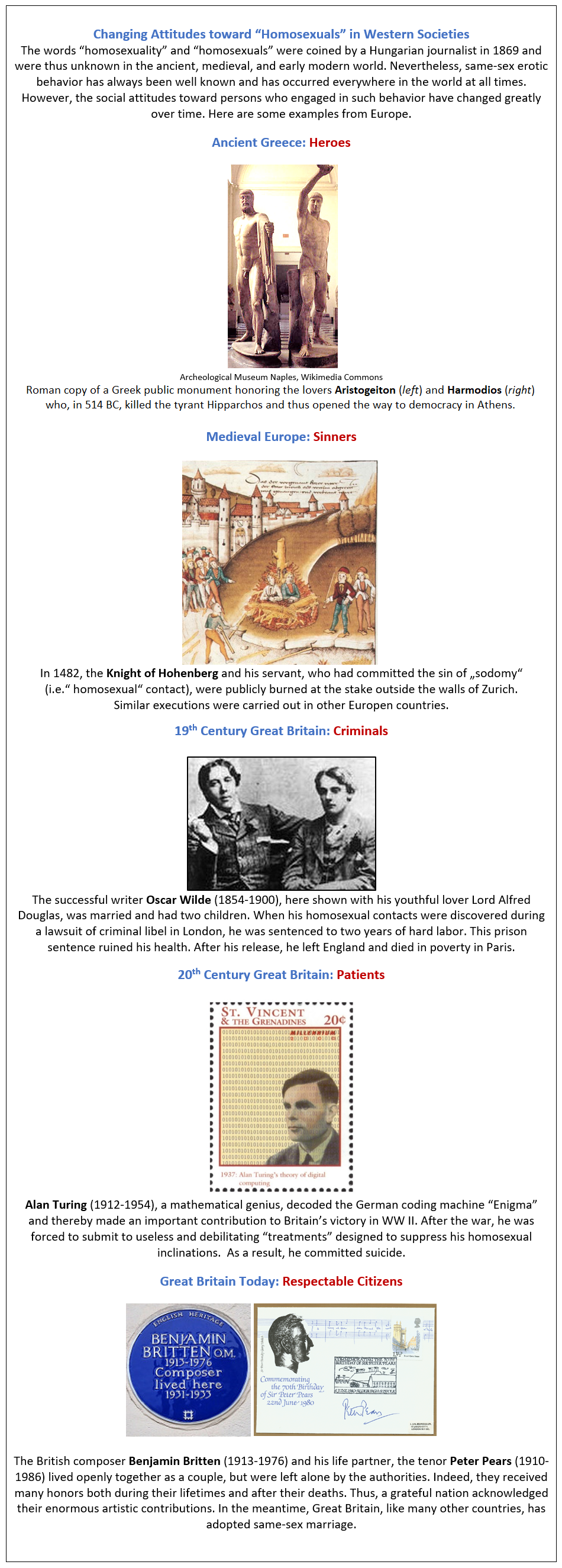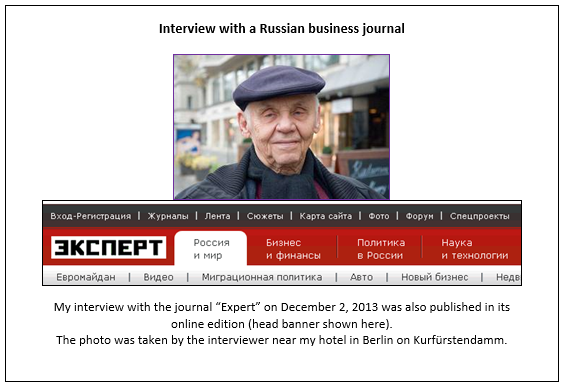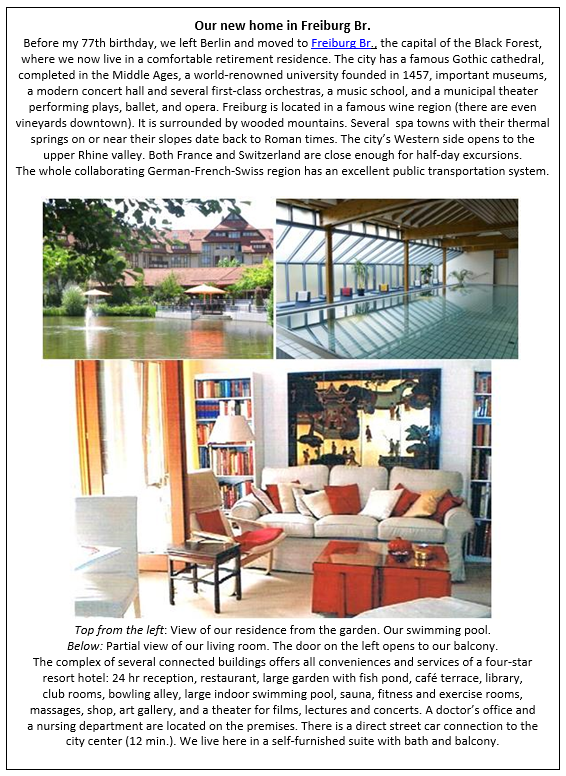|
An Accidental Career – Looking back at my life as a sexologist
3. A Textbook of Human Sexuality
5. World Congress of Sexology in Jerusalem
7. Practical Sexual
Medicine
9. AIDS
12. Visiting Professor at Humboldt University
14. The largest sexology congress in Berlin
16. Travel to other countries
Erwin J. Haeberle
An Accidental Career
Looking back at my life as a sexologist
This selection offers texts written over the last 40 years. I
wrote them spontaneously or on invitation, depending on various
circumstances at the time. In any case, they did not follow an
overall plan or design. Also, I do not present them here in
chronological order.
As I realize now, apart from my textbook “The
Sex Atlas”,
most of my print
publications in English over the last 40 years have been dealing
with historical matters, either with the history of sexology
itself or with related subjects. They make up the bulk of the
present volume. Only the last six of the texts address current
problems and try to look into the future not only of my own
field of study, but of the academic world in general.
The collection ends with an updated
Chronology of Sex
Research that I had written long ago when I first became
interested in sexology.
Fortunately, in this online version of my book, I can present my
most important contribution to our field, i.e.
the invention and pioneering of “open access” online
courses (today known as MOOCs). In January 2003 I put the first
of these courses online under the title “Basic
Human Sexual Anatomy and Physiology”.
One year later, in 2004, I demonstrated it with some additional
courses at Beijing’s Great Hall of the People, and soon
thereafter they were translated not only into Chinese, but also
into other languages. Today, I am offering a complete curriculum
of 6 courses (6 semesters) in sexual health in the internet,
freely accessible in
English, Spanish, Portuguese,
Chinese (in simplified and traditional script),
Russian, Czech and Hungarian.
Some of the courses are also available in other languages. If
used by professional organizations, this curriculum can lead to
certificates or diplomas and, if used by universities, it can
lead to academic degrees (B.A. or M.A.). Moreover, it can be
studied not only on PCs, but also on tablets and smart phones.
At this time, however, I am aware of their regular use only in
China, where they help in the training of a great many sex
educators every year. American and European universities and
professional organizations still seem reluctant to take
advantage of my offer and to follow the Chinese lead.
Returning to the present text selection, I would like to add a
few comments on my own family background, academic training, and
career:
My parents were both born in the same year 1902 in our hometown
Bochum. Neither of them enjoyed any form of higher education.
Throughout her long life, my mother was a “Hausfrau”. A
few years after the sudden death of my father at the age of 60,
she moved to Brussels, joining my sister, who had married a
lawyer at the EU. When he also unexpectedly died at a young age,
my mother was able to support her daughter in the household and
to help her in bringing up her two small sons. She was fortunate
enough to see her beloved grandsons grow into successful
university graduates. As she often said: These were the happiest
years of her life. She died at the age of 94.
My father had received some training at a local bank, but, as a
still very young man, had become self-employed as a book keeper
for a number of small and medium-sized, mostly Jewish
businesses. However, with the anti-Jewish race laws of 1935, the
authorities presented him with a “Berufsverbot”,
i.e. a prohibition to continue working in this capacity.
After the war, he did not speak very much about what must have
been a traumatic experience. I do remember though, that he once
mentioned taking the train to Amsterdam and smuggling a great
deal of cash - sewn into his jacket -
to one of his former Jewish customers, whose family was
ready to board a ship to Argentina. The money was theirs of
course, but they had not been able to take it with them when
they fled.
At that time, he started a new career as a self-employed sales
representative of several shoe companies, receiving a percentage
of his sales.
However, after a promising start, even this ended suddenly with
the beginning of WW II. On its first day, my father was drafted
into the army, and 6 years later, still a private, he deserted
in the spring of 1945 from the Western front, which, by that
time, had moved rather close to our city. He put on civilian
clothes, evaded arrest and imprisonment by the allied troops and
came home.
Looking back now at the first, very hard post-war years, I
remember three things about my father:
1. He apparently still clung to the world he knew best and loved
before the Nazis had come to power. This showed itself in his
language, which had remained full of Yiddish expressions (I am
using here the German spelling): The words “Tacheles”,
“koscher”, “meschugge”,
“die Mischpoche”, “der
Zores”, and “der
Dalles” were parts of his everyday speech. Sometimes he used
the words along with some sarkastic comments like: “Gannef,
the son-in-law”, or “Tinnef,
the wedding present” etc.. This unshakable habit was
obviously an echo of his early working life. I don’t know how he
got away with it during the entire “Third Reich”.
2. In 1946 he found that, as the only one of her family, a
daughter of one of his former Jewish customers had survived the
Buchenwald concentration camp and had returned to Bochum. When
we visited her, we found that she had married another camp
survivor, and that his 17-year-old nephew, still another
survivor of the same camp, was living with them. My father
explained the situation to my sister and me, 8 and 10 years old
at the time, and we fully understood, but we were more
interested in something else: The new Jewish family invited us
to a good meal and repeated such invitations in the following
months and years. These were the “hunger years” in Germany, and
we children therefore always looked forward to another visit.
For us, each of these meals was a feast, as it must have been
for them after the horrible years of their suffering and
deprivation. (As Holocaust survivors they had different rationing cards.) Soon, the young nephew succeeded in immigrating to
New York. From there, he sent us children a CARE package
including, among many nourishing goodies, a Woody Woodpecker
comic. Without understanding it, I read it over and over and
decided right then that someday, somehow, I would also go to
America. I especially remember one spring afternoon. It must
have been May 14, 1948, because we were celebrating the founding
of Israel with coffee and cake. The cake had all all-white sugar
coating decorated with blue butter cream forming a star of
David, and there were also little paper flags with the same
design. This was the first time I saw Israel’s national flag,
and without understanding the full implications of the event, I
was fascinated. (Later, I found out that May 14 was also the
date of Magnus Hirschfeld’s birth and death.) 3. These long forgotten memories are now coming back to me as I write. However, there is one episode from that time that I have always kept in mind. It was a lesson for life my father taught me in a single sentence: One day, I must have been 10 or 11 years old, he showed me a sizeable, illustrated Nazi propaganda book from the 1930s which he had found in the rubble of one of our city’s bombed-out houses. The volume had a large fold-out of several pages. It showed thousands of people at a Nazi rally in front of a wall of swastika flags. My father pointed to this photo and said: “Take a good look at these people and remember that they were all against it!” I immediately understood. He was talking about the stupidity, gullibility, and hypocrisy of the masses. He was also talking about our policemen, train conductors, and store owners, indeed about our teachers and our neighbors. Even as a child, I myself remembered how many of them had been fanatical supporters of Hitler and now claimed to have been secret opponents. The more I thought about it, the more I realized the dangers of blind obedience to authority and of unquestioned general assumptions. I also saw that adults lie, and lie with conviction, not only to others, but also to themselves. Thus, even before I entered my teens, I became skeptical and critical of “the will of the people” and of every social and political “established order”.
I
became a sexologist in my middle thirties more or less by
accident. Originally, I had begun studying theater history,
German and English literature at the universities of
Cologne and
Freiburg Br. I
financed my studies first by working in various factory jobs
during academic vacations, later as a janitor in some large
wooden library shack for students, and eventually as an actor
and director in a private professional theater.
After this difficult beginning, I eventually
succeeded in winning some scholarships, and this enabled me to
continue studying at the universities of
Glasgow,
Heidelberg,
and at Cornell.
1. From Heidelberg to the USA
2. Cornell
(1963-1964)
Cornell’s foreign students came from all over the world. In my
student dorm (Cascadilla Hall), I lived door to door with
students from the Soviet Union.
They were upset when we saw Kubrick’s latest movie „Dr.
Strangelove“, as they were quite unprepared for this kind of
biting political satire. But they were utterly shocked and
frightened when, in early November, President Kennedy was
murdered in Dallas. For days, we all followed the live TV news
reports in our common room.
As to cultural events, I remember, above all, a concert on
campus given by the then still relatively unknown Bob Dylan. But
Cornell students also showed their own productions in the
University Theater. For one of them, Goldoni‘s „The Mistress of
the Inn” (La Locandiera),
I designed the sets and costumes.
In addition, the student film club regularly showed old
Hollywood movies, and these introduced me to the great comic
actors of the 1930’s and 1940’s of whom I had never heard before
- the Marx Brothers, Eddie Cantor, and especially the
incomparable W. C. Fields. The
current TV shows (still in black and white) featured the
lovable, amusing series with Jack Benny (The Jack Benny
Program). Later, I saw
reruns of the hilariously funny shows with Sid Caesar (Your
Show of Shows), Jackie Gleason (The Honeymooners) and
Lucille Ball (I love Lucy).
I was also lucky enough to see the great Jewish stand-up
comedians of the older generation: Milton Berle, Henny
Youngman, Shelley Berman and Alan King – all of them masters of
their trade. This introduction
to American humor and it various traditions helped me greatly in
understanding American culture.
Throughout, I remained a faithful fan of the American grotesque
comedy shows - later in color -
from Danny Kaye to
the unforgettable
Carol Burnett and the distinguished
looking, but always hilarious Harvey Korman. I also enjoyed the
TV appearances of Jerry Lewis. Of course, not all television
humor was rooted in Jewish traditions. There were also wonderful
black comedians from Redd Foxx to Flip Wilson, Eddie Murphy and
Richard Pryor. Very often I watched Johnny Carson, a real “pro”,
who dominated “late night television” during the entire time of
my stay in the US. I greatly admired Dean Martin, the most
relaxed of all performers, with his occasional guest Foster
Brooks. Most impressive
were
later the strange, daring, and baffling presentations of Andy Kaufman and the breathtaking solo peformances of the “avant-garde” comedians Jonathan Winters and
Robin Williams. American television changed a great deal over
the years, reflecting the larger social changes in the country.
For me, its humor remained an important key to understanding the
complex “New World” I lived in for so many years. I left Cornell
in the summer of 1964 with an M.A. degree.
When I returned to my English department in Heidelberg with my
degree from Cornell, I was given a position as “wissenschaftlicher
Assistent” (roughly equivalent to an assistant professor)
and started to write my dissertation about the plays of the then
still living novelist and playwright Thornton Wilder.
(1)
Two years later, I received a Ph.D. (Dr.
phil.) in American literature.
3. Yale
(1966-1968)
Pearson was also financially quite comfortable.
One day, when he and his wife had invited me to tea, he
surprised and amazed me by taking a „Shakespeare
Folio“ from
his book cabinet. (He also owned several Quartos.)
Other examples: The license plate of his large luxury car did
not show any numbers, but instead his full name. When, right at
the beginning, my stipend turned out to be too low, he saw to it
that it was immediately raised and gave me a personal check for
the time already passed: “This is not a loan!”. His unexpected
early death shocked me. I still think about him often with deep
gratitude.
At that time, Yale was an all-male school, i.e. without female
students and hardly any female professors (I met only one).
Indeed, the Ivy League football games in our stadium offered
male cheerleaders - an unusual, very interesting sight - now
gone forever. The “downside” was an “uptight”, stuffy,
pretentious and boring, emphatically masculine atmosphere on
campus. On the other hand, the university offered many memorable
cultural events, for example symphony concerts, opera arias with
Renata Tebaldi, Shakespeare’s sonnets recited by John Gielgud,
meetings with authors like
Robert Lowell, Joseph Heller, Robert Penn Warren, Norman Mailer,
and Tom Wolfe, who
had received his Ph.D. in American Studies under Norman H.
Pearson and always wore a white three-piece suit.
There was another evening with the boxer Muhammad Ali,
whom I could see (and almost touch) up very close – a
hero radiating strength and good health. I also saw the actor
Paul Newman up close: He looked even better in private than in
his films.
Of course, I also used every opportunity to see not only the
latest Hollywood movies, but also many old ones. I especially
remember one of them: "Wonder Bar" (1934) with Al Jolson singing
in blackface. For me as a European “postdoc” in American Studies
it was a revelation that prompted me to do some additional
research. Thus, I learned a great deal about the old minstrel
shows, and indeed about the original stage figure of “Jim Crow”
as part of American cultural history.
The university theater under its director Robert
Brustein featured stars like Irene Worth, Stacy Keach, and
Kenneth Haig. Some young
students also tried acting, and later some of them had
respectable careers in Hollywood. For example: I saw the
stunningly handsome undergraduate Perry King playing a leading
role in the student production of Thomas Dekker’s “The
Shoemaker’s Holiday”. It was practically foreordained that
he should go to California and lend his good looks to the
movies. Henry Winkler, a drama student, became a television star
as “the Fonz” in the popular series “Happy
Days”.
He was also successful as a producer. The most popular professor
on campus was a specialist for the ancient Greek classics -
Eric Segal, author of the bestselling novel „Love
Story“,
which also became a successful film. Another bestselling author
was the Yale law professor Charles A. Reich with „The
Greening of America“.
He suddenly resigned from his position and moved to California
close to San Francisco as a „free spirit“ and gay activist.
Since a train ride from New Haven to New York takes only about
two hours, I often used the opportunity to enjoy the cultural
events in Manhattan. I usually stayed a couple of nights at the
YMCA and visited museums, theaters, and the two recently opened
opera houses at Lincoln Center. At the MET, I saw a visually and
musically overwhelming production of „Die
Frau ohne Schatten“ by Richard Strauss, conducted by Karl
Böhm, and Wagner’s “Die
Walküre”, conducted by Herbert von Karajan and with Régine
Crespin as Brünnhilde. Most importantly, I saw and heard Wieland
Wagner’s unforgettable production of his grandfather’s “Lohengrin”
with the vocally ideal Sandor Konya in the title role. (I had
seen an earlier version of the same production in Berlin with
the tenor Jess Thomas). At the NYCO, Beverly Sills became an
overnight sensation in Handel‘s „Giulio
Cesare in Egitto“.
All of these performances are still available on CDs, and I
still enjoy listening to them today. In those years, I also saw
all important plays and musicals, for example the first
performance of “Hello Dolly” with Carol Channing, after a play
by Thonton Wilder (after Nestroy). While at Cornell, I had
already seen the original production of Albee’s
“Who’s afraid of Virginia Woolf?” in New York with Uta
Hagen and Arthur Hill – a triumph of acting, much more intense,
gripping, and shattering than Taylor and Burton in the later
film. During my 4 years on the East Coast, I also had the chance
to attend all important ballet performances
- from the
NY City Ballet and Alvin Ailey’s American Dance Theater to Merce
Cunningham and his company. (Many years later in Germany I met
his partner John Cage at the house of a mutual friend.)
Sometime during my stay at Yale I gave a lecture on some
literary topic at
Brown University
in Providence, RI, another member of the Ivy League. I have
forgotten the subject and the date, but I remember clearly the
special atmosphere
enlivening the campus. It
was a bright, warm summer day of an art festival, because I had
the thrill of seeing and hearing an open-air concert by the
legendary Dizzy Gillespie and his band. At the edge of a large
lawn Allen Ginsberg sat under a tree with a group of his
admirers. I simply joined them and was welcome.
In the course of my American studies, which went quite well, I
became interested in American-Japanese cultural relations and
succeeded in obtaining another scholarship and moved on to the
UC Berkeley.
At this point, I’d like to mention a special experience, which I
had the privilege of enjoying twice:
For us foreign students, Cornell had
organized personal meetings with important personalities
in Washington DC (members of the administration, senators,
members of the House of Representatives etc.), and Yale
did the same. Thus, I was fortunate enough to be present a
second time when the most liberal justice William O.
Douglas (1898-1980), received us at the US
Supreme Court. He
talked to us for about one hour, improvising in a relaxed,
humorous manner, answering all our questions directly, clearly,
and without hesitation. He was, in every way, an “authentic”
human being, independent, unafraid, highly intelligent, and, in
his language, “close to the common people”. During my lifetime,
very few men have impressed me as much as he did. He was, in
thought and in speech, a truly free man - the very best American
culture can produce. I never saw anyone like him in
Europe.
4. UC Berkeley
(1968-1969)
Bellah was one of the most important cultural historians of his
time, and, in this sense, he was himself an „establishment
figure“, but his attitude toward the political and academic
establishment remained cool and reserved. In any case, in
California he had found a position commensurate with his
enormous talents and merits.
In our personal meetings, he was always serene and generous,
once again a “man of real class“, just as Norman H. Pearson.
In Berkeley, I signed up for a basic Japanese language course
and made Japanese friends. I
also took advantage of the famous Asian Art Museum in San
Francisco. Moreover, the city has a fascinating Japanese
district (Nihonmachi) with Japanese restaurants, shops, a
large Japanese bookstore, and a theater. There, I was lucky
enough to catch two extraordinary performances of the „Grand
Kabuki“ from Tokyo. (I had already seen
Bunraku and Noh
elsewhere.) Because
of the enormous costs of bringing the company and its marvelous
sets and costumes across the Pacific, the visit was never
repeated.
But back to the strictly academic:
If everything had worked out according to plan, I would
have written about authors like Lafcadio Hearn and John Luther
Long, who were the first to introduce Japanese topics to
American readers.
(The latter wrote a Japanese story, which was made
into a play by Belasco, which was turned into an opera by
Puccini. See below.) In this
context, it would also have been appropriate to investigate the
influence of European „Japonism“and generally of
„exoticism“ on American culture. Bellah was a competent guide in
all of these areas.
Soon enough I had collected the necessary amount of material
that would enable me to pursue my interests in several promising
directions. For example: In the later 19th century, European and
American theaters both created and catered to a certain
“Japan fashion” by turning to Japanese topics or using
“exotic” Japanese settings . (As early as 1885 the satirical
operetta „The Mikado“
by Gilbert and Sullivan had its première in London, and in
1896 , in the same city, the musical comedy „The
Geisha“ by Sidney Jones was a great success, almost
immediately repeated in New York. Two years later, in
1898, Mascagni presented his „Iris”,
a first „Japanese” opera in Italy.)
I was especially interested in the American David
Belasco, author of two plays that inspired Puccini to turn them
into operas: „Madame
Butterfly“ (1904) and „The
Girl of the Golden West“ (1910).
Belasco was an important figure in the history of the
theater. Exploring his cultural background in San Francisco and
later in New York would have been an interesting challenge.
It could have yielded fresh insights into the interplay
of technology, art, and commerce in the US before the First
World War. However, things turned out very differently.
5. Return to Heidelberg
However, to my total shock and surprise, my jealous colleagues
had taken advantage of my absence and some administrative rule
changes for a clever intrigue: They had succeeded in making my
job disappear and thereby eliminating me as a competitor. As a
result, at the age of 33, I suddenly found myself unemployed,
uninsured, and penniless. After all, living on scholarships, one
cannot build up a savings account. For me, this sudden end of my
well-planned and smoothly running career was a truly traumatic
experience. After all, British, American, and German sponsors
had, over the years, invested tens of thousands of pounds,
dollars, and DMs in my academic future, and now it was all for
naught. The German university system proved too inflexible to
offer me a ready alternative. Having no money at all, I needed
immediate employment, but, at that time, there simply were no
suitable positions available at any university in Germany. I
felt abandoned and betrayed by a system I had blindly trusted.
Living in my hometown Bochum with my widowed mother, who
received only a very small pension, I was devastated and did not
know what to do next. (As I write this, it suddenly dawns on me
for the first time that, because of the Nazis, my father had
also suddenly lost his job and his income at the same age of
33.)
6. Return to Yale
(1969-1970)
Fortunately, I had a boyhood friend from Bochum,
Werner Mark
Linz, who had immigrated to the US, married, and started to run
a new publishing company in New York.
He gave me an advance for some minor, purely commercial
projects that I could easily manage from my home in New Haven.
They became so successful, that I could soon pay back the
advance and forget my financial problems. I also began to visit
him and his family in Rye NY for long weekends or even several
weeks at a time. Often together with his wife, we visited
museums and shows in Manhattan. It was a practice we continued
over many years, even after my move to California. In the meantime, Yale had, for the first time in its history, admitted female students ("coeds"). Their arrival in the fall of 1969 produced a revolutionary and very beneficial change in the atmosphere on campus. The former ostentatious masculinity with its typical pretensions, inhibitions and general stuffiness, was, almost overnight, replaced by a relaxed, easy-going friendliness. Indeed, paradoxically, the transformation of campus life was so radical that some formerly “closeted” students spontaneously founded a Gay Alliance at Yale (GAY), which organized social gatherings on campus.
The new group also organized well-attended all-male dances. Of course, just a few months before, Manhattan
had seen the now famous “Stonewall riots”, a successful
customers’ revolt against police harassment of a “gay” bar, and
this was probably also a factor in the new assertiveness. There
was one disadvantage, however: Yale’s fantastic, large all-male
“gym”, where we were used to the sights of complete nudity, now
had to be shared with the new female students. Earlier, we were
handed our towels when we entered the huge building, put our
clothes in a locker, and roamed around the hallways and
elevators in the nude. We wore clothing only as a particular
sport required it (I myself wore shorts for some group
gymnastics, and so did the others in teams sports etc.).
However, we always swam nude in the Olympic-size swimming pool.
Indeed, when entering the pool area, one had to walk with spread
legs over a special contraption that sprayed water on one’s
crotch, giving it an extra washing. (Obviously, this “crotch
sprayer” would have made no sense for men wearing swimming
trunks.) Nudity was also the rule in the large, common showers,
steam baths, their connected resting areas and massage rooms.
Now, all of a sudden, in most parts of the gym, we had to wear
boxer shorts or swimming trunks. (Cornell, coeducational from
the start, had two gyms, one for females, and the other for
males. Both could be used in complete nudity.) Still, after a
while, we “Yale males” had all accepted the change as a minor
inconvenience.
During this, my third year at Yale, I accidentally came across a
German news report about a new and very unusual German book – an
“encyclopedia of sex” for young people, containing brief
articles on subjects from “Abtreibung”
(abortion) to “Zygote”.
It was illustrated with wonderful, very explicit photographs.
The text had been written by the physician Martin Goldstein
(1927-2012) who, under the pseudonym Dr. Sommer, ran a popular
sexual advice column in a German youth magazine. The
esthetically appealing photographs had been taken by the
American photographer Will McBride (1931-2015) who also lived in
Germany. When I obtained a copy of this work and showed it to my
publisher friend Werner Linz, he was enthusiastic and quite
eager to produce an American edition.
However, upon closer inspection, it turned out that a direct
translation would make no sense in the US. The cultural
differences between the two sides of the Atlantic were simply
too great. Indeed, as we learned from this concrete example, the
concepts of human sexuality are, to a very great extent, shaped
by socio-cultural forces. In other words: The same “facts” are
of greatly varying importance and take on different meanings in
different cultural contexts. This is especially true when it
comes to the sexual lives of young people. For me, this was a
startling insight that triggered a general interest in the
subject matter and eventually led me to a career as a sexologist. In
short: Both my German-born friend and I realized that, for an
American edition, the book would have to be rewritten. Indeed,
even some of the photos had to be reshot, because they showed
the typically uncircumcised penises of German males, while, as
I had learned in the “gyms” of Cornell and Yale, most American
males are circumcised.
So, in order to make an American publication possible, we
obtained the permission of the original authors for a
substantial change. I myself rewrote the entire text and added
my name as a co-author to the new edition. I also gave it a new
title: “The Sex Book”.
(2)
Before I left Yale at the end of the school year, I handed in
the completed manuscript, and when the book finally appeared in
the following year, it caused a sensation. It was, in the same
week, reviewed very favorably in both “Time”
and “Newsweek” and
soon became a bestseller. I was invited to radio and TV shows,
“schlepping the book” up and down the North-East Coast (New
York, Boston, Philadelphia, Pittsburgh), even to the Mid-West
(Cleveland, Chicago), and almost made it to Johnny Carson’s
“Tonight Show”. I was invited to his studio, then still in
Manhattan, where I found a number of other potential guests
waiting. After a preliminary interview with his sidekick
Ed McMahon I was ready to go on, but
in the last minute they apparently found someone even more
interesting. No matter, the book kept selling very well indeed.
Eventually, it went through several additional paper-bound
editions of different sizes. From that time on, I no longer had
any financial problems. Needless to say, the other two authors
in Germany also profited very handsomely and had no regrets at
all about having trusted my judgment and allowed me to go ahead
as I had seen fit. Many years later, I was able to visit Dr.
Goldstein in his home in Düsseldorf for a cozy afternoon talking
about our old publication and our latest experiences in Germany.
7. Return to UC Berkeley
(1970-1971)
With my second postdoctoral fellowship at UC Berkeley I returned
to the place of an earlier, life-changing experience: In 1967, I
had traveled from Yale across the US to California for its now
legendary “summer of love”. As a “seasonal hippie”, I had lived
with many others in a large “Hippie House” and participated in
all their activities, including the famous concerts in San
Francisco’s Fillmore Auditorium. (I had also attended a live
concert of Janis Joplin in Palo Alto.) Without going into
details here, I can say that this summer had a profound and
lasting effect on my thinking and general outlook. The “flower
children” rejected the stifling conformity of the
preceding
decades and their stereotypical sex roles, performance pressure
and social inequality. Instead, they led unassuming,
undemanding, modest, relaxed, tolerant lives under the motto
“live and let live” or, as they themselves put it: “Do
your own thing!”
and “If it feels
good, do it!” Following Timothy Leary’s advice: “Turn
on, tune in, drop out”, they smoked “grass”, took LSD and
cultivated a non-aggressive privacy while, at the same time,
remaining open to a wider, like-minded community. Indeed, they
created this steadily growing community by their very existence.
Their passive, peaceful attitude was enough to attract ever more
followers. It was the awakening of a whole generation, not a
fad, but a movement. Observing it “live” on location, I
discovered an unsuspected side of the US. This “other America”
revealed an enormous untapped creative potential boiling just
below its surface and behind the “official” established image.
“Psychedelic” art and music, colorful,
loose-fitting clothes and long hair, large peaceful
gatherings (“be-ins”),
subversive new books and pamphlets, uninhibited cartoons,
“underground” papers like the “Berkeley
Barb” with an explicit advice column about drugs, sex, and
sexually transmitted diseases (“Dr.
HIPpocrates”) as well as personal ads for sexual contact –
all of this signaled coming social changes. Indeed, as it
eventually turned out, the “hippie revolution” had far-reaching
consequences for the entire country. Some knowledgeable writers
now even claim that it was the true source of our present
electronic revolution.
(3)
Of course, this was also a time of increasing mass protests,
especially against the war in Vietnam. The Berkeley “free speech
movement” of 1964-1965 had laid the groundwork for all sorts of
“civil disobedience” and protest rallies. The war increased and
intensified student demonstrations all over the country. During
my second stay in Berkeley (or “Berserkeley”, as it was called
in the press), I found myself in a highly charged general
atmosphere. The whiff of tear gas hung in the air as I went to
the library, where the then governor Ronald Reagan had posted
National Guardsmen with open bayonets at the entrance and that
of all other campus buildings.
Within a few years, the “hippie scene” had changed drastically.
In addition to “grass” and LSD, other, “harder” drugs had become
popular. The murderous “Manson family” had revealed a dangerous
underbelly of the formerly peaceful subculture. The growing
anti-war protests had led to the destructive violence of the
“Weather underground” and to
overreactions of the government, culminating in the
shooting of unarmed students by the National Guard at Kent
State University in 1970. (In 1969, a student protester had been
killed by the police in Berkeley.) It was a violent decade.
A much discussed dictum at the time was that of the black
American radical
activist H. Rap Brown:
“Violence
is as American as cherry pie”.
The killing of civil rights workers in Mississippi (1964) and
the assassinations of
Martin
Luther King and Robert Kennedy (1968) formed an unsettling
contrast to the peaceful aspirations of the young. Indeed, the
whole country felt increasing unrest on many sides. As a foreign
student on his first visit to the US, I had been shocked by the
murder of John F. Kennedy (1963) and had heard Bob Dylan’s
premonition at his Cornell concert without really understanding
it, but now it was visibly becoming true: “The
times they are a-changin'.”
These years saw three important mass movements demanding change.
Their slogans were “Black Power”, “Women’s Power”, and “Gay
Power”. In each of these cases, the word “power”, far from
describing a reality, expressed a wish and a goal that needed a
new liberating impetus. “Black liberation” had a long history
dating back to the 19th century, but even in the
later 20th century the African-American community was still very
far from being liberated. For a characterization of that time,
it may be enough to mention the assassination of Martin Luther
King in 1968, the riots in many black ghettos, and the rise of
the “Black Panthers” and other radical groups. Living in
Berkeley and wishing to learn more, I attended a fund-raising
party of the Black Panthers in the home of a wealthy “white”
patron in hills of nearby Oakland.
(4)
In the meantime, like countless others, I eagerly
devoured the bestselling books “Soul
on Ice” by Eldridge Cleaver and the sexologically
interesting “Autobiography
of Malcom X”, who had been murdered by black Muslim fanatics
in 1965. Naturally, I also used every opportunity to discuss the
issues with my black friends. And I really did learn a lot in a
very short time.
The feminist movement also dated back to the 19th
century, but the liberation of women was still very far from
complete. However, the founding of the
The National Organization
for Women (NOW) in 1966
marked the beginning of a new, intensified struggle. The
admission of female students to Yale in 1969 that I had
witnessed firsthand, was a small indication that things were
actually starting to change. This change was accelerated by
nation-wide discussions of popular bestsellers like Betty
Friedan’s “The Feminine
Mystique” (1963), Kate Millet’s “Sexual
Politics” (1970), Germaine Greer’s “The
Female Eunuch”,
(1970), and
Susan Brownmiller‘s
“Against Our Will”
(1975).
Even the “gay liberation movement” dated back to the previous
century, i.e. at least to 1897, when
Magnus Hirschfeld
and others founded the first “gay rights group”, the “Wissenschaftlichhumanitäres
Komité”
in Germany. But “gay liberation” was new to the US, where it had
started in the 1950s with the founding of the
Mattachine Society,
an organization fighting for homosexual civil rights. My later
San Francisco colleague Phyllis Lyon, together with her life
partner Del Martin, had founded the first lesbian organization,
The Daughters of Bilitis,
in 1955. The “Stonewall Riots” in 1969, resulting from a police
raid on a “gay” bar in New York, triggered steadily growing “gay
rights” demonstrations all over the country. In 1973 the
American Psychiatric
Association (APA)
removed the diagnosis “homosexuality” from its handbook. Thus,
practically overnight, millions of formerly mentally sick
“homosexuals” found themselves to be healthy again. It was the
greatest and fastest mass cure in medical history (but no one
received a Nobel Prize for it). Soon San Francisco became the
“gay capital of the world”, and I had the opportunity to observe
it all at close range.
A Textbook of Human Sexuality
At that time, Waikiki had not yet become the high-rise concrete
jungle it is today. Indeed, along the beach there were still
rows of one-story wooden houses on stilts. I rented one of them
and began a relaxing open-ended vacation. After a few months of
swimming, tanning and slowing down, I had absorbed enough of the
“Polynesian spirit” to become curious about the local history
and culture. I therefore began to read about Hawaiian history
and to collect historical recordings of Hawaiian music. I also
explored the city and its neighborhoods. To my surprise, I
discovered that Honolulu had a
university,
and to my even greater surprise, its Department of Social Work
offered a Master’s degree in “Human Sexuality”.
This was the first time I encountered the study of
“sex” as an academic field in its own right. The program
had an interdisciplinary faculty: Harvey Gochros and David Shore
(social work), Ron Pion (gynecology), Vincent de Feo (anatomy)
and Milton Diamond (biology), who is still on my scientific
advisory board today. It was a lively, innovative group that
invited me to their classes. Trying to make myself useful, I
wrote two chapters for new books by Gochros and Shore - one
about the
historical roots of sexual oppression,
and the other about
youth and sex in Western societies.
When I met their intelligent and highly motivated students, I
noticed, however, that they had to manage without a textbook.
Since I was captivated by the whole idea of “studying sex”, and
since there was no textbook on human sexuality, I decided to
fill this gap and to write one myself. After all, I was
financially independent and had time on my hands, so why
shouldn’t I try?
And obviously, there is no better way to learn about a subject
than to write a textbook for it.
Once I had made the decision, I returned to the “mainland” and
rented an apartment, first
on Nob Hill, later on Cathedral Hill, in San Francisco.
There, I had the convenience of using two great libraries for my
research – the city’s public library and the university library
at UC Berkeley. At a new
Erotic Art Museum I also met the film-maker and photographer
Laird Sutton, who agreed to provide new photo illustrations for
my planned book. At the same time, I kept in close contact with
my Hawaiian colleagues and spent every year several weeks or
even months in Honolulu.
In 1974 I met my partner Gene in San Francisco, with whom I have
been living ever since (we are now looking back at over 42 happy
years together). From that time on, he joined me in Waikiki
every year. As a teacher, he had a summer vacation of 3 months,
and thus, for several years, Honolulu remained our “summer
home”. As the romantic old wooden houses were demolished, we
stayed in various grand beach hotels. |
|||
|
|
|||
|
Living in Honolulu, we also made friends outside the academic
environment and regularly attended the Sunday brunches at the
Royal Hawaiian Hotel.
We also took catamaran sailing trips around Oahu, and, needless
to say, explored the other Hawaiian islands, especially the “big
island” Hawai’i with its black beaches and Maui with its old
whaling harbor Lahaina and its moon-like landscape around its
dead volcanoes. And there was another plus: My membership in the
San Francisco Press Club
entitled us to all privileges at the
Outrigger Canoe Club
right on Waikiki Beach. I short, my new life as a self-employed
writer turned out to be very agreeable indeed. And it was with
deep gratitude that I now remembered my envious colleagues in
Heidelberg, who had driven me out of their snakepit and put me
on the pleasant path to this perfect paradise. |
|||
|
|
|||
|
When my book was finally ready for publication, I discovered,
however, that two Stanford professors had beaten me to the
finish line and had written the very first textbook on human
sexuality.
(5)
Apparently, Stanford had also begun to teach the relevant
courses. Thus, my own textbook was only the second. On the other
hand, it had a definite advantage over its competition: Because
of its carefully planned special design and style, it turned out
to be attractive to book clubs and also sold well in regular
bookstores. As a result, my “Sex
Atlas” was commercially just as successful as my “Sex
Book” had been. Moreover, it was translated into three other
languages. But my greatest satisfaction derived from something
else: When the
Sexuality Information and Education Council of the United States (SIECUS) celebrated
its 35 anniversary, it named my textbook among the
influential publications
of the preceding 35 years, along with the books by Susan
Brownmiller, Betty Friedan, John Boswell, Michel Foucault and
Masters & Johnson. |
|||
|
|
|||
|
In the meantime, the
Erotic Art Museum had returned its collection to Eberhard
and Phyllis Kronhausen and had developed into a sexological
graduate school – The
Institute for Advanced Study of Human Sexuality (IASHS).
In 1977, I was invited to join this unique, innovative
initiative as a full professor and was given an additional
doctorate (Ed.D), with my textbook being counted as a
dissertation. Among many other things, my employment
there had the advantage of giving me ample time for vacations.
Indeed, I spent my entire summers away from it, first in
Hawai’i, and later in Europe. And Gene always accompanied me.
The Institute for Advanced Study of Human Sexuality in San
Francisco |
|||
|
|
|||
|
The faculty consisted - in addition to myself - of two
additional Methodist ministers (one of them Laird Sutton, whom I
had met earlier), two psychiatrists, two psychologists, four
gynecologists (two of them were also osteopaths and professors
at medical schools), a lawyer, and two pioneering feminists:
Phyllis Lyon, who, with her partner Del Martin, had founded the
first American lesbian organization
“Daughters
of Bilitis”
in 1955, and Maggi Rubenstein,
a pioneer of the bisexual movement.
The academic dean was Wardell B. Pomeroy, formerly the closest
collaborator of Alfred C. Kinsey and co-author of the “Kinsey
Reports” of 1948 and 1953. Almost every day I spent many hours
with him talking about every possible angle of human sexual
behavior. From him I learned more about it than from anyone
else.
|
|||
|
In addition to its regular faculty, the Institute had prominent
guest lecturers, some of whom returned several times: The
researchers Frank A. Beach, John Money, Milton Diamond, James W.
Prescott, Vern Bullough, Norma McCoy, Gorm Wagner, Robert
Francoeur, Sally Binford, Fred Whitam, Fang-fu Ruan and
Beverly Whipple, the therapists Albert Ellis, Richard Green,
William H. Masters, David McWhirter and Andrew Mattison, Joan
und Dwight Dixon, Lonnie Barbach, Bernie Zilbergeld,
Bernard Apfelbaum,
Jack Annon,
Fritz Klein, Gina Ogden, Leah Schaefer, William Hartman and
Marilyn Fithian, well-known authors like Gore Vidal, John Rechy,
Edward M. Brecher, Alex Comfort, and Robert Rimmer, the
sociologists Ira Reiss, Martin S. Weinberg, John Gagnon and
William Simon, the great advocate of sexual health education
Mary S. Calderone, the educators Sol Gordon, Lester A.
Kirkendall, William A. Granzig, John De Cecco, Michael Carrera
and Roger Libby, the Sheriff of San Francisco, Richard Hongisto,
the feminists Betty Dodson and Margo St. James and many others. Actually, anyone in the US who had anything important to say about human sexuality sooner or later lectured at our Institute, which became informally known in the US as the “Harvard of sexology”. Never before and nowhere else had there ever been such a gathering of sexological experts. However, we never advanced or advocated a particular point of view or sexual ideology. The life experiences and ideas of our guests were simply too different from each other. Both our faculty and our students had to form their own opinions.
Wardell Pomeroy (on the right) and I teaching a joint seminar in our auditorium
We
followed this general philosophy not only as a matter of
principle, but also as an obligation towards our very special
audience: We accepted only students who already possessed an
academic degree or some professional experience or
certification. Strictly speaking, therefore, the school was an
institute of continuing education (the word “Advanced” in its
title hinted at this.)
Our typical students were fully employed physicians,
psychologists, family therapists, nurses, educators, and social
workers. Over the years, we even had several Catholic priests,
whose tuition was paid by their churches or monasteries. They
all came to our Institute for the purpose of obtaining an
additional qualification that would help them in their duties. Under the circumstances, we worked with a system of trimesters, each lasting four months. During three of these four months, the students attended to their usual work in their home towns, while doing their research projects in their free time and sending in their weekly book reports. All teaching on location in San Francisco was concentrated in the fourth month, when their presence was required for the lecture series and various seminars. |
|||
|
Unfortunately, once I had returned to Germany in 1988 and, one
year later, had decided to stay there, I lost contact to the
Institute, because new challenges in Germany and China took up
all of my time. Grateful as I was to my former workplace, I
remained - without pay - on the list of faculty, as did other
colleagues who had also left for other positions. Occasionally,
I even answered requests from new students, but, on the whole, I
no longer followed the developments in San Francisco. I did pay
a brief visit around my 70th birthday, but, at that
time,
because of an academic vacation, I did not find any students
there. Only the top administrators were present. For me
especially, it was a very sentimental reunion, because, as it
turned out, most of my former colleagues had died, and others,
like me, had moved on to other places. Even many of our
prominent guest lecturers were no longer among the living and
had joined “the truly silent majority”.
Thus, it was inevitable that we few remaining “old war
horses” became nostalgic and talked mostly about our past “days
of glory”.
|
|||
|
Now, once again many years later, I hear from some of my own
former doctoral students that, in the course of time, the
Institute had undergone substantial changes. Indeed, as I
understand it, its building has been sold to be replaced by a
new high-rise of luxury apartments. It seems, therefore, that
the Institute has lost its San Francisco location. I have not
been able to ascertain if, where, and in which form it will
continue to exist. When I worked there, however, it was unique
and far ahead of its time. |
|||
|
|
|||
|
When the interview was conducted properly, the entire sexual
life of an individual, with all of its details, fit on a single
recording sheet. There were only two exceptions: For the sex
histories of prostitutes and of those with very extensive
homosexual experiences Kinsey and Pomeroy (and later Gebhard)
used an additional sheet. |
|||
|
|
|||
|
2. SAR |
|||
|
|
|||
|
3. Documentary Films
4. Video documentation of our classes
5. Visitors and Visits |
|||
|
New York City offered me the chance for three important visits: In mid-town Manhattan, Bob Guccione, the editor of the magazine „Penthouse“, invited me to his well-guarded townhouse, and on the Lower East Side I visited John Gagnon in his spacious loft. Most importantly, however, I met Harry Benjamin, an ardent opera fan like myself. As a young man in Berlin, he had seen and heard Enrico Caruso on the stage (as Radames in “Aida”). At a Berlin opera ball, he had danced with Geraldine Farrar, who had started her career in that city, but then moved to New York’s Metropolitan Opera. There, she was much admired not only for her singing, but perhaps even more for her beauty. Once Benjamin had finally settled in New York in 1915, he was able to witness her many triumphs at the MET (for example as the first ”Butterfly”), and of course, he also followed Enrico Caruso’s career on the same stage. Eventually, one of the greatest opera stars of all time became his patient - the “blonde bombshell” Maria Jeritza, the first “Ariadne” of Richard Strauss and Puccini’s favorite “Tosca”. Benjamin gave me his correspondence with Hirschfeld as well as other historical materials in the hope that, one day, I would be able to find a safe place for them in Berlin. And indeed, today they are housed in the Haeberle-Hirschfeld-Archive of Humboldt University. On the occasion of his 100th birthday, I conducted an interview with him for a German journal of sexual medicine.
|
|||
|
In 1980, the American
Association of Sex Educators, Counselors and Therapists (AASECT)
invited
me to speak at their annual conference in Washington DC. I chose
a subject then still hardly discussed by sexologists – the
„Stigmata
of Degeneration: Prisoner Markings in Nazi Concentration Camps”.
For this, I also prepared two large display boards and
donated one of them to the Holocaust
Memorial Council, which
sent me a letter of thanks. The lecture was later published in
the Journal of Homosexuality.
At that time I also indirectly renewed an older connection: In
addition to my work at our Institute in San Francisco, I taught
a class on human sexuality at the
UC Berkeley Extension.
This was something I really enjoyed. My students were
enthusiastic and wrote very flattering evaluations. I gratefully
continued the class for several semesters until increasing
travels and other duties began to interfere and, to my immense
regret, forced me to discontinue.
In those days I often flew to New York, where I still worked as
a part-time editor for my friend Werner M. Linz.
One day, an older German immigrant visited me in
my office and introduced himself as Richard Plant, a former
private secretary of Klaus Mann (the openly gay son of Thomas
Mann). Plant wanted to write a
book on the Nazi persecution of homosexuals and offer it to us
for publication. Needless to
say, I strongly urged him to do so and to keep in touch, because
I felt that such a publication was long overdue and would also
be commercially successful. Unfortunately, we never heard from
him again. However, his proposal lingered in my mind, and I
finally decided to use whatever material was available at the
time for a journal article “Swastika,
Pink Triangle and Yellow Star - The Destruction of Sexology and
the Persecution of Homosexuals in Nazi Germany. It
appeared in 1981 and was eventually included in an anthology “Hidden
from History”. Plant‘s book was published five years later
by another company:
The Pink Triangle: The Nazi War Against Homosexuals, New
York 1986. |
|||
|
|
|||
|
At this point I would like to leap ahead for a brief summary of
a memorable episode: Sometime in the early 1990’s, when I was
already working in Berlin, my old publisher friend Werner Linz
invited me for a few weeks to his home in Rye, N.Y. Once there,
I used the opportunity for a “sentimental journey” back to
Yale. In the meantime, of course, the
professors I had known were no longer available. Most of them
had died, others retired, and my contemporary fellow students
and researchers had found positions in other universities.
Nevertheless, I felt a need to return at least once to the place
that had been so important for my career. Moreover, I wanted to
meet the younger cultural historian John Boswell, whose books
had greatly impressed me. He had just been appointed head of the
Yale history department, and thus I found him in the middle of
his move to a new office. He was an impressive, somewhat
idiosyncratic, but very likable person. His all-too-early death
was a great loss to everyone interested in the history of
homosexuality. We talked at
great length about his various studies and his plans for the
future. We also discussed the general situation of the
university, which had begun to fortify itself against intrusions
from the impoverished, deteriorating city of New Haven. On
campus, the formerly open, picturesque passage ways and inner
courtyards were now closed with huge iron gates that could be
opened only with personal keys. At the
Hall of Graduate Studies,
where, for three years, I had eaten my daily meals, I found
something new posted near the entrance - a weekly crime report,
the „Yale Police Log“,
which listed the break-ins, burglaries, thefts, and assaults of
the preceding seven days. The whole situation was depressing.
Boswell, being relatively young, had never known the idyllic
conditions that I had enjoyed a quarter-century earlier. At that
time, and in the same rooms, I had often visited the Berlin-born
historian Hajo Holborn, who had been very helpful to me as a
supporter and advisor. |
|||
|
|
|||
|
World Congress of Sexology in Jerusalem
This early, tragic history of our field was largely forgotten
even in Germany, and practically unknown in the US. Because
of my German background, however, I had learned at least some
basic facts about it and was eager to share them with interested
colleagues at the World
Congress of Sexology in Jerusalem 1981. My presentation was
very well received and later published in the congress
proceedings. |
|||
|
|
|||
|
In advance of the congress, the
International Academy of Sex Research
(IASR)
had organized a meeting for its members in Haifa, which I
eagerly attended, because I wanted to seize the opportunity to
travel around Israel in search of historical materials. Yohanan
Meroz, the former Ambassador of Israel in Germany and son of Max
Marcuse, had given me several promising addresses. And, indeed,
I found such materials and delivered them to the Kinsey
Institute when I became one of its paid research associates.
Traveling by bus, I visited a number of elderly German
immigrants (“Jeckes”) who had escaped Nazi persecution by
moving to what was then called Palestine. For example, in
Jerusalem I met a photographer, a charming, unmarried old lady,
who had taken Max Marcuse’s portraits and now lived very happily
in a simple flat. In a Kibbutz near the Lebanese border, I
visited an 80-year old woman, who, as an enthusiastic Zionist,
had left Freiburg Br. - of all places - as early as 1929.
Obviously, we had a lot to talk about the developments in the
Black Forest since then. She invited me to a typical German
afternoon coffee with cake and whipped cream. Thus, we had a
wonderful time sitting in front of her ample library shelves
with the collected works of Goethe, Schiller, and Heine. She
still clung to the socialist ideals of her youth and bitterly
criticized the Likud and Menachem Begin, who was about to win
the next election. In Haifa I met an elderly Jewish couple that
had barely escaped from Berlin, but were still proud of their
German background. In Tel Aviv I lost my way and asked
passers-by in English for the next taxi stand. However, I only
met with blank stares. I then repeated my question in German and
was immediately given the right answer. In the meantime, of
course, the old “Jeckes” have died, the German influence has
waned, and Israel has acquired a very different character.
For me, my contribution to the congress brought two important
rewards: Both the president of Israel,
Yitzhak Navon
(1921-2015),
and the most prominent American sex researcher and therapist
William A. Masters
(1915-2001)
sent me letters of thanks.
I did not have another opportunity to return to Israel,
but in the following years I was lucky enough to visit Masters
and his institute twice in St. Louis. |
|||
|
|
|||
|
|
|||
|
|
|||
|
Here something very personal:
|
|||
|
|
|||
|
A few years later, I moved to Cathedral Hill. From there, we
took the cable car at its terminal California Street/Van Ness
Avenue and, after
an exciting ride, were delivered right at the door of the
Fairmont - always a delightful experience in itself.
Occasionally, we also went to the historical „Garden
Court“ at the Palace
Hotel on Market Street. These several
hundred unforgettable Sundays - always in very good company -
are among my most cherished memories.
At the Kinsey Institute |
|||
|
|
|||
|
Walking around the institute’s library, I discovered rows and
rows of bookshelves with old German sexological publications. As
it turned out, however, Kinsey had not known German, and had,
for his “Reports”, used just a few short excerpts in
translation.
Nevertheless, he had managed to collect practically the entire
literature written before 1933 by our German sexological pioneers – books, journals, pamphlets,
posters, newspaper articles, letters, and more. Just a few
months before, I myself had used my limited knowledge of this
early phase of sexology for my presentation in Jerusalem, but I
had never realized how vast its accomplishments had been and how
many authors had contributed to them. Apparently Kinsey,
although unable to read his own collection, had known that it
would be important for others. Therefore, from the very
beginning, he had tried to establish his library as a very
broad, serious and lasting basis for sexuality studies of all
kinds. Standing in front of this unexpected treasure, I was
overwhelmed and deeply impressed by Kinsey’s foresight,
thoroughness and seriousness as a researcher. From that moment
on I saw him in a new light as a truly great scientists and a
model professor in the best academic tradition.
When I talked with Paul Gebhard about this, he confirmed my
impression and added that, no staff member had ever read the
German section of the library. He therefore decided, right on
the spot, to give me a salaried position as a research associate
at the Kinsey Institute. I
also did not hesitate and immediately made copies of
the most important German documents I found. These I took back
home with me and, from then on for several years, I regularly
commuted to
Bloomington, making ever more copies and working on
them in San Francisco, where I continued my job at our training
Institute. Beginning at that time, half of my salary was paid by
Indiana University.
Looking more closely at my German material, I soon realized that
1983 would mark a triple anniversary:
1. A traveling exhibition
In Washington DC, I was assigned a 60-minute opening speech on
the subject, and the manuscript was then printed in the congress
proceedings, which I edited with my medical colleague Taylor
Segraves. Together with my exhibition, it was a “double whammy”
and a great success. More importantly, in the following years,
my exhibition travelled to other countries – Germany, Denmark,
Sweden, Switzerland, the crown colony Hong Kong, and China.
Everywhere it was shown, it produced favorable reviews in the
press, including the newspapers in China. I finally donated it
to my Chinese colleague Liu Dalin for his museums in Shanghai
and other Chinese cities. |
|||
|
|
|||
|
In Germany, my exhibition was shown in Hamburg, Kiel, Oldenburg,
and Marburg, but in Berlin itself nobody was interested. Thus,
it never had a chance to inform and educate the universities,
the opinion makers, and a wider audience in that city. In a
sadly ironic twist, a few years later Berlin once again became
the German capital, but to this day, there is still no one who
understands or appreciates the intentions of its sexological
pioneers. As I eventually found out to my surprise, dismay and
exasperation, in Berlin there is no interest whatsoever in
rebuilding anything like Hirschfeld’s multidisciplinary and
globally oriented institute. Instead, the in Berlin formerly
comprehensive effort has broken up into fragments.
Sub-disciplines like sexual medicine, gender studies,
homosexuality studies, and sex education now jealously guard
their independence. Instead of striving for a common
“centralized standpoint”, as Iwan Bloch had called it, they now
prefer to farm their own separate little acres.
As a result, they are losing their collective “punch” and
are, slowly but surely, drifting into scientific and social
insignificance. Unfortunately, this trend has now also reached
the United States. Kinsey himself had carefully avoided any
close connection to medical institutions. His research had
always tried to cover all aspects of sexual behavior. Later, in
anticipation of possible centrifugal tendencies, the institute
expressly tried to forestall these by changing its name to “Kinsey
Institute for Research in Sex, Gender, and Reproduction”.
However, this preemptive measure proved to be futile: Today,
Indiana University, like many other universities, also has in an
independent Department of Gender Studies. The unified approach
used by the great German pioneers and their worthy American
successor Kinsey is increasing being lost. |
|||
|
|
|||
|
Considering its glorious past, the situation of sexology in
Germany is especially depressing: In the public mind,
Hirschfeld’s role in the establishment of a new,
multidisciplinary science has been reduced to little more than
that of a former German “gay activist”. Hirschfeld, the
innovator, motivator and fearless reformer in many fields,
author of books and articles on many different subjects, journal
editor, congress organizer, educator and lecturer, fighter for
women’s rights, defender of all sexual minorities, film
initiator and collaborator, institute founder, library
builder, museum director, always curious collector of erotica
and ethnological artifacts, master organizer and internationally
well-connected world traveler, remains largely unknown in the
country of his birth.
2. An essay on “obscene” photographs |
|||
|
|
|||
|
3. An unwritten book
No one, on either side of the Atlantic, cared a whit that there
were only very few survivors left, who could be interviewed
about the pioneering phase of sexology. Soon thereafter, they
also had died. Anyway, in the end I was never given the chance
to put me whole energy into this major project. To this day,
there is no comprehensive history of sexology, and it is highly
unlikely that it will be written soon.
(7)
There is, however, a solid first partial overview
published in 1994 by
Vern Bullough.
Before his death in 2006, he gave the copyright to me, and I therefore made it available in my Archive’s online
library: „Science
in the Bedroom“
(also in Spanish: „Ciencia
en la alcoba“)
And, over the years, I myself was able to make the occasional
contributions now included in this book (see Content).
It was clear to me, however, that a serious historical study of
sexology had to begin at least with the “age of enlightenment“
in Europe, especially in France and the United Kingdom.
The Déclaration
universelle des droits de l'homme of
1789 and the Code
pénal
of
1791 for the first time removed all religious influences from
the criminal law (reconfirmed in
Napoléon‘s code of 1810).
Because of Napoléon’s conquests,
this new criminal code soon also began to apply in other parts
of Europe. Thus, for example, male homosexual contact was no
longer punishable, even in some parts of Germany (Bavaria,
Württemberg, Baden, and Hannover).
This, in turn, influenced the German public discussion of
the issue. Further early French historical sources were the
works of Rousseau, de Sade, and Olympe de Gouges, a feminist who
demanded equal rights for women, and who, in 1793, was executed
by guillotine. Later important writings were those of the
psychiatrist Bénedict A. Morel, the physician
and public health pioneer A. J. B Parent -
du Châtelet
, the writer Rémy de Gourmont (The
Natural Philosphy of Love), the neurologist Jean-Martin
Charcot and eventually Simone de Beauvoir and Michel Foucault.
All of these names are merely hints at the larger “real story”
behind them.
Even more interesting was the older English literature -
from Mary Wollstonecraft to Jeremy Bentham, Thomas
Malthus and Francis Place to the Malthusian League
and Robert Drysdale. This would
have required an investigation of the role played by censorship
in the development of our science.
(Even today sex research is not really free, but
that is a subject of another study.) Another important author in
this context was the philosopher John Stuart Mill, whose many
writings, and especially his work
On Liberty,
written with the substantial, if unacknowledged contribution
of his wife Harriet Taylor Mill, emphasized the importance of
individual freedom. The interaction between the forces of sexual
liberation and sexual repression in 19th and 20th
century Britain would have needed special attention. (By the
way, here we’ll find Marx and Engels in the reactionary camp.) |
|||
|
|
|||
|
It goes without saying that I would have put my whole study into
the context of two revolutions, which both had begun in England:
1. The industrial revolution with its enormous social and sexual
consequences, and
2. The scientific revolution started by Charles Darwin’s
biological study of 1859 “The
Origin of Species”,
in which he described and offered proof of the process of
evolution.
For decades, this epochal work led to heated controversies,
misunderstandings, and false interpretations. One of them was
the theory of „social Darwinism“.
This ideology misinterpreted the principle of the „survival
of the fittest“
(i.e. of the best adapted) as the „survival
of the strongest“,
which, from the standpoint of biology, is utter nonsense, of
course. As we all know, the large, strong dinosaurs did not
survive the then small and weak mammals, which were able to
adapt to the changed climatic conditions. Nevertheless, the
nonsense of social Darwinism continued to haunt political and
economic discussions well into the 20th century,
especially outside of England. One example was a new,
pseudoscientific racism, which no longer used religious or
simply xenophobic arguments, but invented various “inferior”
races, including an alleged Jewish race that supposedly
threatened the health and order of society. |
|||
|
|
|||
|
The cultural history of the United Kingdom offers numerous,
embarrassing examples of sexual ignorance, prudery, and
hypocrisy. Well-known homosexual victims were Oscar Wilde in the
19th and Alan Turing in the 20th century. As far as
the social attitudes toward homosexuals are concerned, the
writings of John Addington Symonds, Edward Carpenter,
E. M. Forster and Radclyffe Hall were milestones on the
way to greater tolerance. |
|||
|
|
|||
|
The books of the most important British author on sexual
questions, Havelock Ellis, could not be sold in his own country.
His „Studies
in the Psychology of Sex“
had to be published in the USA, but even there were legally
accessible only to physicians. Eventually, however, Norman
Haire, a friend of Hirschfeld’s, managed to gain some influence
as a reformer in the United Kingdom. Haire closely collaborated
with the feminist Dora Russell, who, together with her husband,
the philosopher Bertrand Russell, consistently and very
energetically demanded sexual reform.
A highlight of their collaboration was the congress of
the World
League for Sexual Reform (WLSR)
.
The cultural history of the US also provides interesting
examples of a sexually repressive ideology - the
anti-masturbation campaigns of
Graham and Kellogg
,
the originators
of „Graham
Crackers“
und „Kellogg’s
Corn Flakes“.
These “health foods” supposedly dampened the sex drive and
thereby reduced the dangers of masturbation.
On the other hand, the 19th century also saw the birth of
the American women’s movement, which, in the 20th
century, became very important for the progress of our science.
Unfortunately, the general population suffered the devastating
effects of Anthony
Comstock’s
crusade against “obscenity”. He and his allies in the US
congress established a regular “reign of terror”
aimed at preventing any kind of sexual information and
education. Indeed, their
negative influence could still be felt in the 1950s, when
congress pressured the
Rockefeller Foundation to
end its support of Kinsey’s research.
It must be acknowledged, however, that the sexologically
interested Rockefellers had already been sabotaged for years by
the “scientific establishment”.
(8)
On the other hand, there also had been independent
American sexological pioneers, such as the physiologist and
educator Winfield Scott Hall (1861-1942) the gynecologist Robert
Latou Dickinson (1861-1950), and Margaret
Sanger the
tireless fighter for contraception.
Another name deserving to be mentioned is that of Hugo
Gernsback (1884-1967), who published the popular periodical „Sexology
- The Magazine of Sex Science“ (1933-1967).
This small, cheap magazine tried to describe and explain
the latest serious research and often found qualified original
authors. For example, from August 1949 to August 1951 it
published, in installments,
René Guyon‘s otherwise
unavailable study „The
Sexual Problem in the Historical Period“.
Finally, one should not forget the largest educational
bestseller before WW II: „Ideal
Marriage“,
written by the Dutch gynecologist T. H. van de Velde. Although
listed in the Catholic „index of forbidden books”, it was, for
several decades, the most widely read sexological book in both
the US and Europe.
(By the way, the English word
„sexology“
appeared as early
as 1867 in the title of an American book by Elizabeth Osgood
Goodrich Willard: “Sexology
as the Philosophy of Life: Implying Social Organization and
Government”.
However, the text does not use the term in our modern sense of
„sex research“, but refers to a mysterious fundamental life
force similar to the Chinese Yin and Yang. The whole book
is a philosophical-moralistic pamphlet aimed at “improving the
world” by persuading people to submit to the postulated supreme,
true ordering principle of nature.
It is unclear whether the author actually coined the word
“sexology” herself or whether she borrowed it from another,
still unknown writer. However, I am sure I would have found
out.)
Summing up: The developments in Great Britain and the USA had a
very special character of their own: They were torn between a
libertarian pioneer spirit and the heritage of Puritanism.
Here, I can only hint at this. In any case, I would have
written my historical study in English and thus would have
reached many readers who, even now, know nothing of this
history. As for the “true” ancestors of our science, nothing
definite can be said. After all, the „golden age of Islam“ (ca.
800 -1300 A.D.) had already produced a voluminous sexological
literature in the Middle East and even in Europe, i.e. in
Andalusia (al-Andalus).
At the same time, we know that, in the 10th
century, religious fanatics had destroyed the most important
books of the great library in Muslim Cordoba – another example
of the never-ending attempts at censorship. It is therefore not
easy to write a complete history of rational thought about sex.
Over the centuries, there were a great many attempts at sexual
“enlightenment” around the world, and their influences waxed and
waned with changes in the larger political landscape. An
important pioneer, for example was the Italian physician and
anthropologist
Paolo Mantegazza.
In any case, we can state as a fact that, in 1906, the
highly educated, multilingual
Iwan Bloch
gathered many of these intellectual strands together to
form a unified new research effort under the name
„Sexualwissenschaft“
(sexual science). Nevertheless, in the end, I would probably
have chosen
Wilhelm von Humboldt
as
the first representative of modern sexology, not only because of
his
unconventional
personal sex life, but especially because of his
inspired idea to see the history human sexuality in all of its
forms as a “History of Dependency in the Human Race” (Geschichte
der Abhängigkeit im Menschengeschlechte).
Here, Humboldt played still another of his many important roles
in the history of ideas
- this one
still unrecognized by the university bearing his name and that
of his brother Alexander.
Practical Sexual Medicine |
|||
|
|
|||
|
At these meetings in Heidelberg, I had the good fortune of
meeting some interesting and interested medical sexologists:
Hans Lehfeldt (1899-1993), an early pioneer of contraception,
who had escaped the Nazis and settled in New York, Jan Raboch,
the director of the Institute of Sexology at Charles University
in Prague, the Hungarian Imre Aszódi from the Academy of
Sciences in Miskolc, and most importantly, the professors Wolf
Eicher and Reinhard Wille from the medical schools of Munich and
Kiel. Both also visited me at our Institute in San Francisco and
were duly impressed with our training methods. In Heidelberg I
also first met the endocrinologist Günter Dörner from (East-)
Berlin. Although he himself was “straight”, he considered
himself an advocate for “gay rights” and therefore invited me to
join him in the city’s “gay parade” which happened to be held
during our conference. This meeting bore unexpected fruit in
1990, when we were able to organize a double congress in the
reunited Berlin.
Visiting Professor in Germany, the US, and Switzerland
1. Kiel
(1983-1984)
2. San Francisco
(1984) |
|||
|
|
|||
|
3. Geneva
(1984-1985) However, after a few short weeks, things took an unexpected, radical turn: I was told that the university hospital had already 17 AIDS patients and was expecting more. In the meantime, the hospital administration had heard about the already dramatic situation in San Francisco and the city’s heroic efforts to get it under control. Since I had just arrived from there, I was asked to lecture about this for a small, select group of clinic directors. I pointed out that I was not a physician and could not possibly say anything about the medical aspects of the disease. I offered instead to speak about San Francisco’s model prevention efforts, which I knew quite well. This was gratefully accepted. Therefore, I sent for some slides from our training institute and, with their help, explained the various prevention programs. Thus, I was able to show them a broad range of “official” material aimed at the gay community, fetishists, sadomasochists, drug users, prostitutes, and various ethnic minorities. The cornerstone of all AIDS prevention in San Francisco was the new concept of “safe sex”, developed by an organization of gay physicians, the “Bay Area Physicians for Human Rights” (BAPHR). Unavoidably, their “Safe Sex Guidelines” and the various official campaigns for their implementation in various risk groups went into details of sexual behavior that were well known to most people in “the world’s gay capital” San Francisco, but apparently quite unfamiliar to my audience of eminent physicians. Indeed, they became increasingly uncomfortable with the drastic specifics in both the texts and the illustrations. As I continued showing pictures of cards, flyers, brochures, and posters that were widely distributed in my Californian home city, my audience fell into shocked silence and, at the end of my presentation, they all left the room without saying a word.
AIDS
My lecture at the university had been announced in the
Corriere della Sera,
one of Italy’s leading newspapers, and attracted a large
audience. Since I had been told that most HIV infections in
Milan at the time were found among intravenous drug users, I had
brought an instructional film from our San Francisco Institute
showing a drug-using “straight” couple using condoms for sexual
intercourse. My host, the well-known psychiatrist Carlo Lorenzo Cazzullo (1915-2010) introduced me with some warm
welcoming words. I began with a general introduction into the
topic and then asked for a discussion following the film I was
about to show. In its first few minutes, one saw the couple
going to the drug store together, buying some condoms and then
trying to apply them at home. However, before any of the
following sexual contacts could be shown, a clearly outraged
Professor Cazzullo stopped the performance, declared the
immediate end of whole presentation, and without further
explanation or apology, abruptly left the auditorium together
with his staff. Then some technical assistant silently and
unceremoniously handed me my video cassette. I was stunned, and
so was the audience. After a brief moment of hesitation,
everybody walked to the exits. In this perplexing and confusing
situation, some young university physicians walked up to me and
invited me to join them at a quiet, open-air wine restaurant. I
gratefully accepted, and in the pleasant, relaxing atmosphere of
a wonderful summer evening, they gave me an explanation: Prof.
Cazzullo was an ardent Catholic who strictly followed Vatican
doctrine. Therefore, he had no use for the kind of prevention I
had been trying to demonstrate. Unfortunately, as they also told
me, he was the official in charge of AIDS prevention not only in
Milan, but in all of Lombardy. For me, this episode was a
valuable lesson about the ideological and political
difficulties involved in protecting public health.
Anyway, I kept writing about AIDS prevention and related topics
for readers in Germany, because the country’s established
sexologists had nothing to offer that would have helped health
officials in dealing with the growing crisis. On the
contrary, in a special issue of a widely-read popular
magazine, my German colleagues played down the danger and
denounced San Francisco’s gay
“Safe Sex” initiative as repressive: “Safe-Sex'
is an expression of US-American moral imperialism“.
(10)
This kind of irresponsible nonsense was shocking to me. No
wonder, the German authorities welcomed my spontaneous support
of their sensible policies. Indeed, some prominent politicians
asked me to join them in “live“ TV talk shows,
where we argued for the adoption of the programs that had
proven their worth in San Francisco.
Back home in California, I followed the latest developments: As
people learned more about HIV transmission, the motto “Safe Sex”
was eventually replaced by the more cautious “Safer Sex”. In
addition to the gay medical organization
BAPHR,
a number of new programs attracted international attention – the
San Francisco AIDS
Foundation, which developed ever more specific educational
materials and policy recommendations, a “Stop
AIDS Project”, which encouraged anonymous private group
discussion of “safe” and ”unsafe” sexual practices,
Shanti, which found and trained volunteers to care for the
sick, and a model
AIDS ward in San Francisco’s General Hospital run by the much
admired
Dr. Paul Volberding.
Like everyone else living in our city, I was proud of its
courage and resourcefulness in the face of a tragedy that was
killing more and more of our friends, colleagues, and neighbors.
I felt obliged to gather more information and therefore twice
visited the Centers of
Disease Control (CDC) in Atlanta GA, where I interviewed
leading researchers. Most importantly, I stayed in close
contact with two highly competent and widely respected
personalities in the fight against AIDS
– the
brilliant epidemiologist
Don Francis,
and the director of the San Francisco Department of
Health,
Mervyn Silverman,
later president of the
American
Foundation
for AIDS Research
(amfAR).
With Dr. Silverman’s help and encouragement, I also visited
successful AIDS programs in Minneapolis, Chicago, and Los
Angeles, learning a great deal. Dr. Silverman later accompanied
me to Berlin, where the Senator for Health and Social Issues,
Ulf Fink, had organized the world’s first AIDS congress dealing
with the social aspects of the new epidemic. I published my own
lecture at this congress later in one of my anthologies.
(11) |
|||
|
|
|||
|
President of the DGSS |
|||
|
|
|||
|
I was still living in the US at the time, but believed that I
should seize the opportunity to learn more about the German
situation in our field. What I found there, however, was hardly
inspiring – a self-satisfied provincial spirit in a few cliquish
groups, each of them jealously guarding its own little turf.
None had any interest in international cooperation.
|
|||
|
|
|||
|
In any case, even outside the DGSS I continued to argue
tirelessly and very publicly for the adoption of San Francisco’s
AIDS prevention policies in Germany. At the same time, my
well-established German sexological colleagues maintained
their ill-informed, uncooperative, unproductive attitude and
even began to attack me personally as unqualified and
incompetent. Still, the German health authorities, on both the
state and the federal levels, appreciated my unpaid voluntary
activities, and, in the course of events, made me several job
offers. After all, none of my German detractors had a
comparable academic record:
A total of five years study and research at three “top”
American universities (Cornell, Yale, UC Berkeley), several
years as a research associate at the Kinsey Institute, member of
the International Academy of Sex Research (IASR), author of a
textbook available in four languages and other scientific
publications in six languages, visiting professor in three
countries (Germany, USA, Switzerland) etc.
However, I was not really interested in returning to Germany,
and everybody who knows San Francisco will understand why. It
was not only our innovative training institute, my colleagues
and my friends, but my whole happy life in this, the most
beautiful city in the world, that kept me enthralled. I loved
its particular climate of eternal spring, its ethnic variety,
its wonderful restaurants and beautiful parks, its exciting
theaters and museums, and magnificent opera house.
(13)
Thus, leaving my American home
was very difficult for me, because, like countless others, “I
Ieft my heart in San Francisco”, as Tony Bennett still keeps
singing today. Most of all, I
loved the San Francisco Bay with its neighboring towns, its
bridges and ferries and the fresh air from the Pacific. A few
years earlier, I had moved from Nob Hill to Cathedral Hill,
closer to our institute. Our unusual new apartment building - a
round tower with views in every direction -
had won an architectural prize. We lived in a segment
with a great view of downtown - kitchen, living room with
balcony, plus two bedrooms and two bathrooms. A swimming pool
plus sauna and fitness room were available 24 hours per day
right on the premises. Nothing in Germany could possibly compare
with this. |
|||
|
|
|||
|
On the other hand, there was perhaps some small chance of creating a wider awareness of our sexological heritage and of bringing “the science of sex” back to its birthplace Berlin.
Nevertheless, I did not really feel called upon to undertake
such an uncertain mission and remained undecided. It was not
until 1988 that I began to think seriously about a German offer.
It concerned a position in what was then “West-Berlin” at the
Bundesgesundheitsamt
(Federal Health Office) that would allow me to work as a
sexologist in one of its many sub-units. I flew to Berlin for
more information and was told that the position would encourage
my own initiatives and would help me to realize my long-term
plans. I was therefore very happy to sign on, and thus, after 23
years in the US, decided to return to Germany.
Return to Germany
Coincidentally, around this time I received a letter written by
a certain professor Liu Dalin in Shanghai, who asked me if I
would like to cooperate in China’s first nation-wide survey of
sexual behavior. I did not know why and how he found my name and
address, but for me his request was a welcome opportunity to
branch out and become active in my own field again.
Keeping up the correspondence, I learned more about this
ambitious project: It was an entirely private initiative by
several respected researchers with the financial support of
various manufacturers interested in the results. I was expected
to help with the design and wording of the questionnaires and
with the training of the main investigators and
evaluators. The goal was to find out as much as possible
about the sexual behavior of specially targeted groups: Married
couples, adolescents, prisoners, and members of the military.
Even among last two of these groups one had found key personnel
willing to
cooperate, which struck me as highly unusual. Naturally, I was
very much interested in joining this unprecedented effort, but I
also had serious misgivings, since I neither spoke nor read
Chinese. In China, I would depend entirely on interpreters and
translators.
1. My first visit to China
Tired as I was from the long flight, I found little sleep,
however, because all through the night students kept banging on
pots and pans, protesting against something I did not know
about. Only the following morning did I learn that a dramatic
new situation had arisen in the entire country. Apparently, a
great deal of frustration had been building up, which now led to
demonstrations and strikes in many cities.
The television stations showed live discussions between
government officials and protesting students. Of course, I did
not understand a word, but was told by my colleagues that China
suddenly found itself in a state of crisis. Indeed, as we tried
to reach our meeting rooms at the
Academy of Social
Sciences, we found that the public transportation system had
come to halt. The streets were full of demonstrators carrying
banners and placards and singing the Chinese text of the old
communist anthem the ”International”
(“Arise ye workers
from your slumbers…). The Academy, like all universities in
Shanghai, was closed. |
|||
|
|
|||
|
Nevertheless, in spite of the unexpected difficulties, were able
to improvise and complete our program. We did secure the rooms
we needed, I gave my introductory lecture with the help of an
interpreter, and we reviewed, corrected, and amended a first
draft of the proposed questionnaire. We also conducted the
necessary training sessions for the leading staff. The survey
would eventually employ ca. 40 major and ca. 1000 minor
contributors in more than a dozen different locations around the
country. On one of the following days I was also able to deliver
a more substantial lecture at
Jiao Tong University
about
the history of sexology and its traditional link to China
established by Magnus Hirschfeld during his extended visit in
1931 when he met his last disciple, the Chinese medical student
Li Shiu Tong. I then continued describing the current role of
sexology in the USA and Europe. In the afternoon, I conducted a
seminar about the indispensable role of sexologists in the
prevention of AIDS, which led to a lively, extended
discussion. Later in the week, I also
visited several institutions important for the success
of our survey, such as
the Center for Family
Planning, the
Zhejiang Social Science Academy in Hangzhou, a famous city
not far from Shanghai, and the
Shanghai Import & Export
Commodity Inspection Bureau, which maintained a close
relationship to our
Federal Health Office in Berlin. |
|||
|
|
|||
|
My most memorable meeting, however, took place in Shanghai’s
model prison for violent juvenile offenders, who had been
sentenced for crimes like armed robbery, assault and battery, or
rape. The prison director, a high-ranking police officer, was a
very polite, well-educated and thoughtful professional. He was
eager to support our survey by allowing our staff to hand out
our questionnaires to his inmates, have them filled out
anonymously and collect them again without his control or
interference. He gave me an extended tour of the facilities and
let me meet with young prisoners. The prison itself was a model
institution in every way. It maintained extensive work benches
and middle-sized manufacturing areas: The mostly uneducated
and previously undisciplined male teenagers were given the
opportunity to learn a trade - from sewing to gardening,
plumbing, and carpentry. For those with artistic talent, the
prison offered training in a variety of arts and crafts - music,
jewellery design, pottery, calligraphy, painting and
stonemasonry. Some of the inmates proudly showed me their
impressive works. They were also able to use various modern
sports facilities, and the prison soccer team regularly played
against “regular“ youth teams on the outside. In short, this
enlightened penitentiary was a special showcase. Its clearly
demonstrated goal was not so much punishment as
resocialization. I am certain it was quite untypical, not
only for China.
|
|||
|
|
|||
|
All in all, I felt that my first visit to China had been a
success. It gave me the feeling of having been helpful in spite
of unforeseen, serious difficulties. When I left the People’s
Republic after one week, the demonstrations and strikes were
still continuing. During a stop-over in Hong Kong, I saw even
there demonstrations supporting the students and workers “on the
mainland”. The
situation remained unresolved at the time I returned to Berlin.
There, I immediately had to prepare my next “official
trip” -
to the 5th
International AIDS Conference in Montréal, Canada.
It was only after my arrival at that conference on June
3, that I saw a live telecast in my hotel room showing the
suppression of the protests in Beijing. I very sadly concluded
that, under the new circumstances, our planned survey would
never be conducted, and that my visit in China had been in vain.
However, as it eventually turned out, I had underestimated the
determination of my Chinese colleagues.
After the Canadian conference I returned to Berlin, biding my
time. Just in case, however, I rented only some furnished rooms
and kept my apartment in San Francisco and my options open. I
also spent all of my vacations there. I still considered it my
first and only “real” residence to which I would return if
things should go awry with my German job. But in October of the
same year 1989, two events made me decide to stay permanently:
There was a serious earthquake in San Francisco, and in Berlin
the infamous “wall” was breached overnight and stayed open.
This was a double hint of fate I simply could not ignore. Now,
once again, I was in the right place at the right time and could
hardly believe my good luck. As soon as I had made my decision,
the federal Ministry of Health in Bonn, which had the oversight
over the Federal Health Office and the AIDS Center, changed my
temporary position to that of a permanent federal civil servant
(Bundesbeamter). At
the same time, it confirmed my academic status with the German
title “Professor” in a respective official document.
2. The first Sexology Conference in Asia |
|||
|
|
|||
|
While in Hong Kong, I felt obliged to embark on a very special
quest: Hirschfeld‘s last disciple and heir, Li Shiu Tong, was
born in Hong Kong in 1907, but, for the last several decades, no
sexologist had been able to find him. Since he was still very
young when his mentor died, there was a remote possibility that
he was still alive and had returned to the city of his birth. I
therefore gave several newspaper and radio interviews about
this, hoping to find him or at least somebody who knew or had
known him. Unfortunately all these efforts proved to be in vain.
Many years later it turned out that he had indeed still been
alive in 1990. However, it was only years later that Ralf Dose
of the Berlin Magnus Hirschfeld Society discovered
Li Shiu Tong’s last residence - in Vancouver, Canada of
all places. He had died there in 1993.
|
|||
|
|
|||
|
3. The first congress on “Bisexualities”
It any case, as president of my own sexological society (the
DGSS), I had to
organize its biennial congress in 1990. The challenge was to
find a cost-free appropriate location, because, unlike Dörner
at his university, we did not have facilities of our own in
Berlin. Neither did the modest financial circumstances of our
then relatively small society allow us to move to a hotel worthy
of the occasion. Fortunately, in the meantime, the former German Health Minister, Rita Süssmuth, who still remembered my support of her AIDS policies, had become President of the Bundestag, the German Parliament. She gracefully allowed me to use its then second location, the Reichstag in Berlin for my “Western” part of the congress. It was the last congress in the prestigious building before the British architect Norman Foster undertook its renovation and partial new construction. Thereafter, the Reichstag once again became the only home of the German parliament, as it had been before 1933. This particular congress venue had a special historical significance for us sexologists, because right here Albert Moll had been able to open his International Congress for Sex Research in 1926. Also, the Reichstag was only a stone’s throw away from the public park where Magnus Hirschfeld’s Institute für Sexualwissenschaft had once stood.
As I had expected, our double congress was a great success.
Dörner’s strictly medical program at Humboldt University’s
medical school, the
Charité, offered prominent German and international
speakers, among them members of the International Academy,
discussing controversial issues in a spirit of collegiality.
At the Reichstag,
we were able to present new papers on the subject of
“Bisexualities”, a subject that had gained relevance in the AIDS
crisis, but had long been neglected by researchers. We had
chosen this plural for our congress title, because, in preparing
the program, we had become aware that we were dealing here, as
so often in studying human sexuality, with a matter of degree,
i.e. with a large spectrum of behaviors.
|
|||
|
|
|||
|
All of us enjoyed the unusually relaxed atmosphere of our
meeting, and we also learned a great deal from its different
presentations and the ensuing discussions. The most important
papers were later published in book form in both
German and
English.
My own contribution is available here (English)
and here (German).
Our congress participants greatly appreciated the fact
that, after more than 64 years, sexologists had once again
returned to the place of a former triumph. It was another
belated victory over Nazi barbarism. Some colleagues also used
the occasion to visit the nearby former location of
Hirschfeld’s
institute. It had
been destroyed in allied bombing raids, and the property was now
part of a public park surrounding a modern large Congress Hall.
(Ten years later, I would organize another combined congress
there – the largest sexological gathering ever in Berlin.) |
|||
|
|
|||
|
Considering Hirschfeld’s enormous importance for the development
of sexology, I felt that something special should be done to
keep his memory alive. Indeed, our congress in Berlin seemed
the perfect occasion for a lasting symbolic gesture. I therefore
designed a golden
Hirschfeld
Medal,
which would be awarded every two years to international sex
researchers and sexual reformers at our DGSS congresses.
The first two
medals were given to the Berlin-born Austrian author Ernest
Borneman, who had fled from the Nazis to England and later
Canada, and to the Jewish physician and reformer Herman Musaph,
who had survived the Nazi occupation of his native Netherlands
by constantly moving from one hiding place to another. |
|||
|
|
|||
|
4. The Hirschfeld Medal
5. My second Visit to China |
|||
|
|
|||
|
In Shanghai, I attended the first sexological conference in
China at
Jiao-Tong-University.
As the only non-Chinese opening speaker, I was able to
introduce my exhibition about the “Birth
of Sexology in Berlin”,
which the German Goethe
Institute had forwarded from Hong Kong.
My colleague Liu Dalin offered a small exhibition of his own –
parts of his collection of Chinese sexual culture from antiquity
to the present. Both exhibitions were open to the public and
well received. We congress participants, on the other hand, were
invited to visit several private sexological initiatives in the
city. This included a meeting with the editors of the large
daily newspaper Wen Hui,
who offered a one-year training program in sex education for
teachers. For a fee, the trainees, who lived all over the
country, received study materials by mail and then travelled to
Shanghai for a final examination. At the time of our visit, the
program had already issued over 1000 diplomas for sex education.
We also visited some private companies that had sponsored our
sex survey. Among them was a manufacturer of sterile
menstruation pads – an important novelty in China, where the
customary non-sterile pads often led to infections.
Part of the conference were two board meetings and a general
assembly of the Asian
Federation of Sexology that had been founded two years
earlier in Hong Kong. Once again, I was appointed its
international advisor.
|
|||
|
|
|||
|
The most important event of the congress, however, was something
else: In spite of enormous difficulties, the nation-wide survey
of sexual behavior in China had been completed, and the large
bound volume with its many statistics had just appeared in
print. It also contained my substantial foreword in Chinese,
translated from an English text I had written a few years
before. Naturally, I was as surprised as I was pleased. My English foreword
is now included in this
book.
I remember that, on my way back from China, I stopped over in
Sicily, because the
European Federation of Sexology (EFS)
held its first congress in Taormina. One year
before, I had been a founding member of this long overdue
organization and had been appointed its Secretary General. In
the following years, we organized biennial congresses in
different European cities. I myself attended the meetings in
Copenhagen (1994), Marseille (1996), Lisbon (1998), Berlin
(2000), Brighton (2004), Prague (2006), Rome (2008), Porto
(2010) and Madrid (2012). In addition, I presented a paper on
the sexological training of health professionals
at a congress of the
Nordic Association for
Clinical Sexology (NACS)
in Reykjavik (1995).
Visiting Professor at Humboldt University
At that time, the university’s technical equipment was still
very poor, and therefore I had to manage with simple
transparencies or write on old-fashioned blackboards. However,
soon after my appointment, a German publisher asked me for my
lecture notes, and eventually they formed the basis of an
illustrated paperback in a well-known popular science series. (“dtv
Atlas”). The book was later translated into three other
languages.
(14)
In addition to my general class “Introduction to Sexology”, I
conducted seminars, for example one with the elderly, well-known
Berlin transvestite Charlotte von Mahlsdorf, or a seminar with
the film-maker Rosa von Praunheim in preparation of his
biographical film about Magnus Hirschfeld. (“Der
Einstein des Sex” 1999) Another seminar dealt with the
findings of our congress on “Bisexualities”. |
|||
|
|
|||
|
As president of the DGSS, and with the help of my HU colleague
Prof. Karl-Friedrich Wessel,
I organized an international sexological congress at
Humboldt University under the title “Sexualities,
Law, and Ethics”. This occasion marked the 100th anniversary of
Hirschfeld’s doctoral examination. We therefore had the
respective original documents copied and distributed them in a
special folder to our participants. We awarded our Hirschfeld
Medals to Liu Dalin (Shanghai) and John de Cecco (San
Francisco).
|
|||
|
|
|||
|
In the summer semester of 1993, the university asked me to
deliver one of their “public lectures”, which were regularly
printed in a special series. I seized the opportunity to speak
on May 14th (both Hirschfeld’s birthday and day of
death). My subject was “Berlin
und die internationale Sexualwissenschaft” (Berlin and
International Sexology).
In this lecture, I recapitulated Berlin’s pioneering role in the
birth of this new “science of sex”, its astonishing progress
before 1933, and its current international situation with its
new institutes, organizations, journals, and congresses. In
particular, I stressed the importance of the paradigm shift from
“sexual sickness” to “sexual health”, confirmed by the demand of
the WHO for teaching “human sexuality” as a separate field. I
also described the successful new teaching programs all over the
world, which already followed the WHO recommendations. I
concluded by outlining the necessary contours of a possible new
Institute for Sexology in Berlin. Obviously, it would be able to
justify its rebirth and future existence only if it took note of
the latest developments elsewhere. This meant, above all, that
it had to create its own curriculum for sexuality studies and
offer academic degrees for its successful completion. In the
end, however, all of this was ignored by the university’s
decision makers. I am certain none of them ever read my
prominently published lecture. |
|||
|
|
|||
|
Around that time, Gene completed his 25th year as a
teacher. In recognition of his service, the California school
authorities gave him one year of paid “sabbatical leave”. He
used it to visit a number of German and other European schools
and to write a report about them for his superiors. However,
since we were already living together in Berlin, he also gladly
became my “research assistant”, i.e. an unpaid volunteer, who
helped me with my work. In that capacity, he later also joined
me at sexological congresses in China and in visits to other
countries. |
|||
|
|
|||
|
Once I had decided to stay in Berlin, we had found a centrally
located apartment in Berlin’s West, quite near the
Kurfürstendamm. It overlooked a pleasant square with a fountain
and many trees, the
Fasanenplatz. Under our windows, a quiet, tree-lined side
street (Schaperstrasse)
allowed an unobstructed view of the Berlin Festival Theater and,
in the distance, a park (Gerhart-Hauptmann-Anlage).
Wherever we looked, we saw the top of trees. In short: We lived
in a quiet, green oasis in the middle of this large, bustling
city. Soon we had most of our Asian furniture sent over from San
Francisco. And we bought new garden furniture and special candle
lights for our balcony, where, in the following years, we were
to spend so many long, warm and pleasant summer evenings. After
his early retirement, Gene sold his house in Modesto CA and came
to join me permanently in Berlin. |
|||
|
|
|||
|
|
|||
|
Suddenly and unexpectedly, in early 1994, my appointment as
visiting professor at Humboldt University was cancelled by some
university administrator. I myself was never directly informed
of this, but was told about it by university colleagues. Even
stranger: The announcements of my lectures and seminars for the
next semester had already been printed in the university
catalogue. The far-fetched reasons given had no substance and
were contradicted by the facts, since my lectures and seminars
were very popular with the students. Also, as can be seen above,
my academic record during this time was internationally well
appreciated. After all, our Chinese sex survey has been
published, I had been an invited speaker at several Chinese
universities, and I had shown my exhibition on the “Birth of
Sexology” in Shanghai. The publications resulting from our
congress on “Bisexualities” and from my class “Introduction to
Sexology” were already in the hands of their publishers. I also
had brought an international congress to the university, and,
of course, I had been teaching without pay.
The Archive for Sexology
Using my own private library and collections, we began to
catalogue and describe the exiting holdings and to add new
relevant publications. From the very beginning, we attracted
scholars and students, since our Archive was open to the public
during the usual working hours. I also used this opportunity to
help in preparing an English edition of our Chinese sex survey.
Since Man Lun Ng, my colleague from Hong Kong and another
co-author, spoke and read both Chinese and English, we were able
to work very well together and to produce an authentic new
version. It was an arduous, time-consuming task, but it proved
very much worth our while, because it made our work in China
better known in the Western world.
In spite of the official personal snub by Humboldt
University, I also once again organized a sexological congress
there with the help of my already-mentioned HU colleague
Karl-Friedrich Wessel. It took place during the summer semester
in the university’s “Senate Hall” under the title “The Meaning
and Uses of Sexology”. Our Hirschfeld Medals were awarded to
Liu Dalin for sex
research and the American educator Ruth Westheimer for sex
reform. |
|||
|
|
|||
|
During the second year of our new Archive, and with the help of
an assistant, I was able to publish a brochure entitled
„Sexology in Europe“. It appeared as an official publication of
the Robert Koch Institute
(RKI). Soon thereafter, we
amended and enlarged it for a world-wide
Online-Directory.
|
|||
|
|
|||
|
2. The first exhibition of Chinese
erotica in Europe
In the spring of 1995, my colleague Liu Dalin offered to send
part of his
collection of Chinese
“sexual
culture”
to Berlin, if I could find a suitable space. Fortunately, the
centrally located German “State Library” (Staatsbibliothek)
was willing to act as a host. Together, we also found a number
of prominent sponsors.
Liu Dalin and I also seized the opportunity to write an
illustrated book together in German, which covered the
exhibition and more. We had even found a publisher in Berlin
willing to produce the book. However, in the very last minute, a
new management cancelled the contract, paying us a handsome
penalty sum. We then decided to publish the book ourselves on my
Archive web site under the title “Die
Harmonie von Yin und Yang“.
However, because of our “open access” policy, we could not show
the many interesting, sexually explicit images online. With
great regret we therefore used photos of only a few “harmless”
objects.
|
|||
|
|
|||
|
Here are some of our private photos taken at our exhibition: |
|||
|
|
|||
|
In the following years, Prof. Liu’s collection grew to an
enormous size, and thus he was able to open several
museums in China displaying various parts of it - in
Wuhan, Shanghai und eventually in Tongli, a small, charming city
with protected landmark status ca. 80 km South of Shanghai. The
museum in Shanghai was located in the new, luxurious district of
Pudong and was quite easy to reach. It was very popular,
but a competing new, much larger museum in Tongli presented a
dramatic quality jump. I had the opportunity of visiting it
twice and to sign an agreement of cooperation with my esteemed
colleagues. The city of Tongli itself is a favorite with Chinese
tourists. Situated near a large lake with an island occupied by
old Buddhist monastery, it offers picturesque canals downtown,
which are framed by traditional architecture with its tea houses
and restaurants. During my last visit, several new luxury hotels
were being built on the shores of the lake.
In the meantime, the museums in Tongli and Shanghai have
been closed. However, Prof. Liu
is now planning to present his still growing collection not only
in Wuhan, but also in several new, large museums near the sacred
mountain Maoshan and on the tropical island of Hainan, now a
favorite honeymoon destination of Chinese newlyweds.
|
|||
|
|
|||
|
3. Moving the Archive to the center of Berlin
In the spring of 1996 we were able to move the
Archive for Sexology
to the old center of Berlin. My employer, the federal Robert
Koch Institute, owned a freshly renovated building on the campus
of Humboldt University’s medical school, the
Charité. Our Archive
occupied its entire ground floor. The upper floors were
temporarily rented to the „German Arthritis Research Center” (Deutsches
Rheuma-Forschungszentrum DRFZ), which was waiting for the
completion of its own, new building nearby. For us, this move meant an enormous step forward and
opened up entirely new perspectives. A special government
support program for the young unemployed allowed me every year
to find up to a dozen enthusiastic women and men, whose salaries
were paid by the city and state of Berlin, and who catalogued
our growing library and collections. Some of them also possessed
impressive computer skills. They convinced me to use the
internet as the essential medium of the future. Indeed, the
Robert Koch Institute had already begun to join other federal
institutions in making its own research freely available online.
Within this larger context, we therefore created our own
sexological “open access” site in German and English. With our
multiple work stations in several large and small rooms, and
with the latest computer equipment, we were certainly well
prepared for such a task.
|
|||
|
|
|||
|
|
|||
|
Also in 1996 I attended the
4th
International Conference on Bisexuality (ICB)
at Berlin’s Free
University , an event organized by activist academicians.
These regular conferences had started one year after our purely
scientific congress on „Bisexualities“ of 1990.
I knew the original initiator Fritz Klein quite well,
since head repeatedly lectured at our Institute in San
Francisco, and I had met the conference host, Gert Mattenklott,
even earlier at Yale, where he also had done some research.
However, he did not tell me about his own bisexuality
until many years later, when we had both moved to Berlin.
And my friend Oswalt Kolle, who attended the conference
as well, used this occasion to speak of his own bisexual
experiences for the first time. (In the meantime, all three men
have died.) |
|||
|
|
|||
|
4. 100 Years of Gay Liberation
The year 1997 marked another anniversary: In 1897 Magnus
Hirschfeld and others had founded the “Wissenschaftlich-humanitäre
Komité“
(Scientific Humanitarian Committee), an organization defending
the rights of homosexuals and demanding the decriminalization of
consensual male homosexual behavior. We used this occasion to
organize another congress at Humboldt University under the motto
“100 Years of Gay
Liberation”. It was a very fruitful international meeting
with speakers not only from Germany, but also from Argentina,
China, the Czech Republic, Finland, Hungary, Norway, Sweden, and
the USA. Our Hirschfeld Medals were awarded to Jonathan Ned Katz
(for sex research) and to Maj-Briht Bergström-Walan (for sex
reform). We had our concluding congress dinner catered as a
self-service buffet in our Archive on the
Charité campus and
thus, for the first time, we had a truly “full house”. All of
our guests, freely wandering from room to room, were surprised
and delighted to see such an impressive sexological resource in
the very center of Berlin. Indeed, many of them saw here the
inception of a new institute for sexology and were looking
forward to its continuing expansion. |
|||
|
|
|||
|
The summer of 1997 also saw a large exhibition on the same
subject, when the Berlin
Academy of Arts presented an international collection of
historical documents under the title “Good
Bye to Berlin -100 Years of the Gay Movement ”.
Since our
Archive possessed the only
complete set in Germany of Hirschfeld’s essential
Jahrbuch für sexuelle
Zwischenstufen (Yearbook for Intermediate Sexual Stages,
25 vols.), we gladly lent it to the exhibition. A few years
later, I wrote the
introduction to a new edition of this yearbook.
In addition, my Chinese colleague Liu Dalin and I presented
papers in the accompanying lecture series. Unfortunately, the
Academy missed the unique opportunity to digitalize the
exhibition with its many important documents. Eventually, they
were simply returned to their owners in different countries.
|
|||
|
5. Foreign visitors |
|||
|
|
|||
|
In the following year, we were able to organize a
“German-Chinese Conference on Sexual Health”. Co-organizers were
my colleague Prof. Liu Dalin (Shanghai Sex Sociology Research
Center) and Prof. Karl-Friedrich Wessel (Institute
for Human Ontogenetics at Humboldt University). The
conference was held in both the university’s Senate Hall and in
the rooms of our nearby Archive. This was followed by a week of
informal workshops and seminars. The 38 Chinese participants
(physicians of modern and traditional medicine, sociologists,
educators, cultural historians and public administrators) came
from different regions in China. |
|||
|
|
|||
|
Also in 1998, we received an American student group from the
School for International Training
in Amsterdam and their director Prof. Virginia Fleck. They
participated in a program "Sexuality,
Gender & Identity"
and therefore visited various sexological institutions in
Europe.
|
|||
|
|
|||
|
6. World Congress of Sexology in Hong Kong
|
|||
|
The actual opening speech was given by Prof. Wu Jieping, who
remained present during my presentation and, as I discovered
later, was apparently quite intrigued by it. But it was his
lecture that truly fascinated the audience, especially us
“Westerners”. As we
well knew, Prof. Wu was the greatest Chinese authority on sexual
medicine and the founder of the Chinese Sexological Society.
More importantly, at that time he was also the Vice Chairman of
the Standing Committee of the National People’s Congress. In
that role he was possibly the fourth most powerful man in China.
His words, therefore, carried special weight.
He began by reminding us that Chinese sexological writings dated
back several thousand years, and that the summary of their
teachings amounted to the advice to enjoy sex as a means of
promoting the health of both women and men: “A good sex life
leads to good health, and these two together lead to an
enjoyable old age.” He also stressed the essential role of
prevention: “The best doctor prevents diseases; he who cures
them is only the second best.” For this reason, he very strongly
advocated general sex education, a demand
that had been repeatedly, if unsuccessfully, raised by
the late Zhou Enlai, one of his prominent patients. Finally,
in order to drive his message home, Prof. Wu showed us
some very explicit slides of “classic” Chinese
erotica, for example
one called “playing the flute and drinking from the jade
fountain” (i.e. a couple engaging in mutual oral intercourse).
Very similar material had, of course, been part of our Berlin
exhibition “5000 Years of Sexual Culture in China” 1995.
Prof. Wu’s speech was greeted with thunderous applause,
especially from us European and American participants. After
all, we were well aware of the fact that none of our politicians
could have dared to offer a similar message with similar
illustrations.
|
|||
|
A few days later, we opening speakers were invited to tea at
Hong Kong’s “Government House”, the former residence of the
British colonial governor. Since the new "Chief Executive" Tung
Chee-hwa was unavailable, this wife, Betty Tung, acted as a
charming, very attentive host. She formerly apologized for
having missed Prof. Wu’s lecture “because of her carelessness
and stupidity” and thus defused what could have escalated into a
diplomatic problem.
Indeed, we were witnessing here a struggle between traditional
and reformist Chinese policies with regard to sex. Prof. Wu
signaled a new reformist agenda, while his traditional
colleagues in the People’s Republic still resisted his proposed
reforms. However, in Hong Kong he had spoken as a representative
of the central government and, in this role, could not be
ignored. This was belatedly recognized by the local authorities,
hence Mrs. Tung’s apology. His lecture, therefore, had been a
well-calculated attempt at outflanking his conservative
opponents. As it turned out, as long as he was alive, Prof. Wu
continued to use his considerable influence to promote national
sex education, thus honoring the unfulfilled wish of his former
patient Zhou Enlai.
|
|||
|
|
|||
|
7. Traveling inside China |
|||
|
|
|||
|
In Beijing I visited the head office of the China
Family Planning Association, an
organization with over
80 million members. Its vice president and general director, Liu
Hanbin, received me very warmly and expressed the strong wish
for cooperation. He returned my visit one year later by coming
to Berlin with a small delegation.
As for the substance of my presentations, depending on the
wishes of my hosts in different cities, I covered three main
areas:
In Hefei, the capital of the Province Anhui, I gave a lecture at
the new psychiatric clinic about sexual dysfunctions and their
treatment. The clinic was well equipped with the latest advances
in electronic gadgetry. Therefore, it was very easy for me and
any other speaker, to access the internet and to project it onto
a large screen. With equal ease, one could also switch from
slides to transparencies, films or videos.
|
|||
|
|
|||
|
|
|||
|
In Jinan we were first invited to a full-day excursion to the
holy Taishan Mountain, a famous site for Chinese tourists. On
the following day I spoke before the leadership of two biotech
companies about the treatment of sexual dysfunctions in the US
and Europe. However, they were especially interested in hearing
about sexually transmitted infections (STIs) - a subject I was
pleased to cover as well. As it turned out, my audience was
surprisingly well informed about AIDS, but had never before
heard of
Herpes genitalis, HPV and
Hepatitis B. In that
respect, it was a useful presentation.
In Fuyang I gave a lecture for the new clinic of andrology and
was appointed Honorary Professor at the
People’s Hospital
(teaching hospital of the Bengbu
Medical College). |
|||
|
|
|||
|
|
|||
|
In Nanjing I lectured for 3 hours on „Sexology in the Internet“
at the
College for Population Programme Management, which
is closely collaborating with other international institutions
and organizations.
For practical technical reasons, I used a
CD ROM of our Archive web site. This presentation was very well
received and produced a lively discussion. The College asked me
for additional CD ROMs for their own teaching. Among the
participants was Prof. Chu from the University of Nanjing, who
had been my host in 1992 and had visited our Archive in the
previous year.
In Shanghai I visited the first museum of my friend Liu Dalin,
located on the city’s main shopping street Nanjing Road.
|
|||
|
|
|||
|
In Hangzhou I spoke about AIDS prevention to a group of ca. 100
female and male physicians at the Zhejiang
Sanitary and Anti-Epidemic Station.
This was a government-supported institution with over 400
employees similar to the Robert Koch Institute. Once
again, I demonstrated our electronic Archive as a major
resource of sexual health information. This was followed by a
lively discussion about the anonymity of AIDS testing, which I
very strongly recommended, especially with respect to
heterosexual vs. homosexual infection. I pointed out that
otherwise they would probably be misled about the paths of
transmission. Most physicians in my audience disagreed with me.
Apparently, at that time, their practice was very different.
The following year, Liu Hanbin and a small delegation of the
China Family Planning Association returned my visit in
Beijing and visited our Archive in Berlin. We spent several days
together, discussing possible areas of cooperation and, in
return to their gracious hospitality in China, visiting
important sights in the city. |
|||
|
|
|||
|
The largest sexology congress in Berlin |
|||
|
|
|||
|
I was especially pleased to receive a warm greeting and
endorsement of our congress from Prof. Wu Jieping, who
remembered my presentation in Hong Kong. This gave the entire
event a global image and provided some additional international
recognition. |
|||
|
|
|||
|
Most importantly, this particular venue was of special
historical significance for us sexologist, because it was very
close to the
former site
of
Hirschfeld’s Institute for Sexology.
The whole area was now a public park bordering a
canal which regularly carries various sightseeing boats. In
short, it was both the most pleasant and most practical congress
site for our international guests. Since many of these came from
the poorer countries of Eastern Europe, Latin America, and Asia,
we offered a special arrangement: Since the congress hall
offered sufficient space in its many large rooms, all lunches
and dinners were included in the modest congress fee and were
served on location, so that all congress participants,
regardless of their financial situation, could stay together
throughout the day. (The breakfasts were included in their
hotel accommodations.) All our guests very much appreciated our
low congress fee and our “egalitarian” lunch and dinner policy.
They especially enjoyed our dinner cruise, starting at our
congress hall and sailing to the large lake at Tegel. Our
concluding gala dinner and dance was held at a nearby 5-star
hotel, where two bands provided entertainment and dance music –
a traditional Klezmer ensemble, and a small modern orchestra.
With over 350 participants coming from 34 countries and all five
continents, it was the largest and most successful sexology
congress ever held in Berlin. Considering the developments
since, it is highly unlikely that anything like it can ever be
repeated in Germany.
My personal congress highlight was a symposium I organized in
honor of three sexological pioneers from Berlin: Bernhard
Schapiro, Felix Theilhaber und Max Marcuse. For
this occasion, their sons had arrived from Israel:
Rafael Schapiro (Shavey Zion), Adin
Talbar
(Jerusalem) and
the former Ambassador of Israel in Bonn, Yohanan
Meroz
(Jerusalem). They gave very moving accounts of the experiences
of their fathers in Nazi Germany, their escape and their lives
in exile.
|
|||
|
|
|||
|
My Archive at Humboldt University
My superiors, who appreciated the work I had already done,
suggested that I should move my Archive to Humboldt University.
Its president at the time, Prof. Jürgen Mlynek, gladly and
immediately accepted this move and offered me and my staff ample
space in a large office highrise located in the Eastern city
district of Berlin-Pankow. The building hosted several
university departments and had a restaurant on the ground floor.
Our online Archive ran on the university’s server under its new
name “Magnus Hischfeld Archive for Sexology”. Beyond this
generous offer, however, the university provided no support.
Thus, it remained my personal, private property, and I paid for
it myself. |
|||
|
|
|||
|
At our new address we simply continued our work as before,
received foreign visitors, and expanded our free online offer by
adding new texts in additional languages. The number of our
online visitors kept climbing, and soon we were running the
university’s most popular web site. |
|||
|
|
|||
|
In spite of our high international visibility, however, there
was no university department or institute willing and capable of
taking over our Archive, continuing and expanding it. Neither
“Gender Studies” nor “Education” nor “Psychology” nor
“Rehabilitation Science” nor “Sexual Medicine” nor “Social
Medicine” nor the new “Institute for Internet and Society” ever
showed any interest. |
|||
|
|
|||
|
In January 2003 I took a great leap forward and offered the
world’s first “open access” online course. However, neither the
university nor the press nor the general public took notice of
this pioneering offer, the prototype of what later came to be
called Massive Open
Online Courses (MOOCs). Indeed, the ensuing years saw a
steady expansion of such courses, first in the US and then in
other countries as well. They revolutionized academic teaching
and have, in the meantime, turned into a world-wide
multi-million dollar business. We ourselves added more courses
and thus created a complete curriculum on sexual health, now
available in seven languages. Here is the entrance page of our
first course:
|
|||
|
|||
|
One year later, I donated the “printed part” of my Archive, i.e.
my library and collections, to the library of Humboldt
University. Its far-sighted director Milan Bulaty was glad to
accept it and made it available in different locations until in
2009 it found a permanent place in a new, architecturally
outstanding, centrally located main building. |
|||
|
|
|||
|
The university’s main library is located right next to the train
station „Friedrichstrasse”
in the center of Berlin, close to the
Staatsbibliothek
(State Library), the
Staatsoper (State Opera), and the German Historical Museum.
Thus, my library and collections, the
Haeberle-Hirschfeld
Archive,
now owned by the university, is very easily accessible to
researchers. It is housed on the 6th floor of the
main building in the division of rare books. Many German and
foreign researchers, even from as far as Japan, have already
used it, some of them repeatedly. |
|||
|
|
|||
|
In sheer volume, the HH Archive cannot compete with the library
of the American Kinsey institute, which, because of its remote
location, is much more difficult to reach. On the other hand,
our German Archive is located in the center of Berlin in the
heart of Europe. It contains many rare sexological books from
the period before 1933 plus several collections of various
relevant materials. Most of these have not yet been catalogued
and still remain inaccessible, among them the library of the
legendary Dr. X and
all of his papers. They are waiting to be studied by qualified
researchers. All in all, the HH Archive is a valuable resource
that will allow interested scholars to reconstruct much of the
early phase of sexology as it was founded, developed, promoted
and, after 1933, utterly destroyed in Berlin. It also contains
documents showing why sexology, as envisioned by its founders,
could not be re-established at the place of its birth. In the
meantime, several German and foreign colleagues have donated
their own books and collections, thus making the HH Archive even
more valuable. Twice a year, I myself visit Berlin and donate
new books, journal issues, and other materials to the steadily
expanding collection. I can only urge my sexological colleagues
to do likewise and to donate at least their own publications and
relevant photos or films to this Archive. There is no better
place for them.
(15) |
|||
|
|
|||
|
In the summer of 2006 we were suddenly told that our Archive could no longer remain in Berlin-Pankow. The entire building would be razed, and we would have to move. Fortunately, at this time our work had progressed to a point where we no longer needed all that office space. My library and collections were already in the possession of Humboldt University, and my electronic Magnus-Hirschfeld Archive could be run and expanded from my private home. For this purpose, I kept my long-time programmer Thomas Haase and, just as before, kept paying him out of my own pocket.
|
|||
|
Dr. X 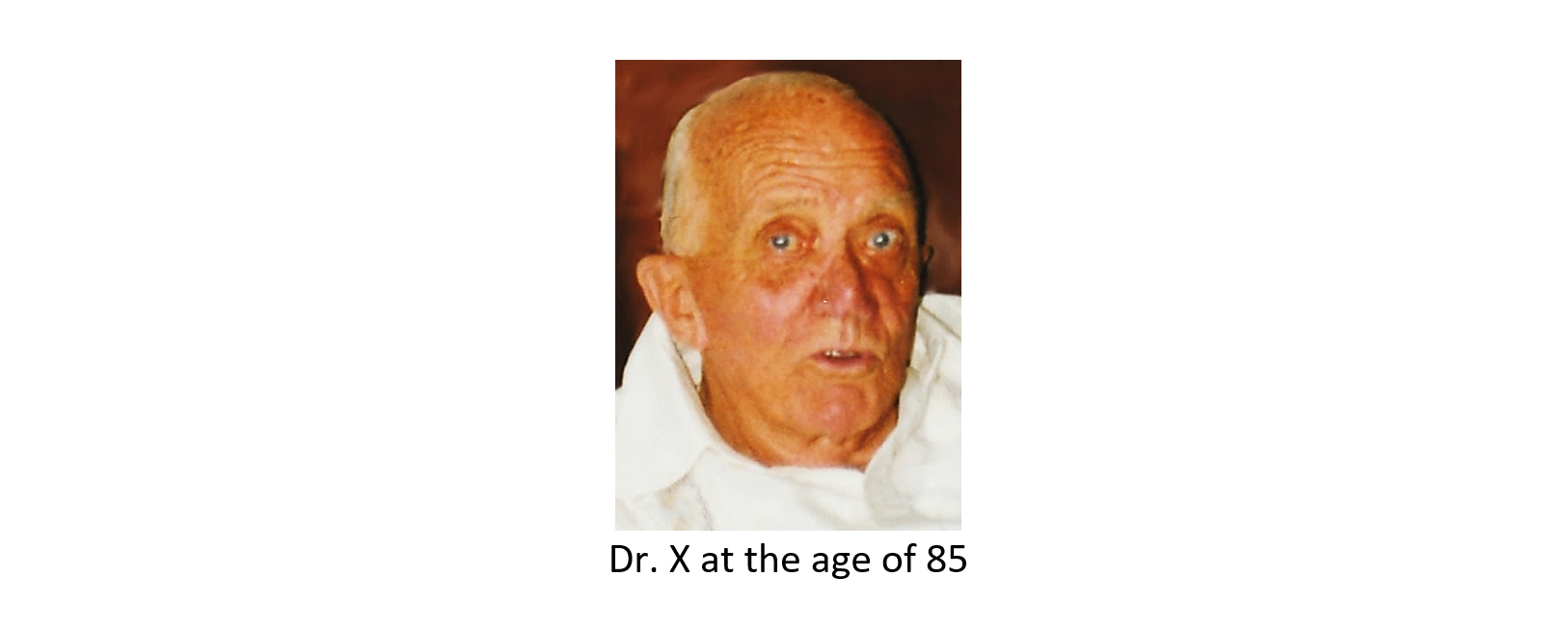
|
|||
|
|
|||
|
In Beijing’s Great Hall of the People
|
|||
|
|
|||
|
The text of my lecture was projected on a very large screen and simultaneously translated. The same was done during the demonstration of my courses. The whole presentation was a great success and eventually led to the translation of my entire curriculum of six courses into Chinese in both simplified and traditional script. |
|||
|
Unfortunately, it proved impossible to take photos inside the
auditorium. However, Prof. Wu Jieping himself was present and
agreed to pose for a “class photo” in a special room reserved
for such purposes. The photo shows him sitting in the front row,
next to him and behind him a select group of several hundred of
our congress participants. My partner and I are also sitting in
the front on the right. The group also included many of my
former hosts during my earlier visits to China. The congress
participants came from all regions of the country. The
enormously large meeting also gave me the welcome opportunity to
meet with three members of my scientific advisory board – Man
Lun Ng (Hong Kong), Fang-fu Ruan (Taiwan), and William Granzig
(USA). For me it was, all in all, the most useful and most
inspiring congress I ever attended.
|
|||
|
In April 2005 my old friend and publisher
Werner M. Linz
invited me and my partner to come to Cairo for the celebration
of his 70th birthday. He had rented a big apartment for us in
his neighborhood (Zamalek), where we could stay for a month. In
the meantime, he had become director of the
American University in Cairo Press,
which he had turned into one of the most important
publishing houses in the Near East. We visited his offices and
met his enthusiastic co-workers, who invited us to join them for
a wonderful outdoor afternoon with their families. We also
explored the most important sites in Cairo, including the
Egyptian Museum with its overwhelming number of priceless
treasures. And I took the opportunity to visit Heba Kotb,
Egypt’s first sex therapist. Quite apparently, her practice was
booming, since I saw many couples in the waiting room of her
office. However, we talked
mostly about her experiences in the US and about
Bill Granzig,
a mutual friend and member of my advisory board. |
|||
|
|
|||
|
My old publisher buddy had made many new friends in Egypt. One of them was Zahi Hawass, the supreme chief of all Egyptian antiquities. With his help and permission, Werner, Gene and I were able to visit all of the most impressive monuments and tombs from Giza to Assuan and Abu Simbel, including many that were closed to the general public. Everywhere we went, we were greatly impressed, but on one occasion Werner, who was already well familiar with the sites, took me aside and led me to a recently excavated tomb some 50 feet deep under the sandy surface. (It was not accessible to tourists, but our special permits allowed us to enter.) We climbed down several ladders and then, in a small burial chamber, saw, behind glass, the perfectly preserved (not mummified) corpse of a young man, nude except for a loin cloth. He was perhaps 18-20 years old when he died a few thousand years ago, but looked as if he had just fallen asleep. Only the color of his smooth skin had turned blue, but his muscles had not shrunk at all. Legs, arms, shoulders, chest, and head had retained their perfect form. I was stunned and deeply moved by this sight. There was no description or explanation of who he was and why he was buried here. Werner was the first to climb back up, leaving me alone for a few minutes sharing a very narrow space with this ancient, youthful body. He had died young and thus had avoided most of “the thousand natural shocks that flesh is heir to”. And thereafter he had escaped the ravages of time until I saw him. It made me shudder in awe. I had never seen anything like it and, to this day, keep wondering about this mystery.
|
|||
|
At the same time I tried to learn something about Hirschfeld’s
stay in Cairo toward the end of his trip around the world.
At the University I had the opportunity to talk with Prof. M.S.
Akabawi, the
Associate Vice President for Computing and Professor of
Information Systems.
Our discussion quickly turned to the subject of
“open
access”
and its consequences for teaching and learning.
We came to the same conclusion:
In the long run, it will be impossible to restrict
scientific knowledge to privileged groups or to sell it as
merchandise.
On the other hand, universities will be able to
attract large numbers of distance students with freely
accessible online courses. This will be especially true of
students from developing countries.
Many of these will also gladly pay tuition and fees if
they can obtain a diploma or degree that way.
Thus, even “free” courses will have no trouble being
financed and making money for the providers. |
|||
|
The university’s very helpful archivists Stephen Urgola then
started an extensive search for possible references to Magnus
Hirschfeld, who had lived in Cairo and taught at the American
University during the winter of 1931-32. Unfortunately, the
university documents from this period were very scanty.
We did find an old university catalogue of the respective
academic year. However, since Hirschfeld did not arrive in Egypt
until after it had been printed, his name is nowhere mentioned.
Still, we did discover that, starting in 1925, the university
had already conducted its own, very popular sex education
courses.
|
|||
|
***
In the meantime, my „open access“ online curriculum of 6 courses
had become well known in other countries. Thus, in December
2005, I received an invitation from Bulgaria and presented a
lecture (in English) at the University of Sofia: “World-wide
Sexual Health – The Growing Role of the Internet”. I then gave
a live demonstration
of my courses. I repeated this presentation at the private
International Healthcare and Health Insurance Institute, also
in Sofia. In both cases I found an enthusiastic audience and a
great eagerness to take advantage of my offer. However, in the
end the necessary translation into Bulgarian did not
materialize. The
financial and social situation of my Bulgarian colleagues was,
and remained,
simply too precarious. |
|||
|
|
|||
|
In March 2006 I celebrated my 70th birthday and, on this
occasion, was invited to present my online courses at the
Goethe-Institute in Atlanta, GA.
The presentation was announced under the title „Transatlantic
Knowledge Transfer – The Growing Role of the Internet“.
I also had the opportunity to introduce a “German
Gay Film Series”,
which started with the Hirschfeld-inspired silent movie of 1919
„Anders als die Andern“
(Different from the Others).
|
|||
|
Following this, I visited two members of my Advisory Board, J.
Linn and F. J. Tombrello, in Birmingham AL. We spent several
days discussing the development of my electronic Archive and the
future of scientific publications in general. The photo shows us
in one of the libraries of the University of Alabama Medical
School, where Dr. Linn was the Executive Director of Medical
Publications.
|
|||
|
From Alabama I flew to California and returned for a brief visit to my former work place, the Institute for Advanced Study of Human Sexuality (see above). |
|||
|
In October of that year, I was visited by
Prof. Liu Dalin
and Dr. Hu Hongxia,
the founders and directors of the
China Sex Museum.
Once again, my Archive and the Museum exchanged valuable gifts
and signed a new, more comprehensive agreement of co-operation.
This agreement confirmed and intensified the exchange between
our two institutions, allowing the mutual non-commercial use of
its electronic resources and other materials. We also agreed to
regular mutual visits in the future.
|
|||
|
In the following year 2007 I received another Chinese
invitation: The Shu-Te-University in
Kaohsiung, Taiwan, asked me to give the opening lecture at a
conference on female health.
I seized the opportunity to meet with the three
Chinese colleagues who had been involved with the translation of
my courses: In Hong Kong, I had a long discussion with Prof. Ng,
a co-author of our
national Chinese sex survey of 1992. The main translator of my
courses, Prof. Peng Xiaohui of
Huazhong-Normal-University in
Wuhan, traveled to Tongli for this occasion, where we could have
intensive talks at the museum of my friend Prof. Liu.
In Kaohsiung I met Prof. Ruan Fang-fu again, an old
friend and, like Prof. Ng, a member of my advisory board.
I was also pleasantly surprised to see another
acquaintance again: Prof. Edwin H. Yen of the National
Taiwan Normal University in
Taipeh. He had visited me in
Berlin a few years before. My
opening lecture “A
Brief History of Female Sexuality“was
well received, and in the following week I conducted a few
seminars at the university, which celebrated its 10th
anniversary that year.
|
|||
|
In addition, in my capacity as an honorary professor, I gave two
workshops at the University of Hong Kong and – together with my
colleagues and friends Prof. Liu Dalin and Dr. Hu Hongxia a few
lectures in Wuxi und Wujiang, People’s Republic.
|
|||
|
As already mentioned, over the years we received many visitors
from all around the world. Here is a superficial list:
Individuals and groups from Argentina, Australia, Belgium,
Bulgaria, Canada, the P. R. of China, the Czech Republic,
Denmark, Egypt, Finland, France, Great Britain, Hungary,
Iceland, Italy, Israel, Japan, Mexico, Netherlands, Nicaragua,
North Korea, Norway, the Philippines, Romania, Russia, South
Africa, South Korea, Spain, Sweden, Switzerland, Taiwan, and the
USA. All of these visitors congratulated us on our achievements,
and some later helped us by adding to our online libraries and
by translating my courses.
|
|||
|
One of these visits, however, had an unexpected consequence:
Prof. Li Yinhe of the Academy of Sciences in Beijing
is the most respected, most popular and enlightened
sexological writer in China today.
Among many other things, she has published an honest,
very moving autobiography describing her marriage to and love
for her transsexual husband, who had formerly been a woman. To
this day, she maintains an internet blog with over 20 million
readers. When she
visited me in Berlin, she offered to recommend my Chinese online
courses to the readers of her blog. Flattered and overjoyed, I
thanked her profusely, unaware of the implications: No sooner
had she written her recommendation, when tens of thousands of
her followers simultaneously clicked on the link to my Archive.
As a result, the server of Humboldt University broke down. The
technical staff blamed this on a
cyber attack
and therefore immediately closed our online Archive. Only many
weeks later, when the Chinese readers had given up in
frustration, did our offer become accessible again.
This episode made clear to me that our university, just
like all the others in Germany, was technically unprepared for a
global role. (At that time, Sebastian Thrun and Peter Norvig
were running an “open access” e-learning course at Stanford
University with 160 000 distance students from around the
globe.) |
|||
|
In spite of such occasional setbacks, I managed to stay in close
touch with my colleagues in China. This did not remain
restricted to the
exchange of lecture invitations and publications, however.
Indeed, over the years, Chinese friends have presented me with
many fascinating gifts, which are now part of the my collections
in the
“Haeberle-Hirschfeld
Archive,
where they are still waiting to be catalogued. There is, for
example, an old bronze statuette of an “erotic Buddha”, as the
Chinese call it , i.e. Buddha (male) and Shakti (female) in the
“yab yum” position, i.e. in sexual union. There is also a large,
very thick volume telling the history of medicine from antiquity
to today in hundreds of postage stamps from all around the
world. And we have a special coin collection commemorating the
50th anniversary of the People’s Republic of China.
The following illustrations show two other examples:
|
|||
|
|
|||
|
***
In April 2008 the EFS congress in Rome invited me to give a
lecture about
eLearning:
„Sexology
in the Internet - Our New Frontier.
(An
Italian translation of my first course
and of several more
courses into Portuguese had already been delivered at the time.)
The congress gave me the opportunity to meet and thank
the translation initiators Prof.
Salvatore Caruso (Catania) and Prof. Antonio Pacheco
Palha (Porto). Unfortunately,
over the next few years, the Italian project was not pursued any
further. Only the
Portuguese translation of all six courses
was eventually completed.
In June of the same year, my
academic life took an ironic turn:
On the same day, the
Wilhelm von Humboldt
Foundation presented both Günter Dörner and me with an award
“for our lifetime
achievements”.
It was an honor we owed to Klaus M. Beier, who, in
the meantime, had solidified his position as director of
Berlin’s only sexological institute.
During the award ceremony at the medical school (Charité),
Dörner and I expressed our appreciation in separate
speeches, recapitulating our very different goals, methods, and
experiences. Both of our
(German) speeches were later published in Beier’s journal „Sexuologie“,
(vol. 15, No. 3-4, pp. 121-127).
I used the opportunity for an appeal to my sexological
colleagues under the title „Das
Bildungsideal Wilhelm von Humboldts in der globalen
Informationsgesellschaft“. It
implored not only the sexologists, but all universities
everywhere to make their research freely accessible in the
internet. However, in Germany this call remained unanswered.
|
|||
|
|
|||
|
In the following year 2009,
Lars-Gösta Dahlöf, the president of the WAS world
congress in
Göteborg, invited me to present a „Hirschfeld
Lecture“,
i. e. a critical evaluation of Magnus Hirschfeld‘s legacy and
its possible meaning for our own future as sexologists. I arrived at the conclusion that, even in his own
time, Hirschfeld had already tried to gain world-wide influence,
and that our present process of globalization gives us an
opportunity to continue his work on a scale he could not have
anticipated and, indeed, that this opportunity is now an
obligation. I then mentioned the efforts we sexologists have
already undertaken, and I finally urged my colleagues to take
advantage of all possibilities offered by the internet and to
join the cause of “open access”.
Sometime later, I added a documentation “Berlin
remembers Magnus Hirschfeld“
to my online library
about the belated rediscovery of Hirschfeld’s work in Berlin
after WW II. |
|||
|
|
|||
|
One fine summer afternoon, our Archive received a very
distinguished visitor - Dr. Giuseppe Vita, the CEO of the
Schering AG, one of Germany’s largest pharmaceutical companies.
(In the meantime, it has become part of the even larger company
Bayer.) He took his time for a guided tour of our offices and to
learn more about the history and potential future of sexology in
Berlin. Very curious and quite impressed by our efforts, he
wished us every possible success. Indeed, with the help of his
public relationship office, Gert J. Wlasich, Schering had
already supported all our DGSS congresses in Berlin since 1990
by donating useful material to our participants (high quality
bags, note pads, pens etc.) Needless to say, Schering also
supported our combined DGSS/EFS congress in 2000.
(17)
In November 2010 my Czech colleagues invited me to come to
Prague, because, in the meantime, they had completed the Czech
translation of my courses. I
was given the chance to demonstrate them in two lectures: 1. At
the Czech Sexological
Society, which awarded me an honorary membership, and 2. for
students of Prof. Petr Weiss at the university’s department of
psychology. In addition, I returned to the
Institute of Sexology,
where I met its director Prof. Zvěřina (a member of my
advisory board,) and Dr. Antoni Brzek, whom I had visited
exactly ten years before. This time, it was a special occasion
for me, because the Institute also translated an
article written in German by Prof. Josef Hynie
for one of my earlier publications.
(18)
Hynie was the director of the world’s first still existing
Institute of Sexology, which traces its beginning to a decree of
1921. In his article, he described his goals and his career,
including his repeated studies at Hirschfeld’s institute in
Berlin. |
|||
|
|
|||
|
|
|||
|
In the following spring I received an unusual request: The Thalia Theater in Hamburg planned a combined performance of both parts of Goethe’s “Faust” as a co-production with the Salzburg Festival. In preparation of this gigantic task, several prominent professors from different disciplines (economics, cultural history, philosophy, and physics) had also been invited. I myself was asked to address the sexological aspects of the play. I spoke from a podium on the rehearsal stage to the director, the actors, musicians, and technical staff. After my lecture, I answered questions and joined in a lively discussion. All lectures were videotaped and parts of them used in the later performances. Excerpts were also printed in the theater programs for Hamburg and Salzburg. To my surprise, the production eventually even came to Berlin and was shown in the large festival theater across the street from our apartment building. Before traveling to Hamburg, however, I had my text printed and bound, together with 10 new caricatures. Thus, I was able to present both the director Nicolas Stemann and his “Dramaturg” Benjamin von Blomberg with a copy of the slim volume. (19) Sometime later, I added the lecture to my online library with 5 “harmless” samples of my caricatures. The other five were too “erotic” for an “open access” web site. (20)
|
|||
|
|
|||
|
When the online version of my lecture on “Faust” was well
received, I felt encouraged to add some of my older brief
satirical variations on ancient Greek myths.
I had written these many years ago when I had first become
familiar with the Richard Strauss operas “Ariadne
auf Naxos”, “Daphne”,
and “Die Liebe der Danae”.
I myself had no great artistic ambitions, but felt tempted to
respond to these masterworks with some modest, capricious
efforts of my own. I simply gave the classic tales a modern,
“enlightened” twist and thus “demythologized” them for my own
amusement. At any rate, I always enjoyed the occasional
opportunities to write something outside my sexological routine
and to make drawings in different styles. Since my
neo-mythological texts are written in German, I just add here a
few of my accompanying illustrations: |
|||
|
|
|||
|
***
A few months later I had a truly exceptional experience: The
World Congress for Sexual Health
in Glasgow 2011 marked
the end not only of one of my more productive years, but of a
whole, important phase of my professional life: I had the
opportunity to see the student dorm again where I had lived
exactly 50 years before together with Scottish and other
students from all around the world. It had been a crucial time
in my academic development, and suddenly I remembered some of my
experiences: The impenetrable winter smog (now gone forever,
thanks to an environmental clean-up), the local television
programs celebrating Scottish culture, my visits to Edinburgh and some
coastal villages, a marvelous “Christmas pantomime” with the
famous Scottish tenor Kenneth McKellar, the traditional, overwhelming New Year’s concert of
Handel’s “Messiah”, my
visits with fellow students to local pubs with their early
closing hours. And I also remembered another, very peculiar,
but, as it seemed, obligatory tradition: There were many
all-male, alcoholic birthday parties inside the dorm where an
invited young “bard” recited -obscene poems and the participants
were getting drunk while loudly singing utterly bawdy songs –
all of this came back flooding back into my memory. In the
meantime, the dorm had been combined with the house next door
and was now being run as a „hostel‘, i.e. as low-priced tourist
hotel. My feelings during this „homecoming“ are difficult to
describe – a sense of deep gratitude and an even deeper
amazement at the course of my life in the preceding
half-century. With ever new surprises and unexpected turns it
had led me more than halfway around the globe – to Hawai’i in
the West and to China in the East. Indeed, as a poor student in
Scotland, I could not possibly have imagined what eventually had
become of me.
I could not help but recall Calderon‘s philosophically profound
drama „La
vida es sueño“
(Life is a Dream). This Spanish classic deliberately blurs the
distinction between reality and illusion in order to convey a
moral lesson: A potentially violent crown prince is brought up
in solitary confinement, where a tutor visits and instructs him
in all relevant fields of knowledge. Once the prisoner has
learned enough, he is subjected to a test: He is drugged into
unconsciousness and brought to the royal court. As he awakens,
he is greeted as the new ruler, but when he loses his temper and
begins to abuse his power, he is drugged again and returned to
his prison. He is then told that he had only been dreaming about
a freedom he had never really possessed. Finally, against the
will of his captors and in a sober state, he is freed again in
the course of a rebellion. However, now he surprises everyone by
showing self-restraint and magnanimity. His experience had
taught him that life itself may be nothing more than a dream,
and that he must always behave responsibly.
Unlike the irascible protagonist of the play, I had always been
peaceful, but there were nevertheless certain parallels.
Both for him and for me, inconspicuous beginnings finally
led to a fulfillment of our true mission: In the first act we
both had lived in oppressive conditions (he was locked up in a
tower; I was trapped in a financially hopeless situation). In
the second act we both were shocked when unexpected freedom was
followed by a sudden reversal of fortune (he was first released
and then imprisoned again; I had started a promising academic
career, but then lost my job and was thrown back into poverty).
Finally, however, in the third act, both of us found our destiny
(he did become a good and merciful king; I became a sexologist –
whether good or bad is for others to decide).
This comparison, involuntary and whimsical as it was, raised an
unavoidable serious question for me:
At the end of the play, the prince had become
wise. But what about me?
Had I also learned something from my experiences?
II was now 75 years old and had officially retired ten
years before. Wasn’t this the time for a general review of my
work, my plans, hopes, failures, and accomplishments?
|
|||
|
|
|||
|
Summary
Looking now at my old regular Archive Telegrams/Archive News,
personal notes and photos, I realize that, in the course of
time, I had been invited to lecture in many different foreign
cities: Philadelphia PA (1983), Shanghai (1989 and 1992),
Beijing (1990 and 1999),
Nanjing (1990 and 1999),
Hong Kong (1990, 1999, and 2007),
Budapest and Miskolc (1990), Paris (1993), Rome (1996), Tianjin
(1999), Hefei (1999), Jinan (1999), Fuyang (1999), Hangzhou
(1999),
Barcelona (2000), La Laguna, Teneriffa (2000, 2001, and 2002),
Fort Lauderdale FL (2001), Sofia (2005), Atlanta GA, (2006),
Wuxi und Wujiang in China (2007), Kaohsiung in Taiwan (2007),
Prague (2010), and Hamburg (2011). (This list does not include
my many lectures in the 1980s on AIDS prevention in Swiss,
Italian, Austrian, and German cities.)
I had also traveled extensively in China and Egypt.
In addition. I had attended sexological congresses in
Copenhagen (1982), Vienna (1983), Caracas (1989), Taormina
(1992),
Reykjavic (1995),
Rotterdam (1996), Marseille (1996), Valencia (1997), Sirmione
(1998), Lisbon (1998), St. Louis, MO (1999), Dubrovnik (2001),
Lüneburg (2002) Brighton (2004), Helsinki (2004), Prague (2006),
Rome (2006), Göteborg (2009), Porto (2010), Glasgow (2011),
Estoril (2012), Madrid (2012), and again in Helsinki (2013). I
do not remember the exact dates, but after the opening of the
Berlin wall, I had also lectured at the universities of Jena and
Greifswald and had been an invited speaker at large congresses
of sexual medicine in Hamburg and Vienna. Beginning in 2003, I
used all of these occasions to introduce and demonstrate my
online sexual health curriculum. |
|||
|
|
|||
|
In their accumulation, these activities attracted international
attention: Over the years, my online Archive received awards
from Chinese, American, German, and Turkish institutions,
organizations and foundations. The most important signs of
recognition, however, were the gold medals of the most
influential international sexological societies. |
|||
|
|
|||
|
While I redoubled my electronic efforts, various new editions of
my textbook continued to sell in large quantities. And this in
spite of the fact that my online Archive made its full text
available in
English,
German, Dutch,
and
Turkish,
and that it had become outdated in some sections. As a matter of
fact, even older editions are still being sold today through the
internet.
|
|||
|
|
|||
|
At any rate, with the beginning of the new millennium, I was
able to take a significant step forward, even after the end of
my official career:
Within a decade, I greatly expanded my steadily growing Archive
and divided it into two parts: A print archive, which I donated
to Humboldt University under the name
Haeberle-Hirschfeld-Archiv, and an electronic archive,
called Archive for Sexology,
which I keep running from my home on a private server at my own
expense. This “open access”
online
Archive now provides sexual health information in 15 languages.
In particular, it contains three special offers:
1. My own sexological dictionary (English)
and
German).
2. A sexological encyclopedia,
originally edited by my Californian colleague
Vern
Bullough.
Shortly before his death, he conferred the editorship to me. I
am now offering a freely accessible digitalized version on my
web site. In its original printed form, it had been the first
and only work of its kind. I am now continuing it according to
his wishes. It still has no competition.
|
|||
|
|
|||
|
3. The world’s first „open
access" Online-Curriculum
The German media also refused to take notice of my work, no
matter how much I tried to attract their attention. More than 10
years later, the newspapers finally wrote for the first time
about
MOOCs as
a surprising development started by some Americans in
Silicon Valley in
2006 or 2007. (Wikipedia also
contains this erroneous
information.)
I wrote my
sexual health curriculum
of 6 courses for interested readers all around the globe, but
especially for students in developing countries.
Therefore, it does not require any previous knowledge,
but explains everything “from the ground up”.
In this respect, it represents the modern form of a
textbook. Indeed, compared
to a traditional textbook, it offers considerable advantages: If
printed, the text with its many internal and external links
would produce a heavy, very expensive volume of several thousand
pages – an impossibility in the college book trade. Furthermore,
in its electronic form, it is easily updated. Finally, it can be
studied everywhere and at all times not only on PCs, but also on
tablets and smart phones. In short, no printed textbook can
compete with an electronic one. It is therefore easy to predict
that the textbooks which are now still in use will not have much
of a future. Sooner or later, they will be replaced by online
courses. This and other developments are part of the present
electronic revolution, which will produce many other radical
changes in higher learning.
As it now turned out, my many lectures in foreign countries and
my participation in international congresses had paid off:
Colleagues from all over the world sent me books and
articles for which they had the copyright, and which I could
therefore make available in my “open access” online libraries.
Other colleagues spontaneously and enthusiastically started
working on the translation of my courses: They asked their
students to translate shorter or longer sections for credit.
(Some produced a translation of a whole course and had it
accepted as their Master’s thesis.)
Obviously, with this global cooperation, we had created a
model for the future. It was
a “win-win
situation”
for everyone involved: The students received their academic
credit, the professors obtained the courses in the language of
their country, and I myself could, once again, enlarge my online
offer. It was a very welcome gift -
something I did not have to pay for out of my own pocket.
In early 2012 I received a polite letter from the university
administration, informing me that it had “neither the expertise
nor the resources” to do justice to my online Archive. I was
therefore asked to find a new provider by the middle of the
following year. Under the
circumstances, this was undoubtedly a fair request, since it
gave me 18 months to organize the necessary move. Anyway, at the
time, I had every reason to be contented: As everyone could see
at the end of 2012, the Archive had registered, for that single
year, over 100 million “hits” and over 4 million “visits” from
over 200 countries. In the month of December alone, we had
counted over 9 million “hits” and over 380 000 “visits” -
more than Hirschfeld’s Institute had seen in all fourteen
years of its existence (1919-1933). Unfortunately, no one in
Germany took notice or drew the logical conclusion. The world
view of my compatriots was still that of the “Gutenberg age”
In the summer of 2013 I answered the university’s request by
moving my online Archive to a private server. I designed a new
logo and removed the name Magnus Hirschfeld from the title. (It
is hardly known in non-Western countries). At the same time,
however, the content I was able to offer continued to grow.
|
|||
|
|
|||
|
Unfortunately, because of our move, we immediately lost 90% of
our visitors. Apparently,
university servers are automatically preferred by search engines
like Bing and
Google. Before, when
searching for “sexology”, we had always been first in over 1,5
million listings; now we were moved all the way down and could
hardly be found at all. Our content could not possibly be the
reason for this, because, to this day, we have no competition in
either quality or quantity. Our online Archive is still by far
the largest and the best in our field. Nevertheless, the search
engines are now listing hundreds of sites ahead of us that offer
only a tiny fraction of our content. Some of them are also
clearly frivolous. (The Chinese search engine
Baidu is still
listing us near the top for searches in Chinese, but for
searches in English it uses the content of
Google.) Quite
obviously then, the Western search engines do not serve the
interests of their users, and it is unclear to me whose
interests they actually serve. Therefore, for me and our still
faithful readers, the present search algorithms remain „a
riddle, wrapped up in a mystery, inside an enigma”. Under the
circumstances, I cannot say at this time, what will eventually
become of my online Archive.
The Future of Sex Research?
Unfortunately, even the undisputed factual knowledge about sex
is still largely unknown to the general public, especially in
countries outside the US and Europe. At the same time, our mass
media have become “sexualized” to an extent that was
unimaginable in my youth. Prime-time television dramas contain
now not only formerly forbidden “four-letter words”, but also
explicit scenes of ”straight“ and “gay“copulation. The most
popular German newspaper prints photos of nude women formerly
restricted to “men’s magazines”. It also recommends that men
should masturbate every day as a preventive measure against
prostate cancer (“Bild “, February 13, 2017). Bestselling books
describe sadomasochistic fantasies, telephone books advertise
brothels, printed and electronic media contain personal ads for
casual sex contacts, advice columns discuss the most intimate
sexual details, large public posters recommend the use of
condoms, etc.. In addition, everyone of any age now has
practically unlimited free online access to all forms of
pornography. (Only the viewing and possession of ”child
pornography“ remains prohibited.) Is this progress? No matter:
All of it is dominated by commercial considerations. ”Sex
sells“
is the merciless motto, which taints all efforts to educate the
world about human sexuality. Thus, even the most “progressive”
message finds itself firmly embedded in its medium’s larger
context of “making money”. Indeed, upon a closer look, the profit
motive seems to be the driving force behind much of our present
“sexual liberation.” Both good and bad go hand in hand, and one
is therefore tempted to speak of a “dialectic of sexual
enlightenment.”
But let us first emphasize the positive:
The increasing commercialization of sex is, at the same
time, an important factor in its liberalization. As more and
more women and men can openly declare their sexual interests,
they can also be targeted as “legitimate” customers. The profit
motive is therefore also a driving force for sexual tolerance.
This increased tolerance has, in the meantime, contributed to a
more relaxed public attitude toward nonconformity and has thus
made life easier for many sexual minorities. And “normal” citizens have also benefitted: Unmarried
couples and their children are finding social acceptance,
teenagers are silently permitted to have active sex lives, if a
couple is childless because of the male partner’s infertility,
it can turn to artificial insemination by an anonymous donor,
etc. Even same-sex marriages or registered partnerships have
found surprisingly little lasting resistance. In short: Many
formerly condemned - and therefore hidden - variations in human
sexual behavior are no longer secret and are being accepted as
socially harmless. However, this commendable acceptance now has
an ugly companion: Surveillance.
An ever-increasing surveillance of all internet traffic
helps businesses to discover more potential customers and thus
to increase their profits. In this sense, we are now living in
an increasingly “open society.”
|
|||
|
|
|||
|
How far this openness will eventually go, is anyone’s guess.
There is no doubt, however, that the already almost ubiquitous
ads will become even more frequent, insistent and bothersome. At
the same time, the surveillance of ever more people could help
the advertisers understand how varied human sexual behavior is
(and always has been), and how little of it is really harmful to
society. This could create additional business opportunities and
thus lead to a further increase in tolerance.
However, the outcome could also be very different: The new
electronic media - and with them their commercial masters - are
steadily gaining access to more and more aspects of our personal
lives, and this, in the end, could have some very unwelcome
consequences. Just by seeking information in the internet for
shopping or travel or by participating in social networks we and
countless others voluntarily provide uncontrolled private
companies with a constantly growing collection of our personal
data. These companies, on their part, sell all of these
collections, representing millions of individuals, as “big data”
to interested parties. After all, their commercial value is
obvious: Accumulated over a longer period of time, they produce
an ever more complete picture of our financial status, our life
styles, preferences, and antipathies (“likes” and “dislikes”).
Most internet users do not realize (or do not care) that, as
they become active online, their individual characteristics are
being recorded by some unseen collector: addresses, birth dates,
levels of education, job history, marital status, number and
ages of their children, preferred clothing, literary and musical
tastes, shopping habits, circles of friends, travels by
automobile, bus, train, and airplane, preferred vacation spots,
leisure activities, hobbies etc. Indeed, very often people also
unknowingly reveal their health data to this hidden collector -
doctor’s and pharmacy visits, types of medication,
hospital stays, eating habits, regular, occasional, or lacking
physical exercise, in some cases even blood pressure, pulse rate
and much more. Over
time, all of these bits of information are being recorded, added
up and used to establish an ever more refined and complete
profile of each user’s personality, and that, by now, includes
all of us. We ourselves do not get paid for our input, but we
are, in fact, creating our own virtual “doubles,” which are
constantly busy making money for other people. Indeed, without
realizing it, we are turning ourselves into merchandise.
At the same time, our Western societies are fast approaching the
age of total surveillance. Its present far-reaching, but not yet
total extent is often experienced as annoying, but still
tolerable, because, so far, it serves only commercial, seemingly
harmless ends. We become aware of it mostly through
“personalized” advertising without thinking much about how the
advertisers found out what we might be inclined to buy. And we
do not yet resent it too much that unknown others are reaping
enormous profits with our personal data. The fact is, however,
that, with every passing day, this constant data collection is
making the collectors richer and more powerful,
and that means that
they are becoming harder to control.
Sooner or later, this worrisome development will raise very
serious questions about its economic and political implications.
These questions are unavoidable, even disregarding the
surveillance by secret agencies and criminal hackers. However, I
cannot discuss this fundamentally important, very complex
question here. Instead, I restrict myself to the limited subject
of my own field: What does all of this mean for the present and
future sex research?
First of all, we should remember not only the advantages, but
also the dangers of privately funded research. It is only
natural and entirely legitimate that large pharmaceutical
companies should try to use neurological and hormonal research
for their own business purposes, even when it is first conducted
by others. (Here, the development of the contraceptive pill is a
classic model.) It is also a fact that private companies have
made important contributions to the healing of diseases and to
the preservation of human and animal health. However,
the matter becomes dubious, when supposedly non-commercial
universities are forced to acquire outside financial support and
thus become dependent on private, profit-oriented donors while,
at the same time, reducing or abandoning research projects of
their own. It becomes even more dubious when, for example,
outside financial interests bolster the questionable trend
toward a ”medicalization of sexual problems“ by creating
products for alleged sexual dysfunctions. When such products are
then promoted with million-dollar campaigns, sexologists will
find it difficult to find a hearing for their critical
scientific arguments. Anyway, it is obvious that an overriding
profit motive is bound to distort any research. It is likely to
overemphasize partial findings and to suppress “inconvenient”
doubts. This will prevent a thorough understanding of the
phenomena under investigation. In the end, only “suitable“
results will determine the discussion and the general state of
knowledge.
Even more problematic is the future of research into human
sexual behavior where we can expect an ever-dwindling influence
of qualified sexologists. It is, of course, unavoidable that our
sexual interests become subject to market analyses: Social
networks and various ”dating
sites“ offer
the first clues to the data collectors, and these clues are
gradually amended by our other personal data. Without going into
much detail, let me simply cite the relatively harmless example
of an American online porn provider: In 2013, this company
analyzed the masturbation habits of its US customers according
to their geographic location, favorite themes, and viewing time
per session (average: 10 minutes). The results
“
were presented in the form of graphic charts and were both
surprising and instructive. When the film
Fifty Shades of Grey
was widely discussed, the same company released new and very
detailed charts showing the suddenly increased demand for
various sadomasochistic practices. Especially interesting and
very well worth studying is
Pornhub’s annual report of 2016,
which covers the entire globe and registers a total of 23
billion visits to its sites. It covers many countries in detail.
These charts can also serve as early examples of something we
might call “automated sex research”: A company owning our
personal data may simply leave it to its computers to generate
all sorts of findings about our most intimate fantasies and
activities and illustrate them with colorful curves, columns,
and pie charts. This kind of instant, “push-button research”
may, in the future, offer nearly endless possibilities. It will
be able to cover all sorts of groups and subgroups in whole
continents or even in the entire world. After all, the amount of
intimate personal data available to commercial companies is
steadily growing. The consumption of online pornography alone
has been shown to be quite extensive and can be assumed to
spread to ever more countries. The smart phone seems to be a
major factor in this development.
And here is another problem: In 2015, internet hackers succeeded
in penetrating an online service for extramarital affairs and
stealing the
personal data of 37 million users
(names, passwords, addresses, credit card and phone numbers) and
making some of them public.
This lead to resignations, divorces, and suicides of customers.
This incidence had many interesting ramifications too complex to
be discussed here. In any case, it shows very clearly that even
very intimate details can be traced back to individual users.
Another problem has recently become apparent when, for political
reasons, social media began to spread “fake news”. Indeed, as
serious scientists are well aware, powerful special interest
groups have, for some time, also been peddling various kinds of
“fake science”, for example denying climate change or -
to talk about our own field
- promoting
“conversion therapy” (from homo- to heterosexuality) or warning
against “sex, pornography, and masturbation addiction”. These
pseudoscientific, but otherwise sophisticated web sites take
great pains to appear “serious” and trustworthy.
Still another problem is the proliferation of “open access”
academic journals. Some of these are themselves “fake” and have
no standing in the scientific community. Some of them are merely
predatory. They accept all submissions, charge their authors
publication fees and simply pocket the money. Some have also
been shown to accept deliberately nonsensical articles as long
as they get paid. Many young scholars, under pressure to
publish, cannot always tell the legitimate from the fraudulent.
In the end, the confidence in all academic publishing will be
undermined. Therefore, we all have reason to worry about the
future. Who, if
anyone, will eventually be accepted as the final arbiter in
these matters? As an American journalist quite aptly put it: “In
the internet we are now all connected, and nobody is in charge.”
Or are there invisible and unsuspected powers behind the scenes,
which are in charge?
Examples like these give us some hints as to what may become
possible in the future. It is even conceivable that marvelous,
unprecedented perspectives could open up for sex researchers.
Still, the question remains: Will they be allowed to conduct the
research?
Unfortunately, the answer is uncertain, because the exclusive
owners of the new sexual data have no motive to share them with
anyone. They have total control over what can be done with them
by whom and und what conditions. Why should they let others
profit from their most precious, income-producing possessions?
Or, to put it another way: Considering the new, extreme
imbalance of power in this field, how can science still play a
corrective role?
Will scientists still find the strength - and the financial
resources - to form a counterweight to the interests of big
business? Will future sex research ever amount to more than
market research?
Will the data owners eventually become immune to any form of
criticism and control? Will their power be used to establish an
all-penetrating, profit-oriented dictatorship? And will this
lead to the “ultimate sexual oppression”? Will George Orwell be
proven right after all?
Will “Big Brother” and his “Big Data” end up confirming
that in the internet “Freedom is Slavery”?
The foreseeable
second end of German sexology
|
|||
|
All of this notwithstanding, over the years I received many
tokens of recognition from colleagues in sexual medicine. I
always accepted these gratefully and was pleasantly surprised
that I - without any medical training of my own - had been able
to make an occasional contribution (invited speaker to medical
congresses, contributor to medical journals, and visiting
professor at medical schools.) Nevertheless, on the whole, the
field of sexual medicine remained within its own self-drawn
borders and did very little to become active in other
sexological fields.
1. Missed paradigm shift
Thus, both the early Master’s program in Hawai’i and my early
decision to write a textbook for it found themselves vindicated.
The same was true of our institute in San Francisco, which, from
its inception, had followed the new WHO recommendations. By
joining the institute’s faculty, I eventually had the chance to
meet every single colleague who had signed the document:
Coenraad von Emde Boas, Preben Hertoft, John Bancroft, Romano
Forleo, Jan Raboch, Willy Pasini, Georges Abraham, John Money,
Paul Gebhard, Mary Calderone and Harold Lief. I could not help
noticing, however, that there were no German signatures. In
Germany, the WHO report and its recommendations were simply
ignored.
2. No "autonomous
discipline"
3. No textbook
4. Ignored sex education
5. Refusal to conduct a national survey
6. Total failure in the AIDS crisis
7. Absence from international congresses
8. Failure to use the Internet
The German universities, also funded by taxpayer money, did not
share this view, however. They felt no obligation to make their
work freely accessible to the general public. For many years,
they offered nothing but their “electronic business cards”, and
these only in German. They showed, for example, their university
seal, or an organization chart of their administration, a list
of its departments and their teaching staff, a description of
their libraries, and sometimes even a catalogue of the current
semester. But they never offered any scientific content. In
short: The readers in Portugal, Peru or Pakistan gained nothing
from these German internet offers, and, for the most part, this
is still true today.
American universities, from the beginning, have followed a
different path: The Massachusetts
Institute of Technology (MIT)
very early on began to offer free online access to the
materials of its courses.
Today, it offers material for over 2000 courses under the name
OpenCourseWare
in 7 languages:
Chinese (2x),Thai, Turkish, Spanish, Portuguese, Persian
(Farsi), and Korean. The offer is now reaching
over 2 million visitors each month from all over the
world. Encouraged by this
success, the MIT
cooperated with Harvard
University in
developing a comprehensive program of “open access”
online courses
under the name edX. In
the meantime, this program has been joined by many other
universities and research institutes in Australia, Belgium,
Canada, China, India, Japan, Korea, Sweden, Switzerland, and
even Germany. The courses
are freely accessible to anyone, but can also be studied for
academic „credit“, if the user pays tuition. The same goes for a
similar large program called
Coursera.
As the actual inventor and earliest pioneer of Massive
Open Online Courses (MOOCs),
I naturally feel vindicated.
The MIT, Harvard, and
the others had realized, albeit a little later than I, that
academic researchers have a moral obligation to share their
knowledge with the world, and that the internet has given them
the means to do it.
This is especially important for the millions of
highly intelligent, highly motivated potential students in the
developing countries, where universities and libraries are
inaccessible for geographic or financial reasons. The success or
failure of these young people will be felt by all of us in the
US and Europe. .
The MIT and
Harvard have, at the
same time, understood that freely accessible courses can produce
considerable income. This,
too, is an often underestimated aspect of the internet.
In a newspaper interview I have once described this
paradox this way: „In the future, only those who give their
knowledge away will be paid for it.”
Therefore, I was extremely disappointed that I could not
find a host for my online
Archive in Berlin. No one in this city was interested in this
truly global project and potential source of profit. Thus, my
most innovative contribution remained unacknowledged and unused
in my own country.
So far, the majority of
German sexologists have not used the enormous potential of the
internet. My own multilingual, globally oriented online Archive
has not inspired any of them to try something similar.
At the very least, they could have made their own old
publications freely available, just as I have done, to say
nothing about new e-learning courses. It must be admitted,
however, that most of their books and papers are written in
German, and that their academic output in other languages is
rather meager. Their colleagues on other continents hardly know
their publications and thus have no motive to translate any of
them into other languages, or to send them their own foreign
language material for an online library.
In the early 20th century, the sexological pioneers
in Berlin had cultivated a multidisciplinary and international,
indeed, global outlook. Not so the present German heirs to their
legacy. They are now leaving the future of their field to the
Canadians, Chinese, Indians, Australians, and Americans (both
North and South). In 1933, the Nazi government had brought a
sudden, violent end to the first, glorious phase of German
sexology. Its now looming second end will not be dramatic at
all, but silent and slow – a
finale morendo, as it
gradually suffocates on its own provincialism. It will simply
wither away and die “not with a bang, but a whimper”.
Concluding remarks
Quite obviously, this offer would not have come into existence
without the enthusiastic, unpaid cooperation of many of my
foreign colleagues. It can
thus serve as a model of global academic cooperation in the
electronic age. I could never have offered my Archive in so many
different languages without the idealism and far-sighted
international orientation of these wonderful colleagues. Their
contributions are invaluable, and it goes without saying that I
am very grateful to all of them. At the same time, some of my
American colleagues have sent me donations for the continuation
of my project. Indeed, in the meantime, I have become totally
dependent on such donations and fervently hope that others in
other countries will soon follow their example.
As a private person, I cannot give academic credit for the study
of my online
curriculum.
Only universities can do that, and, as already mentioned, they
do this in China. What others do elsewhere with the various
translation of my courses I can only guess. As I mentioned
above, the number of visitors to my online Archive has decreased
dramatically since its move to a private server.
Even so, we still have many users in many parts of the
world (the leading dozen in descending statistical frequency):
China, the US, Germany, India, the Philippines, Hungary, Great
Britain, Spain, Czechia, Canada, Mexico, and Brazil.
At the same time, I am well aware of the economic and political
problems associated with the increasing, world-wide use of
MOOCs.
As
early as 2014, I wrote about them on my web site: „Higher
Education for Lower Expectations? …
“.
As I argue in this paper, e-learning on a large scale may have
very negative unforeseen consequences. Unfortunately, to this
day there is no discussion about this among the traditional
German sexologists. However, in December 2013 the Russian
business journal “Expert”
asked me for an
interview
about “open access” and its future implications for academic
teaching and learning. For an English translation click
here.
|
|||
|
|
|||
|
Just to repeat the most self-evident point:
The creators of e-learning courses eventually render
themselves „redundant“, as the British so aptly put it.
Once the courses have been completed and have become
available in the internet, its original creators are no longer
needed. At best,
they can still play a role as advisors or supervisors of
updates, but the actual administration and application of their
courses can easily be turned over to teaching assistants or
„monitors“ with much lower salaries.
Indeed, over time, growing financial pressures will lead
to the elimination of many well-paying teaching jobs and even of
entire university departments. This all the more, since most
universities will not be able to match the quality of Harvard,
Cornell, Yale, Stanford, the MIT and similar “top” institutions.
As a consequence, many “average” universities will cut their
staff and, for their own teaching, rely on the programs offered
by their unbeatable competition. In the final analysis, this can
lead to the closing of whole universities, especially in
developing countries. But even this is by no means the end of
the now inescapable development.
One day the „monitors“ will also become redundant, as
„artificial intelligence“ allows computers to take over their
work. At that time, the
MOOCs will be running in full “automatic mode“, and all tests
and final exams will be administered by machines.
I have no illusions about the importance of my work or, for that
matter, of sexology in general. In the large context of
current world problems, there are many issues more pressing than
studying sexual behavior and promoting sexual health.
Even so, in the years when I was able to profit from a
social and intellectual upheaval in the US, we sexologists, with
our publications, organizations, and congresses, directly and
indirectly contributed to improving the lives of many women and
men. Some of this also
carried over into other countries and even now continues to have
beneficial effects.
Moreover, those turbulent days in the US
laid the groundwork for the electronic revolution, which
is only now reaching a wider public and is about to change the
world in formerly unthinkable, radical ways.
As a side effect, it now allows us sexologists, the „fratres
minores“ of the established academics, to be useful again by
making our knowledge available around the globe in the internet.
However, I do not want to judge any scientific activity by its
usefulness for practical applications. Even the tiniest bit of
knowledge that helps us in understanding the world is
justification enough. Certainly: Without my accidental
sexological insights, my own life would have not have turned out
as happy as it did. But is happiness something useful that can
be planned in advance?
As for my own contribution, I have done what I could under the
circumstances as I found them. At the same time, I have always
taken the initiative and never waited for others to tell me what
to do. Indeed, with official encouragement and support, I
remained a “free agent” even in government service. Therefore, I
have always enjoyed my work. Today I can say that my modest
sexological efforts have rewarded me with a pleasantly varied
and truly fulfilling life. I
am not proud, but contented. Have I accomplished enough? And
will any of it be of lasting value? Sometime in the future,
these questions will have to be answered by others, if they
should still feel so inclined.
EJH, Freiburg im
Breisgau, March 2017 |
|||
|
1.
Haeberle, E. J., Das szenische Werk Thornton Wilders, Carl
Winter Universitätsverlag, Heidelberg 1967
2.
Haeberle, E. J., The Sex Book (with Martin Goldstein and Will
McBride), Herder & Herder, New York 1971
3.
Stewart Brand: We
owe it all to the hippies,
in TIME, Special Issue Spring 1995, Volume 145, No. 12
4.
Tom Wolfe, who, under the guidance of
Norman H. Pearson, had received his Ph.D. in American
Studies at Yale, wrote a satirical report about such a party in
New York: Radical
Chic & Mau-Mauing the Flak Catchers (1970)
5.
Katchadourian A. Herant und Lunde T. Donald,
Fundamentals of Human Sexuality, Holt Rinehart Winston,
New York 1972
6.
Haeberle, E. J., Der verbotene Akt – „Unzüchtige“ Fotos von 1850
- 1950, in: Das Aktfoto: Geschichte, Ideologie, Ästhetik, M.
Köhler, Gisela Barche, eds., C. J. Bucher, München 1985, pp. 240
– 252 .
7.
So far, the following relevant studies have been published:
a.)
Annemarie und Werner Leibbrand, Formen des Eros. Kultur- und
Geistesgeschichte der Liebe, 2 vols. Karl
Alber Verlag, Freiburg/München 1972
b.) Peter
Gay, The Bourgeois Experience: Victoria to Freud, 5 Bde.,
1984-1998,] einschl.
"The Education of the Senses" (1984), "The Tender
Passion" (1986), "The Cultivation of Hatred" (1993),
"The Naked Heart" (1995), and "Pleasure Wars" (1998). Various
American and British publishers.
d.) Volkmar
Sigusch: Geschichte der Sexualwissenschaft, Campus Verlag,
Frankfurt am Main 2008
e.) Vern
Bullough, „Science
in the Bedroom”.
In Spanish translation: „Ciencia
en la alcoba“
f.) My short
history of sexology is available in my
Online
Archive under the title “A
Brief History of Sexology”.
In addition , there is my
Chronology
and some details about several of our our
sexological pioneers.
8.
Bullough, V. L.:
The Rockefellers and Sex Research. In: The Journal of Sex
Research, Vol. 21, No. 2, Mai 1985, S. 113-125.
9. Erwin
J. Haeberle, -, “Prevenzione AIDS: Il punto di vista
sessuologico”, in: Quaderni di sessuologia e scienze
psico-biologiche, I, 1, 1986
10.
Volkmar Sigusch, Hg.: Operation Aids: das Geschäft mit
der Angst. Sexualforscher geben Auskunft, Konkret
Sexualität, Nr. 7, 1986
11.
Erwin J. Haeberle, AIDS-Vorsorge und die Sozialwissenschaften,
in: AIDS geht jeden an: Ergebnisse der Internationalen
AIDS-Tagung im November 1986 in Berlin, ed: Der Senator für
Gesundheit und Soziales, Berlin 1987, pp. 59 - 73, Reprinted in:
Sexualität in unserer Gesellschaft, Bd. II, R. Gindorf, E.J.
Haeberle eds., Walter de Gruyter, Berlin 1989, pp. 85 – 108
12.
As president of the DGSS ,
together with Rolf Gindorf, I organized the following
congresses:
1. „Die Sexualität des Menschen: ein sozialer Tatbestand?“
(Düsseldorf 1984)
With Rolf Gindorf I edited the following publications:
1. Erwin J. Haeberle, (mit Rolf Gindorf) Die menschliche
Sexualität - ein sozialer Tatbestand?, Schriftenreihe
sozialwissenschaftliche Sexualforschung, Bd.I, Walter de
Gruyter, Berlin 1985
2. --, (mit Rolf Gindorf) Sexualitäten in unserer
Gesellschaft, Schriftenreihe sozialwissenschaftliche
Sexualforschung, Bd. II, Walter de Gruyter, Berlin, 1989
3. --, Sexualwissenschaft und Sexualpolitik, Schriftenreihe
sozialwissenschaftliche Sexualforschung, ed. mit Rolf
Gindorf, Walter de Gruyter, Bd. III, 1992, pp. 434
4.--, (ed. mit R. Gindorf), Sexualwissenschaft heute: Ein
erster Überblick, Düsseldorf, Deutsche Gesellschaft für
Sozialwissenschaftliche Sexualforschung, 1992, pp. 71
5.--, (ed. mit R. Gindorf), Bisexualitäten: Ideologie und
Praxis des Sexualkontaktes mit beiden Geschlechtern,
Stuttgart, Gustav Fischer Verlag, 1994, pp. 359
13.
San Francisco has long been a city of opera and opera stars. On
April 17, 1906, the night before the great quake and fire,
Enrico Caruso had sung there the role of Don José
in „Carmen“. The next morning, clad only in pyjama and
bathrobe, he wandered around the smoking rubble and swore never
to sing in the city again, a solemn promise he kept. In 1910. as
San Francisco was being rebuilt, the equally famous Luisa
Tetrazzini gave a free open-air concert on
Market Street.
The present opera house opened in 1932 with Claudia Muzio and
Dino Borgioli in „Tosca“. During our time in San Francisco we
had subscription tickets and thus saw and heard the following
stars, many of them repeatedly and in different roles: Birgit
Nilsson in „Tristan und Isolde“ (with Jess Thomas). Magda
Olivero in “Tosca”.,Joan Sutherland in “Norma”(with Marilyn
Horne), “Semiramide” (again with Marilyn Horne), “Esclarmonde”,
“Merry Widow”. Beverly Sills in “Thais”, “I Puritani”, “Manon”.
Leontine Price in “Aida”, “La Forza del Destino”, “Ariadne auf
Naxos”, Renata Scotto in “Il Trovatore”, “Madama Butterfly”, “La
Gioconda”, “Werther” (with Alfredo Kraus).
Kiri Te Kanawa in “Rosenkavalier”, “Arabella“, “Le Nozze di
Figaro”, “Otello”.
Luciano Pavarotti in “Aida”, “La Bohème”, “Turandot”, “La
Gioconda”, Placido Domingo in “Otello”, “La Fanciulla del West”,
“Carmen”, “Samson et Dalila”, “L’Africaine”, “Hérodiade”. Peter
Hofmann in „Lohengrin“, „Walküre“. Samuel Ramey in „Nozze di
Figaro,“„Don Giovanni“, „La Sonnambula”, „Mefistofele“. Here is
a list of the stars we experienced live on the stage: Soprano:
Sutherland, Sills, Caballé, Scotto, Freni, Crespin, Te Kanawa,
Nilsson, Silja, Olivero, Jones, Marton, Rysanek, Cotrubas,
Riciarelli, Fleming, Tomova-Sintow, Popp, Millo, Battle,
Benackova, Lorengar, Vishnevskaya, Miricioiu, Margaret Price,
Leontyne Price.
Mezzo: Horne,
Cosotto, Verett, Fassbänder, von Stade, Obraztsova, Schwarz,
Troyanos, Zajick, Tociska. Tenor:
Pavarotti, Domingo, Bergonzi, Carreras, Kraus, Aragall, King,
Merritt, Ochman, Bonisolli, Shikoff, Dvorsky, Burrows, Lima,
Araiza, Chauvet, Tappy, Jess Thomas, Peter Hofmann. Baritone:
Adam, Wixell, Evans, Prey, Capucilli, Pons, Bruson, Manuguerra,
Bruscantini, Shimell, Stewart, Diaz. Bass: Siepi,
Ramey, Ghiaurov, Ridderbusch, Moll, Morris, Montarsolo, Tozzi,
Lloyd, Furlanetto, Talvela, Nesterenko, Plishka.
14.
Erwin J. Haeberle, dtv-Atlas Sexualität, Deutscher
Taschenbuch Verlag, München 2005
15.
Haeberle-Hirschfeld Archiv, Humboldt Universität zu
Berlin
16.
About
Dr. X
(in German).
See also
here. Also
see: Martin Bauml Duberman “About time - exploring the
gay past”, New York 1986. The book contains articles
about “Mr.X” in “New York Native 1981-83”. 17. Erwin J. Haeberle, Berlin remembers Magnus Hirschfeld.
18.
Josef Hynie, Zur Geschichte der Sexualforschung in der
Tschechoslowakei, in: "Sexualwissenschaft und Sexualpolitik"
(hg. von Rolf Gindorf und Erwin J. Haeberle), Berlin 1992, S.
91-117, In German. See
here 19. Erwin J. Haeberle, Goethes „Faust“ sexualwissenschaftlich betrachtet. 20. Erwin J. Haeberle, Goethes „Faust“ sexologisch-ironisch betrachtet 21. World-wide Directory, Sexological Training Programs
22.
The most important of these was the American survey:
Edward O. Laumann, John
H. Gagnon, Robert
T. Michael,
and Stuart
Michaels: The
Social Organization of Sexuality, University of Chicago
Press 1994.
K. Wellings , J.
Field , A.
M. Johnson: Sexual
Behaviour in Britain: The National Survey of Sexual Attitudes
and Lifestyles, Penguin Books, 1994, und D. Acheson, Anne M.
Johnson, J. Wadsworth and J. Field: Sexual
Attitudes and Lifestyles, Blackwell
1994.
Curriculum vitae
Publications
|









